https://www.blackgate.com/
Where Dreams and Nightmares Come True: Greyhawk Adventures: Saga of Old City by Gary Gygax


Greyhawk Adventures: Saga of Old City (TSR, October 1985)
Greyhawk…
A cruel city.
A harsh, pitiless city for a young orphan boy with no money and no friends — but plenty of enemies!
Enter the Old City of Greyhawk, that marvelous place where dreams — and nightmares — come true. Travel through the world of Oerth along with Gord, the boy who becomes a man as he fights for his survival in a world of mysterious wizards, fearsome monsters, dour dwarves, and beautiful women.
[Click the images for Greyhawk-sized versions.]
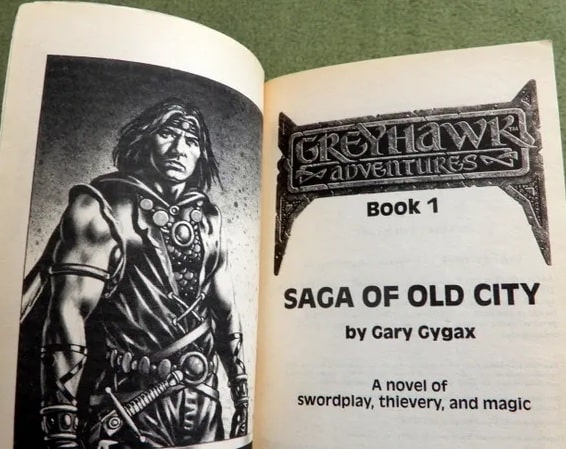
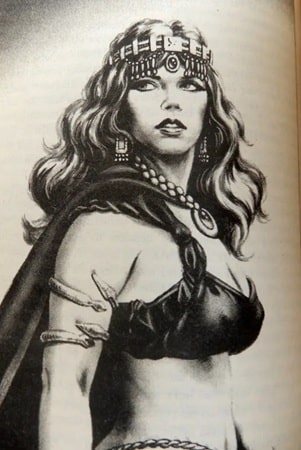
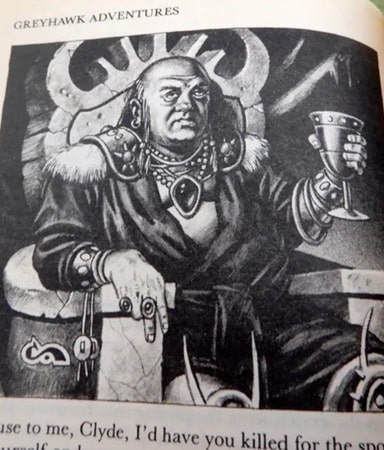
Interior art for Saga of Old City by Clyde Caldwell
For Oerth is a world where a man’s eyes always watch the shadows… and a man’s hand is always on the hilt of his dagger.
Here, at last, is adventure enough to last a lifetime — perhaps a very short lifetime!
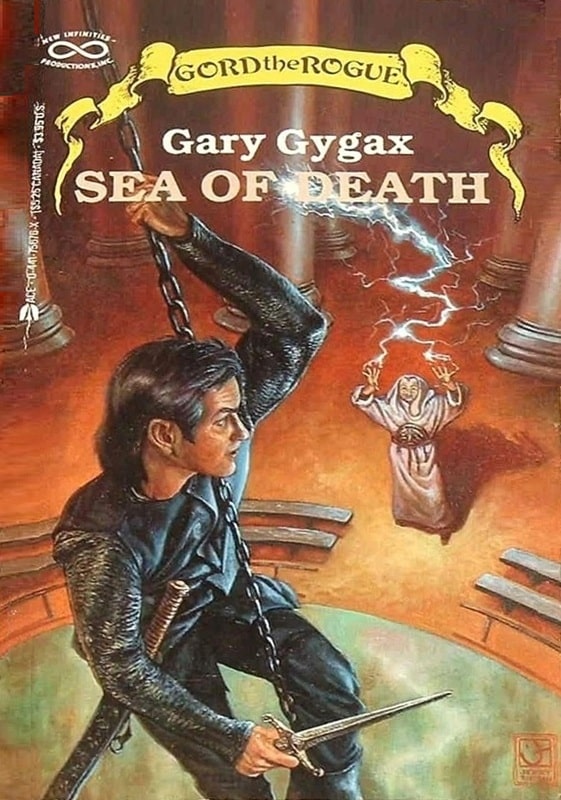
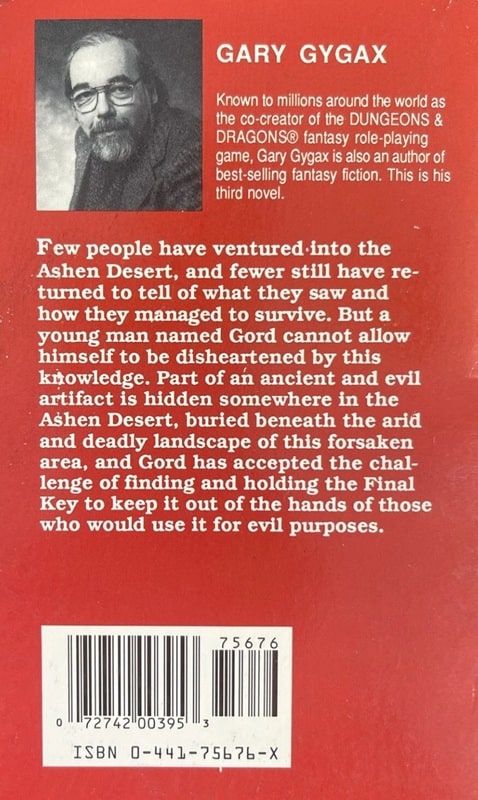
Gord the Rogue #1: Sea of Death (New Infinities Productions, June 1987). Cover by Jerry Tiritilli
Such fond memories of the Gord the Rogue series, by the incredible Gary Gygax. I think my favorite was Sea of Death. Gary was definitely inspired by his pal, Fritz Lieber, as Gord the Rogue was a lot like The Gray Mouser.
Jeffrey P. Talanian’s last article for Black Gate was a look at the Dragonslayer RPG by Greg Gillespie. Jeffrey is the creator and publisher of the Hyperborea sword-and-sorcery and weird science-fantasy RPG from North Wind Adventures. He was the co-author, with E. Gary Gygax, of the Castle Zagyg releases, including several Yggsburgh city supplements, Castle Zagyg: The East Mark Gazetteer, and Castle Zagyg: The Upper Works. Read Gabe Gybing’s interview with Jeffrey here, and follow his latest projects on Facebook and at www.hyperborea.tv.
You Can’t Handle the Tooth, Part III
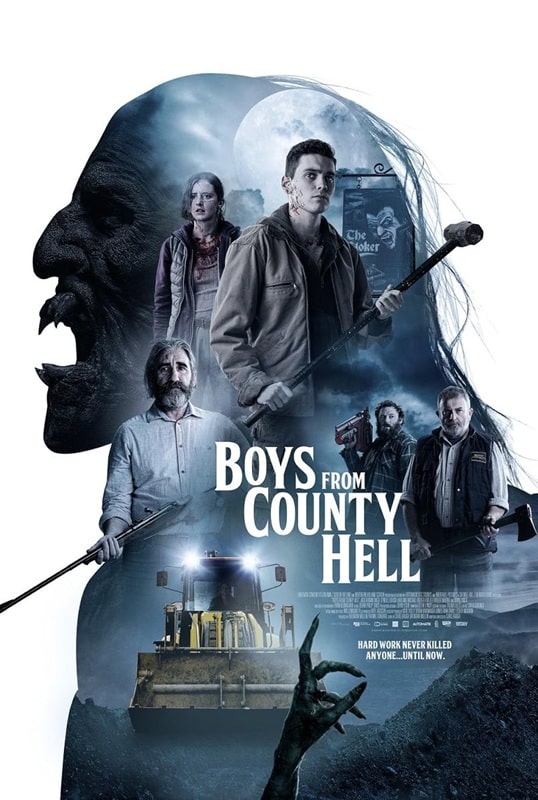

Boys from County Hell (Six Mile High Productions, April 2020)
and Twilight (Summit Entertainment, November 21, 2008)
20 vampire films, all first time watches for me.
Come on — sink ’em in.
Boys from County Hell (2020) – Prime/ShudderAh, British and British-adjacent horror comedies. When they’re done right, there’s nothing better, and this one is done right.
I had a blast with this one, I’d put it right up there with the likes of Dog Soldiers, Grabbers, Shaun of the Dead, Doghouse, Severance, and The Cottage. They all have something in common; a close-knit group, localized setting, extreme gore, and flowery language.
This one takes place in Northern Ireland in a verdant county of farmers, builders and heavy drinkers. Moffat & Son are construction workers, tasked with paving the way for a hugely unpopular bypass that is not only going to tear up some fields, but will also destroy a long-standing cairn said to be the resting place of a vampire. The legend hangs so thickly in this county that Bram Stoker himself was influenced by it when passing through, and was compelled to write a book. Indeed, the local pub is called the Stoker and garnished with Spirit Halloween props to draw the tourists in.
Naturally, once the cairn is indeed demolished, all hell breaks loose, and the Moffats, along with their friends and colleagues, must survive the night against a terrifying entity.
The horror is indeed horrific, with the usual viscera spiced up with some truly ghastly blood weeping (from every orifice), and Robert Strange (known for orcs and aliens) is suitably creepy as Abhartach, the vampire. The rest of the cast is stellar, with my personal favorites being Nigel O’Neill (Mandrake) as Francie Moffat, and Louisa Harland (Orla in Derry Girls) as Claire, although I don’t want to downplay the rest of the players — everyone was spot on and their dialogue cracked me up several times.
Really enjoyed this one — highly recommended.
9/10
Twilight (2008) – PrimeI guess this watch-a-thon is as good a time as any to view this one, a film as adored as it is vilified. I really don’t have any strong feelings either way about this film; I didn’t think it was very well made, but I didn’t hate it, so I think I’ll just address the big issues that swirled around it at the time.
Sparkly vampires: Meh, not a deal-breaker. I actually didn’t mind this idea as it was in keeping with Stephanie Myer’s new vampire mythology. I wasn’t a big fan of all the brooding though — definitely a case of too many surly faces.
Rob Patts and Kris Stew: I really like these two — Pattinson was my favorite actor in 2019 (The Lighthouse), and Stewart has been solid from Underwater onward. However, in this film they are not directed well and come off as overly miserable, more than they needed to be.
Team Jacob: Ah, bless him.
Vampire skills: The super-speed and wire work were awful (SFX-wise), especially for a 2008 film. And I didn’t see a single fang. Boo.
The tone: Hated the colour-grading, Catherine Hardwicke’s direction was bafflingly stuffed with nonsensical camera moves, and the editing was dire. Stilted, awkward dialogue. Also, dull narration.
Good points: I really liked the dynamic between Bella and her estranged dad (Billy Burke, excellent), and of the Cullens Alice (Ashley Greene) was fun.
I am fully aware that I’m not the intended demographic for this film, but there have been plenty of other YA romance flicks with supernatural elements that I have enjoyed a lot more.
Oh well, crossed off the list.
6/10


Humanist Vampire Seeking Consenting Suicidal Person (H264, September 3, 2023)
and You Shouldn’t Have Let Me In (Alenu Entertainment, March 15, 2024)
This is a French Canadian film, as is evident by the liberal use of subtitles and poutine.
Sasha is a teenage (68) vampire, part of a loving family who are concerned that she still hasn’t killed her first human. Problem is, Sasha doesn’t want to. She gets sick at the idea, and prefers to slurp from blood bags while brooding around town in the evenings. Eventually her family intervenes, and she is sent to live with her more bloodthirsty cousin in the hope she can be weaned off the bags and onto jugulars.
Sasha is having none of it, and continues to despair, until she runs into a young man who is tired of life. This is Paul, a lonely and picked-upon high schooler with a fondness for rocks and a personal bully who fills his shoes with queso. Sasha and Paul appeal to each other’s plight, and a plan is hatched to help Paul fulfill his final wishes before Sasha finally earns her fangs.
This film is a vibe. By which I mean if you like awkward non-romances with furtive glances, unsubtle metaphors, sitting on the edge of beds, symmetrical compositions, good lighting, a great soundtrack, and the occasional neck-nibble, this is for you. Did I mention it’s hilarious? Well it is, in a gently dark way. Its look is simultaneously harsh and dreamlike, and the two leads (Sara Montpetit and Félix-Antoine Bénard) are perfect (if this was remade in the U.S., the leads would be Kristen Ritter and Nicholas Hoult).
I loved it — but your experience may differ.
9/10
You Shouldn’t Have Let Me In (2024) – TubiAwkward title aside, this has all the tiresome social media subplots you would expect from a 2024 film. A bunch of old friends meet up somewhere in Italy for Rochelle’s wedding to Richard, former boyfriend of main protagonist Kelsey. Kelsey has arrived with her gay best friend, Blake, and they join Rochelle and bachelorette party organizer Jenny on the beach. Kelsey isn’t wearing the right attire to be in any of their photos (Rochelle has her 123 million followers to think of) so she wanders off into town where she meets Gianni, the resident Van Helsing, who warns her of ‘evil’ and gives her Chekov’s pendant.
Of course, Kelsey meets Victor (do vampires have any other names? I’d love to see a vampire called Nigel), who is the owner of the villa they are all staying in. Absurdly, Victor has to wait for them to invite him into the building he owns, and from that moment on, he pursues Kelsey (who is the spitting image of his centuries-old lost love) while the others scramble about.
It’s all extremely unoriginal and tiresome. Rochelle doesn’t want to call the cops (after finding her murdered friend) because that will impact her follower count, Blake just wants to get into Gianni’s pants, and Victor is the least charismatic count I’ve ever seen, all blinding white teeth and Jason Priestly hair.
There are parts that I enjoyed; the direction is decent, the setting is suitably gothic, and Kelsey and Blake are quite fun to watch, but overall it’s a bit of a Mills & Boon arm-chewer.
5/10
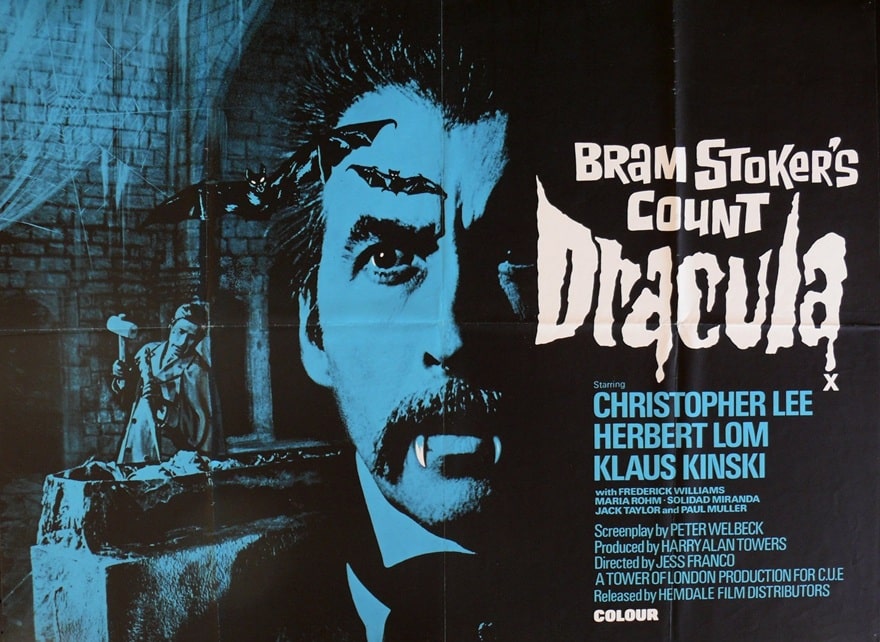 Count Dracula (Hemdale, 1970)
Count Dracula (1970) – Tubi
Count Dracula (Hemdale, 1970)
Count Dracula (1970) – Tubi
Billed as a slavish reenactment of the original Bram Stoker novel, Jess Franco’s take on the story reveals why Dracula works better when it’s adapted with a little pzazz. True, Coppola also stuck closely to the original text, but he was wise enough to sprinkle in plenty of hot actors, rampant knockers, and Tom Waits.
This version, faithful as it is, is rather dull and (somewhat appropriately) lifeless. Big Chris Lee takes it all very seriously, and you can tell this film was important to him after the lurid camp of his glorious Hammer films (which he wasn’t finished with), but this results in a limp-fanged count with barely any physical presence. Herbert (Phantom of the Opera) Lom is fine as Van Helsing, and Klaus (Nosferatu) Kinski was an inspired choice for Renfield, but neither actor was really let off the leash and allowed to demonstrate their natural nuttiness.
Despite some distracting crash-zooms and swish-pans, the film looked quite nice given its abundance of spiders and webs, and I did enjoy Bruno Nicolai’s score, but when all’s said and done, this one was about as memorable as a digestive biscuit.
5/10
 El Conde (Netflix, September 15, 2023)
El Conde (The Count) (2023) – Netflix
El Conde (Netflix, September 15, 2023)
El Conde (The Count) (2023) – Netflix
What a way to end this project. Pablo Larrain, a Chilean director known previously to English-speaking audiences for biopics such as Jackie and Spencer, returns to a subject he previously dissected in an earlier film, No, the subject being Augustus Pinochet, the military dictator of Chile from 1973 to 1990.
However, rather than a narrative formed from the facts of Pinochet’s attempts to cling to power, El Conde takes place in a surreal alternate universe where Pinochet is a centuries-old vampire who has finally grown weary of immortality. His offspring are gathered to his remote estate, along with his wife and man-servant, to discuss his final plans for the division of his ill-gotten gains, but the accountant that has been hired to help is secretly a nun assassin, ready to drive the demon from his soul.
Bickering leads to bloodshed and loyalties are trampled underfoot as the elderly patriarch both yearns for death but also takes off at night to find new victims to sate his taste for heart smoothies (quite literally). It’s as weird as it sounds, and it just gets weirder, especially in the third act when another political figure appears on the scene (there’s a reason why the English narration sounds like Maggie Thatcher).
The film itself, shot in stark black and white, was nominated for an Oscar for cinematography, and it’s easy to see why. Everything, from the use of lighting to the shot compositions, is sublime, and the acting is great all round, not least from Jaime Vadell as the elderly monster.
9/10
Previous Murky Movie surveys from Neil Baker include:
You Can’t Handle the Tooth, Part I
You Can’t Handle the Tooth, Part II
Tubi Dive
What Possessed You?
Fan of the Cave Bear
There, Wolves
What a Croc
Prehistrionics
Jumping the Shark
Alien Overlords
Biggus Footus
I Like Big Bugs and I Cannot Lie
The Weird, Weird West
Warrior Women Watch-a-thon
Neil Baker’s last article for us was Part II of You Can’t Handle the Tooth. Neil spends his days watching dodgy movies, most of them terrible, in the hope that you might be inspired to watch them too. He is often asked why he doesn’t watch ‘proper’ films, and he honestly doesn’t have a good answer. He is an author, illustrator, teacher, and sculptor of turtle exhibits. (AprilMoonBooks.com).
Tor Double #10: Robert Silverberg’s Sailing to Byzantium and Gene Wolfe’s Seven American Nights
 Cover for Sailing to Byzantium by Brian Waugh
Cover for Sailing to Byzantium by Brian WaughCover for Seven American Nights by Bryn Barnard
Seven American Nights was originally published in Orbit 20, edited by Damon Knight and published by Harper & Row in March, 1978. It was nominated for the Hugo Award and the Nebula Award. Seven American Nights is the first of two Wolfe stories to be published in the Tor Doubles series.
Sailing to Byzantium was originally published in Isaac Asimov’s Science Fiction Magazine in February, 1985. It was nominated for the Hugo Award and the Nebula Award, winning the latter. Sailing to Byzantium is the second of five Silverberg stories to be published in the Tor Doubles series and aside from the proto-series Laumer novel, it is the first time an author has been repeated.
Wolfe’s story opens with a short note from Hassan Kerbelai indicating that he is sending the travelogue of Nadan Jaffarzadeh back to his family, noting that Jaffarzadeh seems to have gone missing. The final paragraphs of the story are focused on Jaffarzadeh’s mother’s reaction to the travelogue. The majority of the story is Jaffarzadeh’s description of his first week visiting America.
The American Jaffarzadeh is visiting, however, is one in which the United States failed generations earlier. The Washington, D.C. he travels through is referred to as the Silent City, containing the remnants of the great federal buildings. Although he travels through the ruins and visits a park that he warns is dangerous, the majority of his time in Washington is spent attending the theatre.
During his first day of touring, he notices a man working in one of the buildings in the silent city. He runs into the man at the theatre and learns that he is working on a machine that can emulate handwriting, essentially what we would recognize as an AI with an autopen ability.
After that early visit to see a production of Gore Vidal’s Visit to a Small Planet, he develops an infatuation for the leading lady, Ardis Dahl. That infatuation drives the remainder of the narrative as he begins to stalk her, attending subsequent nights at the theatre, trying to find where she lives, and eventually meeting one of the other actors, Bobby O’Keene, who offers to introduce Jaffarzadeh for a price. When O’Keene tries to pick Jaffarzadeh’s pocket, the police become involved, O’Keene is arrested, and eventually, Dahl tracks down Jaffarzadeh to get his help releasing O’Keene.
The story is told in the form of Jaffarzadeh’s journal, beginning with his arrival aboard a ship and ending after he begins a relationship with Dahl. However, Wolfe introduces several subtle clues throughout the story, in his choice of plays, the descriptions of characters, and incongruities in the way Jaffarzadeh describes things, that indicate that the seemingly straightforward tale is much more convoluted that it would appear.
Upon reading the story, it appears that Jaffarzadeh is somehow the victim of a scam perpetrated by the acting troupe, possibly in conjunction with the manager of the hotel who first sent him to the theatre. However, Wolfe’s choice of plays, one that deals with a traveler attempting to provide a war, the other about a woman who vanishes, indicate that something far more sinister is taking place. Two of Jaffarzadeh’s fellow passengers to America make appearances late in the story. Are they part of the plot? Are the police involved? What about the functionary who sent the journal on to Jaffarzadeh’s family? Wolfe doesn’t offer any real answers and the text, itself, can offer up a Rashomon-like series of answers, none of them more correct than the others.
Seven American Nights feels incomplete. Not only does Wolfe not provide answers to the many questions that are implied, but rarely stated, but he ends the story with Jaffarzadeh’s mother’s not knowing his fate, but knowing he is alive. The reader, on the other hand, is not so sure. Even if Jaffarzadeh can be trusted, and by his own words he notes that he hasn’t included the entire story and has removed pages, the possibility that someone else, possibly even the machine his friend was working with, wrote parts of the journal mean it cannot be trusted.
The described arrest of O’Keene after he tried to pickpocket Jaffarzadeh, in which it is clear that if Jaffarzadeh doesn’t swear out a complaint, the police will arrest him anyway and trump up the charges, coupled with the inability to discover where he is being kept or what happened to him, has chilling parallels with the current situation in which ICE is arresting people and deporting them without due process. Within the context of the story, it also sets the expectation that if the authorities determine that Jaffarzadeh must be removed, there is nothing that anyone could do to stop them or reverse his arrest.
The strength of Seven American Nights is the very infuriating ambiguity with which Wolfe has carefully laced the story.
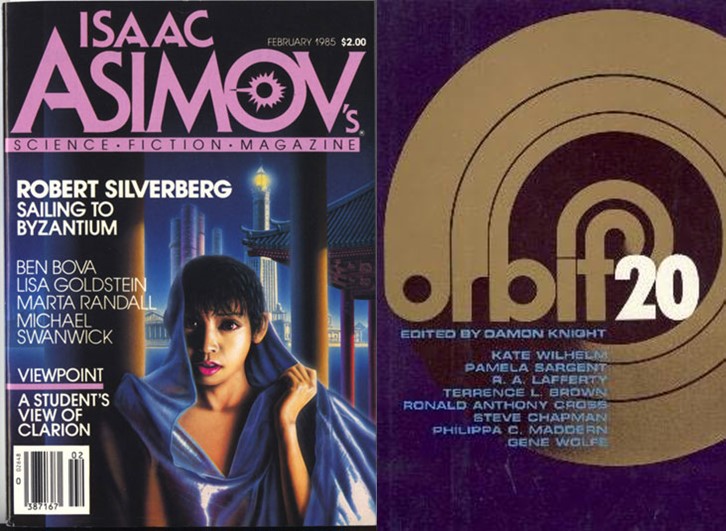 Issac Asimov’s Science Fiction Magazine February 1985 cover by Hisaki Yasuda
Issac Asimov’s Science Fiction Magazine February 1985 cover by Hisaki YasudaOrbit 20 cover by an unknown artist
The strength of Seven American Nights is the very infuriating ambiguity with which Wolfe has carefully laced the story.
Silverberg’s world of Sailing to Byzantium is reminiscent of the fin du siècle decadence of Michael Moorcock’s Dancers at the End of Time, which I recently re-read. While Moorcock viewed the world of ever-changing landscape from the point of view of one of the period’s denizens (or citizens as Silverberg calls them), Silverberg’s protagonist, is in the time traveling role of Moorcock’s Mrs. Amelia Underwood. This change makes Silverberg’s world more interesting since it allows the story to offer its own contemporary judgement of the citizens’ self-indulgence.
Of course, Silverberg’s story shares its title with a poem by William Butler Yeats in which Yeats also explores the concepts of immortality, art, and the idea of a paradise. Silverberg has selected as his point of view Charles Phillips, who, without knowing how or why, has been pulled from twentieth century New York to this new world. Phillips moves from city to city accepting of the immortality which seems to exist for the citizens and trying to find his own place among the glories or the past recreations.
When the story opens, he is visiting Alexandria at its height, exploring the Pharos and the library in the company of his lover, Gioia. During this visit, Phillips shares with the reader what he knows of this world. The population of citizens numbers in the low millions. Only five cities exist at any time and they are recreations of historic cities, at the moment the novella begins they include New Chicago, Alexandria, Changan, Asgard, and Timbuctoo. Eventually one of those cities will be dismantled and replaced with another city. These citizen are staffed by “temporaries,” sort of synthetic humans or automatons, Phillips isn’t entire sure.
Even as he enjoys the climb to the top of Pharos, he yearns for a Byzantium which hasn’t been built, but which he is sure will be in time. Before it can be, he and Gioia travel to Changan to enjoy the court of the Chinese Emperor. Their visit there is made more memorable by the fact that Gioia’s friends have arranged from them to be treated as honored guests by the Emperor. During their visit, Phillips begins to see the world beyond the façade. When the Emperor, who is merely a temporary, is not actively engaging, he practically seems to turn off.
The real surprise comes we he sees signs of aging in Gioia, something that shouldn’t happen to the immortal citizens of this era. Gioia leaves him, but arranges for him to have a friend, Belilala, as a companion. Unable to understand what is happening, Phillips chases after Gioia, learning from Belilala that Gioia is a rarity, a citizen who can age and die. Phillips chases after Gioia, despite her stated desire not to see him, reminiscent of Silverberg’s own Born with the Dead, which was the first of Silverberg’s novels to be reprinted in the Tor Double series.
Phillips quest of Gioia introduces him to two other visitors such as himself. The first, Francis Willoughby, is from the late sixteenth century and can’t fathom of the world of miracles Phillips attempts to describe them living in. He is convinced he was simply drugged and dragged to an India ruled by Portuguese (they meet in a recreation of Mohenjo-daro, which replaced Timbuctoo). The second visitor Phillips meets is from a period in his future. Y’ang-Yeovil of the Third Septentriad. Y’ang-Yeovil reveals more about the mechanics of the world, and the manner in which visitors are brought into it, causing Phillips to have an identity crisis of his own.
Eventually, Phillips is able to confront Gioia about her desertion of him and her own aging. While Phillips may be a minority as a visitor, Gioia is a very different type of outsider. A citizen, her recessive trait that causes her to age means that she is still seen as an outsider with little recourse or others who share her affliction. Phillips actually quotes the Yeats poem and Byzantium becomes a promised land where a solution to her affliction might become a possibility, allowing Gioia and Phillips to have a life together without worry of out-aging the other.
The world Silverberg built is a strangely ephemeral world in which the only permanence are its citizens. He focuses on two individuals who lack the immortality that almost everyone else in the world enjoys, and each of them must figure out how to come to terms with that fact in their own way, both coming from very different places. Although it doesn’t seem likely, their story introduces true affection into the world.
Some of the novellas collected in any given volume of Tor Double have links to each other. In the case of this book, both the Wolfe and Silverberg novellas are travelogues of a future earth, with Wolfe exploring the remnants of a post-US Washington and Silverberg looks at a future world that recreates the past.
The cover for Sailing to Byzantium was painted by Brian Waugh. The cover for Seven American Nights was painted by Bryn Barnard.
 Steven H Silver is a twenty-one-time Hugo Award nominee and was the publisher of the Hugo-nominated fanzine Argentus as well as the editor and publisher of ISFiC Press for eight years. He has also edited books for DAW, NESFA Press, and ZNB. His most recent anthology is Alternate Peace and his novel After Hastings was published in 2020. Steven has chaired the first Midwest Construction, Windycon three times, and the SFWA Nebula Conference numerous times. He was programming chair for Chicon 2000 and Vice Chair of Chicon 7.
Steven H Silver is a twenty-one-time Hugo Award nominee and was the publisher of the Hugo-nominated fanzine Argentus as well as the editor and publisher of ISFiC Press for eight years. He has also edited books for DAW, NESFA Press, and ZNB. His most recent anthology is Alternate Peace and his novel After Hastings was published in 2020. Steven has chaired the first Midwest Construction, Windycon three times, and the SFWA Nebula Conference numerous times. He was programming chair for Chicon 2000 and Vice Chair of Chicon 7.
Vintage Empires: James Nicoll on Galactic Empires, Volumes One & Two, edited by Brian W. Aldiss
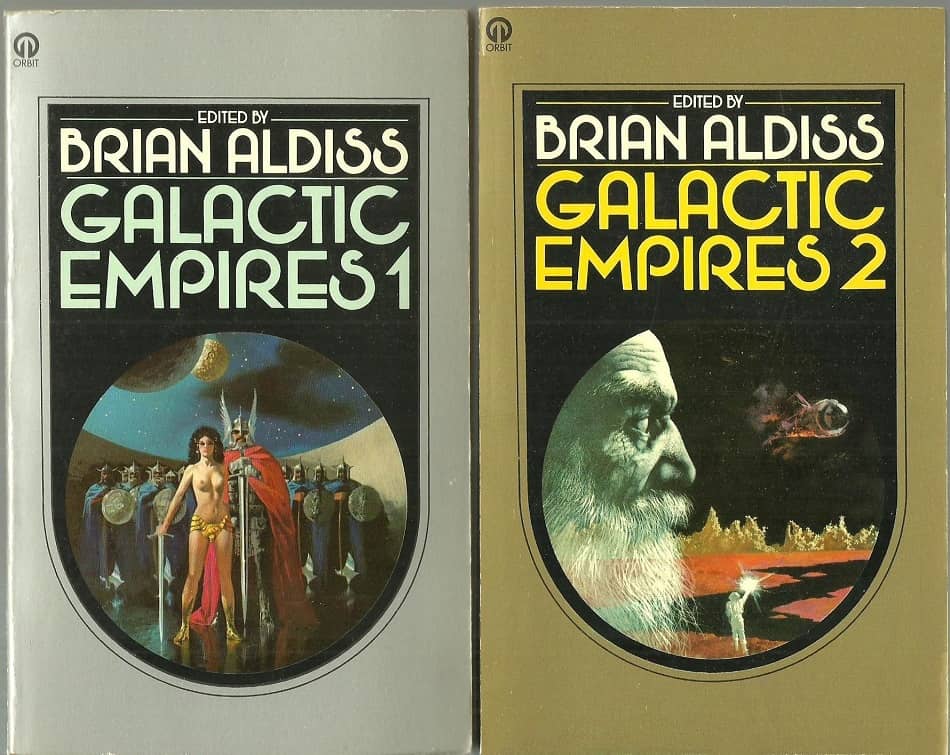 Galactic Empires, Volume One and Two (Orbit, October 1976). Covers by Karel Thole
Galactic Empires, Volume One and Two (Orbit, October 1976). Covers by Karel Thole
My fellow Canadian James Nicoll continues to be one of my favorite SF bloggers, probably because he covers stuff I’m keenly interested in. Meaning exciting new authors, mixed with a reliable diet of vintage classics.
In the last two weeks he’s discussed Kate Elliots’s The Witch Roads, Axie Oh’s The Floating World, Ada Palmer’s Inventing the Renaissance, and Emily Yu-Xuan Qin’s Aunt Tigress, all from 2025; as well as Walter Jon Williams The Crown Jewels (from 1987), Wilson Tucker’s The Long Loud Silence (1952), C J Cherryh’s Port Eternity (1982), and John Brunner’s 1973 collection From This Day Forward. Now that’s a guy who knows how to productively use his leisure time. Not to mention caffeine.
But my favorite of his recent reviews is his story-by-story breakdown of Brian W. Aldiss’s massive two-volume anthology Galactic Empires, which made me want to read the whole thing all over again.
James opens by reprinting the famous letter Ursula K. Le Guin sent to Harcourt senior editor John Radziewicz, when she was asked to provide a blurb for Volume 1 of George Zebrowski’s new anthology series Synergy: New Science Fiction. It didn’t go well.
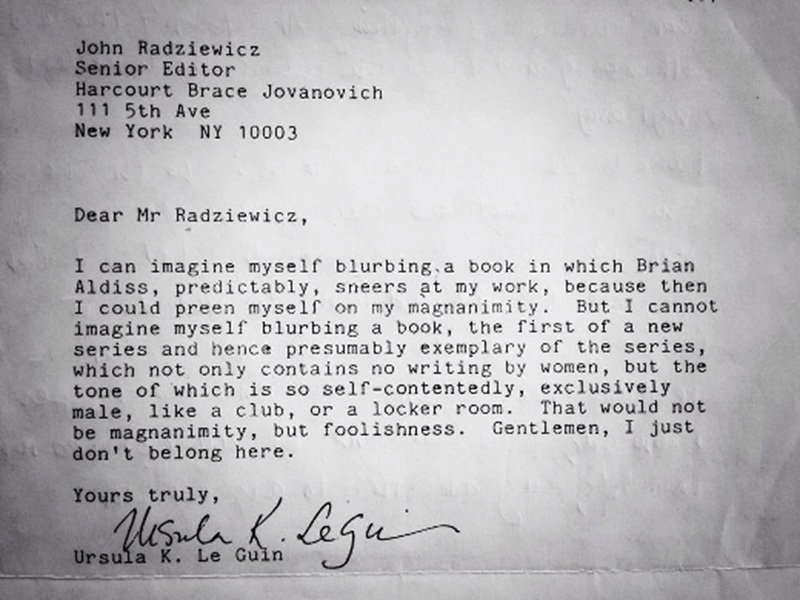 Ursula Le Guin letter to Harcourt senior editor John Radziewicz
Ursula Le Guin letter to Harcourt senior editor John Radziewicz
As James notes,
Modern readers might be surprised at the almost complete lack of women in the two volumes (or they would be, if the books were not long out of print). Older readers, aware of Le Guin’s response to a later Aldiss-helmed anthology, will be less surprised.
On to the stories.
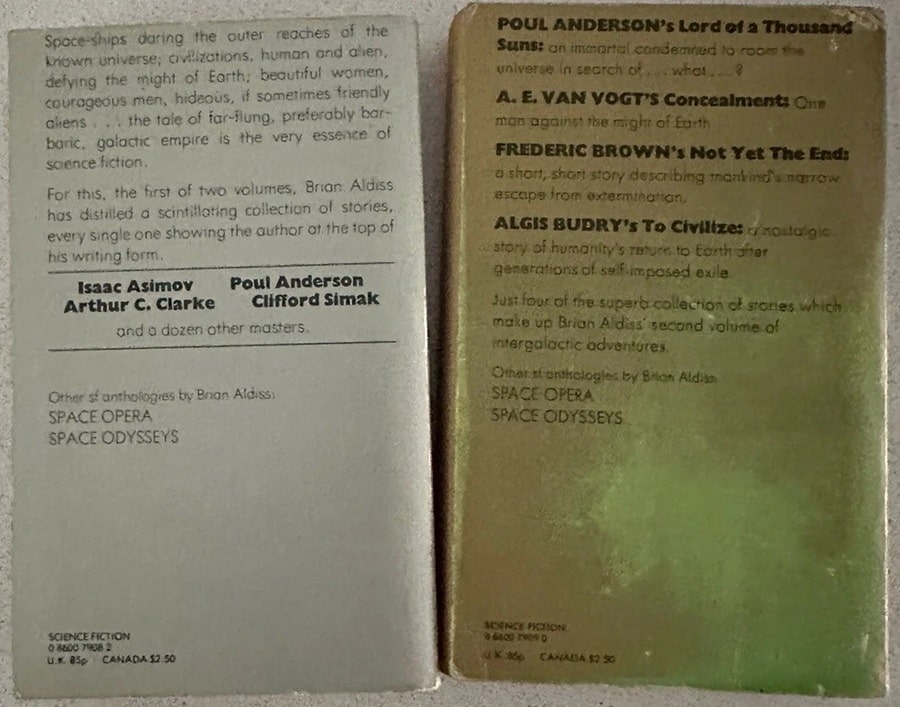 Back covers to the Orbit paperback editions of Galactic Empires, Volume One and Two
Back covers to the Orbit paperback editions of Galactic Empires, Volume One and Two
James covers every one of the stories in this massive anthology. Here’s the highlights.
VOLUME ONEI remembered Volume Two as the stronger of the two. That’s not quite correct. Both have their weak stories (“Foundation,” in the absence of other material, “Escape to Chaos,” not to mention that terrible van Vogt story) but both have works such as “Brightness Falls from the Sky” and “Final Encounter” that I enjoyed encountering again…
“The Star Plunderer” • (1952) • novelette by Poul Anderson — a Technic History story
Alien slavers descent on decadent, weak Earth, little suspecting that their actions will provoke the rise of the TERRAN EMPIRE! The guy does not get the girl. There are enough Anderson Guy Doesn’t Get the Girl stories for an anthology. I wonder why?
“Foundation” (1942) • novelette by Isaac Asimov — a Foundation tale
Endangered due to the slow collapse of the Empire, the Encyclopedists on distant Terminus discover the true reason that their science colony was founded. Without the context of the other Foundation stories, this one seems oddly anti-climactic. Yet it seems to have been wildly popular back when.
“Resident Physician” (1961) • novelette by James White — a Sector General story
What led a terribly ill immortal alien to turn on its physician? And can the staff of Sector General solve the mystery, given they’ve never previously encountered this species? One has to admire how calmly the staff of Sector General take being presented with what amounts to a demigod, especially an angry, apparently homicidal demigod. One of the principal characters in Sector General stories is psychology section-head Major O’Mara, described thusly:
“(O’Mara) was also, on his own admission, the most approachable man in the hospital. O’Mara was fond of saying that he didn’t care who approached him or when, but if they hadn’t a very good reason for pestering him with their silly little problems then they needn’t expect to get away from him again unscathed.”
Has anyone ever proposed a Sector General TV show with Hugh Laurie playing O’Mara?
“Planting Time” • (1975) • short story by Pete Adams and Charles Nightingale
A starfarer stumbles across a potentially profitable and most certainly lascivious previously unknown lifeform. People in the 1970s were extremely horny. No, even hornier than that. However, many men didn’t especially care for that whole needing to chat up partners first nonsense.
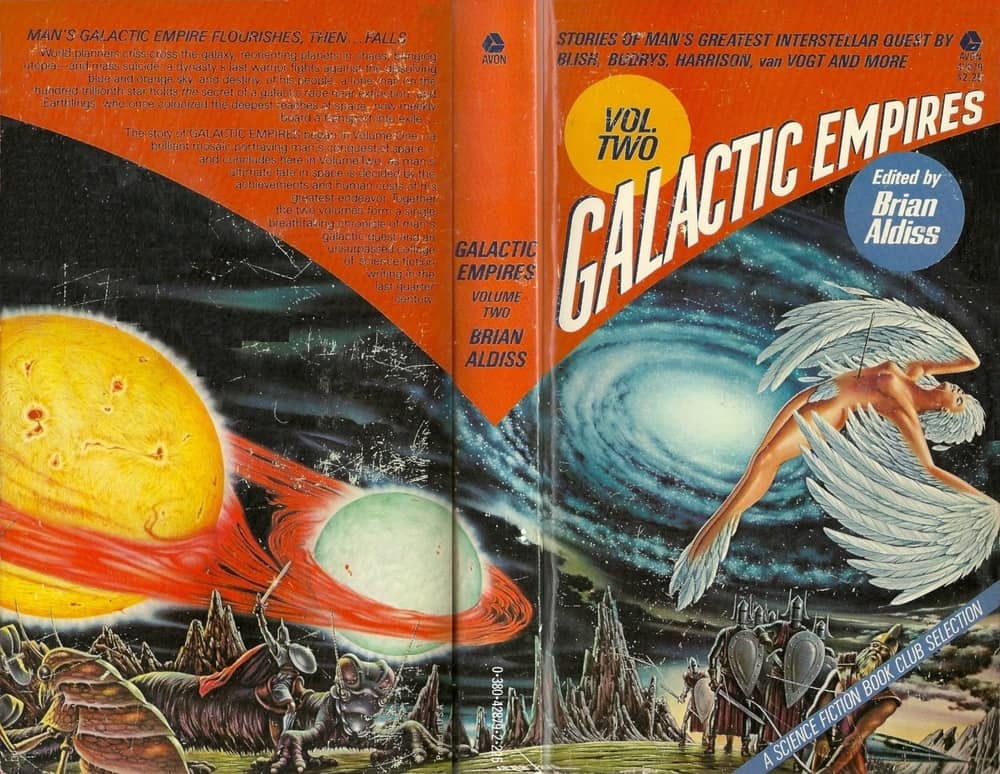 Galactic Empires, Volume Two, US paperback edition (Avon Books, March 1979). Cover by Alex Ebel
VOLUME TWO
Galactic Empires, Volume Two, US paperback edition (Avon Books, March 1979). Cover by Alex Ebel
VOLUME TWO
“Down the River” • (1950) • short story by Mack Reynolds
Humans are, in order, astonished to discover they are subjects of a galactic empire, offended that they are being traded from one empire to another, and alarmed by revelations concerning their new masters. This is an example of a “how would you feel if what you routinely do to others was done to you?” story. It’s not subtle because readers would miss the point if it were and probably most of them did, anyway.
“Final Encounter” • (1964) • short story by Harry Harrison
In the thousand centuries since faster than light drive gave humanity the stars, humans have never encountered intelligent aliens. Now on the far side of the Milky Way, they have. Or so it seems. Whether or not the odd beings are human or not turns out to be surprisingly easy to determine with a simple DNA test, so the big puzzle about which the story is constructed is easily resolved. What I found fascinating as a kid was how Harrison understood that due to the sheer size of the Milky Way (to quote George R. R. Martin):
“There are many ways to move between the stars, and some of them are faster than light and some are not, and all of them are slow.”
“Lord of a Thousand Suns” • (1951) • novelette by Poul Anderson
Humanity’s fate depends on a technological ghost left by a long-dead, all-powerful alien civilization. Anderson is the author I depend on to grasp space and time’s scales, so it’s odd and distracting that his protagonist seems convinced that dinosaurs walked the Earth only a million years ago.
“Big Ancestor” • (1954) • novelette by F. L. Wallace
Many worlds have human races, and while some are more highly evolved than others, all are clearly kin. What glorious race planted colonies in the long-forgotten past? The answer is astounding! Well, technically, the answer is galactic, as this story appeared in Galaxy, not Astounding.
The full review is well worth your time. Check it out here, and do yourself a favor and make it a habit to stop by James’ blog here.
We covered both volumes of Galactic Empires as a Vintage Treasure way back in December 2021.
Heroes and Humanity: Jack Kirby at the Skirball Center
Last Friday, as an early Father’s Day gift, my wife arranged for us to spend the afternoon at the Skirball Cultural Center in Los Angeles, which is hosting a wonderful new exhibition dedicated to the memory and achievement of a great American artist. Titled Jack Kirby: Heroes and Humanity and running until March 1, 2026, the show is a must-see for any admirer of the King of Comics.
Jack Kirby is arguably the most influential person in the history of mainstream American comic books; his work, more than that of any other artist or writer, defined the visual grammar of the superhero. Along with his partner Joe Simon, he created Captain America in the 1940’s, soldiered through the postwar superhero slump of the 1950’s doing work in all genres — science fiction, war, horror, western, and romance (it’s an often forgotten fact that Simon and two-fisted Jack Kirby created the romance comic book) until, in the 1960’s, when DC showed that there was a reawakening market for costumed heroes, he teamed up with Stan Lee to create the “Marvel Universe”, though they didn’t know that’s what they were doing when they did it.
 The King of Comics
The King of Comics
The 60’s saw a flood of characters from Kirby’s pen, most created in collaboration with Lee — the Fantastic Four, Galactus, the X-Men, Thor, Loki, the Black Panther, Ant-Man and the Wasp, the Inhumans, Ka-Zar, MODOK, the Hulk, the Avengers, Iron Man, Doctor Doom, Nick Fury and countless others were the products of his seemingly inexhaustible imagination.
 Oh, For Five Bucks and a Time Machine!
Oh, For Five Bucks and a Time Machine!
Then, in the 70’s at DC, now working without collaborators, Kirby inaugurated his toweringly ambitious, interlinked “Fourth World” series of comics, with characters such as the New Gods, the Forever People, Mister Miracle and Darkseid, in addition to enduringly popular stand-alone characters like Omac, the Demon, and Kamandi.
Perhaps the greatest indicator of Kirby’s quality is that he took Superman’s Pal Jimmy Olsen and made it a wild, hip, must-read book; any man who could do that was something special.
Certainly, there have been few American lives of more cultural consequence, and the fact that the mandarins in charge of prestigious museums and artistic institutions are paying attention to people like Jolly Jack is a welcome change from the days when comic book artists rated a little bit lower than the guys who clean out septic tanks. All credit to the Skirball for giving Kirby a place to shine.
 The Skirball Cultural Center
The Skirball Cultural Center
Founded in 1996 and located in the Santa Monica Hills of West Los Angeles, the Skirball Cultural Center is dedicated to celebrating the Jewish experience (especially the American Jewish experience), which makes it an ideal place for commemorating the legacy of Jack Kirby, who was born Jacob Kurtzberg in Manhattan’s Lower East Side in 1917. Heroes and Humanity is a first-rate tribute to his life and work.
The exhibit is laid out roughly chronologically; the first thing you see as you enter is a wall-sized reproduction of a Kirby drawing of one of the teeming New York City streets of his boyhood. What follows as you snake your way through to the end is virtually a history of the first five decades of American comic books.
After you turn the corner, at the very first stop (“Kirby Goes to War”), you find yourself face-to-face with one of the most iconic images in all of comic art — the cover of Captain America Comics number one, with Cap giving Adolf Hitler a crack on the jaw, all at the behest of Jack Kirby and Joe Simon, two young Jewish-Americans whose country wasn’t even at war with Germany at the time. One look at this cover leaves no doubt that truth, justice, and the American way (to borrow a phrase from another great hero of the day) were antithetical to Nazism and everything that it stood for, even if the government in Washington hadn’t quite gotten there yet.
 Jack and Joe Go to War
Jack and Joe Go to War
After a reminder that Kirby didn’t confine his opposition to fascism to the four-color page (a prominent place is made for the Army uniform that he wore while serving in Europe during World War Two), the displays take us through the kaleidoscope of genres that Kirby worked in during the postwar years. There are plenty of actual issues of comic books featured, of course, but most of the Skirball exhibit consists of original Kirby art, both published and unpublished.
 Private Kirby Reporting
Private Kirby Reporting
It’s a joy to be able to see this work (much of which has never been shown in public before) close up. Most are inked pages, completed by people familiar to comics fanatics — Joe Sinnott, Mike Royer, Vince Colletta, Bill Everett, Marie Severin, Dick Ayers, Chic Stone — but there are also many uninked drawings, allowing viewers to study Kirby’s legendary pencil technique.
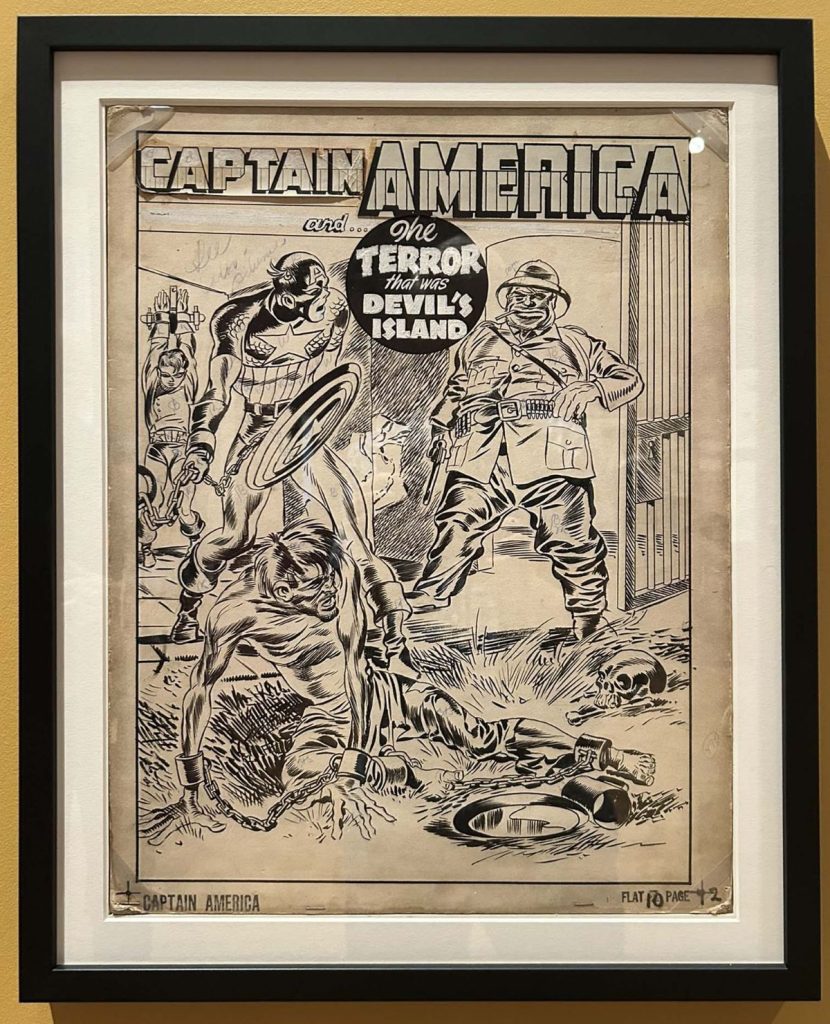 From Captain America Comics #5
From Captain America Comics #5
It’s especially nice to see so much of the 40’s and 50’s multi-genre work that Kirby did with Joe Simon, which isn’t as familiar to most people as the King’s later superhero creations for Marvel and DC. I particularly liked a gorgeous splash page, bursting with character and humor, from the western Boy’s Ranch, a title Kirby always cited as one of his favorites.
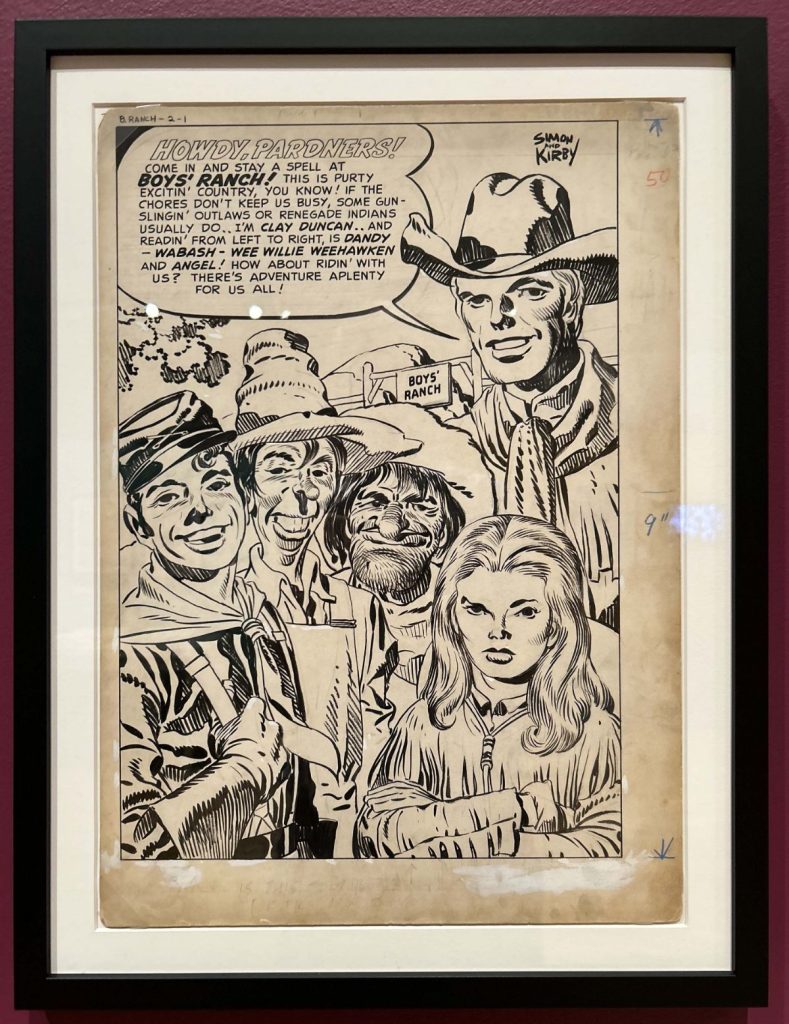 Boy’s Ranch Splash Page
Boy’s Ranch Splash Page
One section of the exhibit is titled “Kirby’s Stylistic Evolution”, and it traces just that, showing how Jack’s layouts and depiction of character and anatomy developed over time, resulting in bold, polished 60’s and 70’s art that was very different from his vigorous but coarser 40’s and 50’s output, while still remaining recognizably the work of the same man. (Once at the San Diego Comic Con, I heard Neal Adams talk about Kirby. “I didn’t like him”, Adams said. “His people were ugly, and they had big teeth.” Never fear — Adams eventually came around to full-blown Kirby worship.)
Of course, the great years of the Marvel 60’s and the DC 70’s form the core of the exhibit, and there is enough of that work at the Skirball to satisfy the appetite of any member of the MMMS or FOOM (that’s the Merry Marvel Marching Society and the Friends of Ol’ Marvel, if you didn’t know, and if you didn’t know, why didn’t you?)
One huge wall (“Re-Inventing the Superhero”) displays an entire X-Men story, and allows you to compare Kirby’s original art with the finished, colored comic book pages that were snapped up off the newsstands by eager kids in the 60’s, long before the Marvel Cinematic Universe was even a gleam in Stan Lee’s eye. (Stan is treated rather gingerly here — the most noticeable thing is that the standard formulation “Stan and Jack” is changed to “Kirby and Lee”, which in this context is only fair — it’s Jack’s show.)
Kirby’s Fourth World art and his other DC characters of the 70’s receive a large share of space, too. I think my single favorite thing in the whole exhibit was a magnificent pencil drawing of the cosmic fascist Darkseid (a character Kirby based on Mussolini), proud, immovable, lost in his dreams of universal dominion. A villain to be sure, but in Kirby’s hands, not just a villain. (I always think of Darkseid’s surprising summing up of the wedding of Mister Miracle and Big Barda: “It had deep sentiment — yet little joy. But — life at best is bittersweet!”)
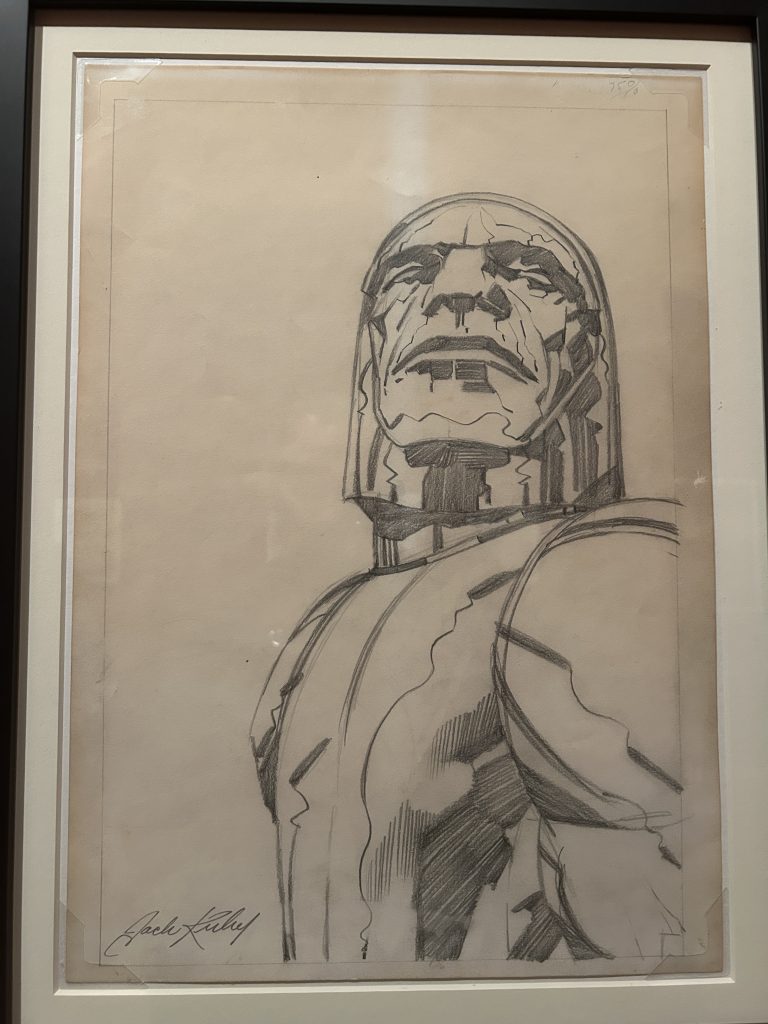 Darkseid
Darkseid
There are several striking examples of Kirby’s non-commercial art, work that he did just for himself or for friends. One of the most eye-catching is his dramatic depiction of the story of Jacob wrestling the Angel from the biblical book of Genesis, and there are several stunning Kirby collages, a form that he seemed especially fond of and that he sometimes integrated into his comic book work. One of the most touching of the personal items is a Hanukkah card that Jack and his wife Roz sent to friends; seeing a yarmulke on the Thing leaves no doubt about what Ben Grimm’s old neighborhood was like. Take that, Yancy Streeters!
There are more treasures at the Skirball than I have room to share with you here; all I can do is urge you to come and see it all for yourself. If you’re in the Los Angeles area any time in the next eight months, be certain to make time for Jack Kirby: Heroes and Humanity. It’ll be time well spent, because Jack Kirby is a man worth getting to know, and he continues to awe, delight, and even teach us.
 Into the Negative Zone
Into the Negative Zone
At another one of those long-ago San Diego Comic Cons, at the annual Jack Kirby Tribute Panel (the one event that I made sure I never missed), I heard the great Spider-Man artist John Romita tell a story about the first time he met Jack Kirby.
 Jacob and the Angel
Jacob and the Angel
Romita, a young artist just starting out, was in awe of this man who was a living legend. Not knowing what to say to one of his idols, but thinking about Kirby’s brilliant pencil drawings, Romita asked Jack what kind of pencil he used, thinking that the greatest artist in the business would name some fancy imported instrument hand-made out of rare Italian hardwood that cost fifty dollars a box, or something like that.
Jack looked blank for a moment; then he reached into his back pocket and pulled out a plain yellow pencil, the kind you can buy in any drugstore. “A number two”, he said.
He could see from the expression on Romita’s face that this wasn’t the answer the young man was expecting. “Then”, John Romita said, “Jack Kirby said something that changed my life as an artist.”
“John”, he said, “you don’t draw with a pencil.”
Think about that. You don’t draw with a pencil.
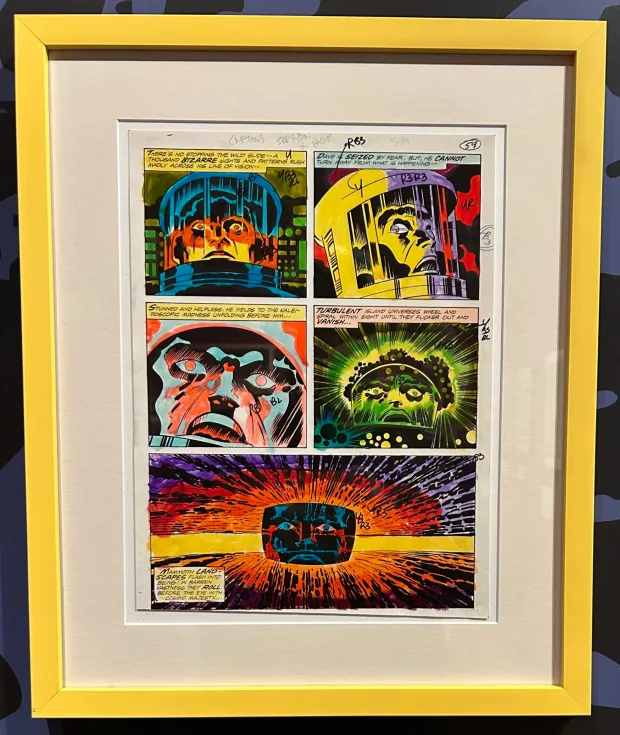 Look, Ma — No Pencil!
Look, Ma — No Pencil!
It’s the easiest thing in the world to confuse the tool with the task, but a true artist draws with his mind and his heart, with everything that he is; it’s not graphite or ink or paint that he puts on the page. It’s his soul — that’s why we respond to his work. That’s why it moves us, frightens us, excites us, exalts us, why it grabs hold of us and won’t let go; that’s why we love it.
Jack Kirby, who labored in the lowly comic book industry when that meant being disrespected and underpaid, was a true artist, and if he’s finally getting his due, then there’s hope for us all. Find out for yourself; come and pay him a visit.
Thomas Parker is a native Southern Californian and a lifelong science fiction, fantasy, and mystery fan. When not corrupting the next generation as a fourth grade teacher, he collects Roger Corman movies, Silver Age comic books, Ace doubles, and despairing looks from his wife. His last article for us was A Hand-Crafted World: Karel Zeman’s Invention for Destruction
The Fundamentals of Sword & Planet, Part I: Don Wollheim, Edwin L. Arnold, and Otis Adelbert Kline

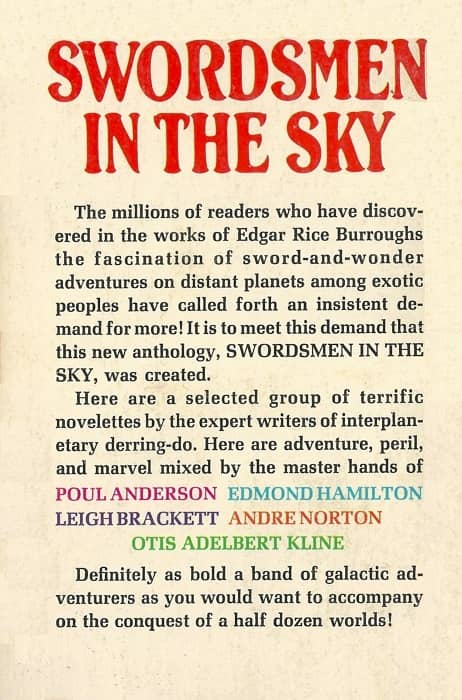
Swordsmen in the Sky (Ace, 1964). Cover by Frank Frazetta
If our genre has a holy grail to find, this would be it. I read this collection as a kid. Found it in our local library. And loved every single story in there. Took me a while to find a copy as an adult but it’s one of my pride and joys.
[Click the images for planet-sized versions.]
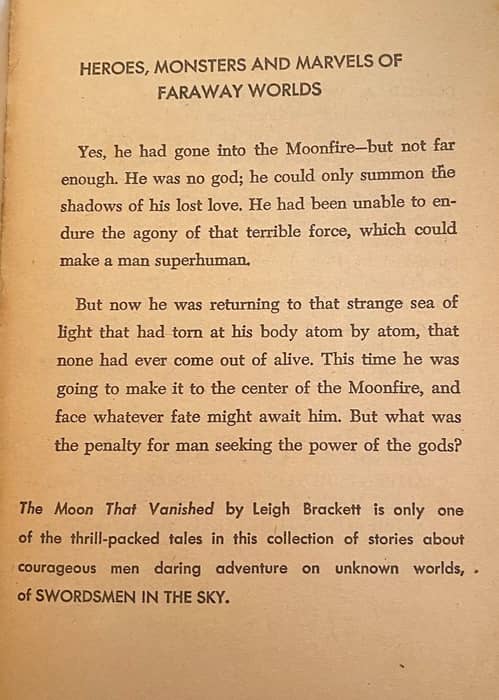
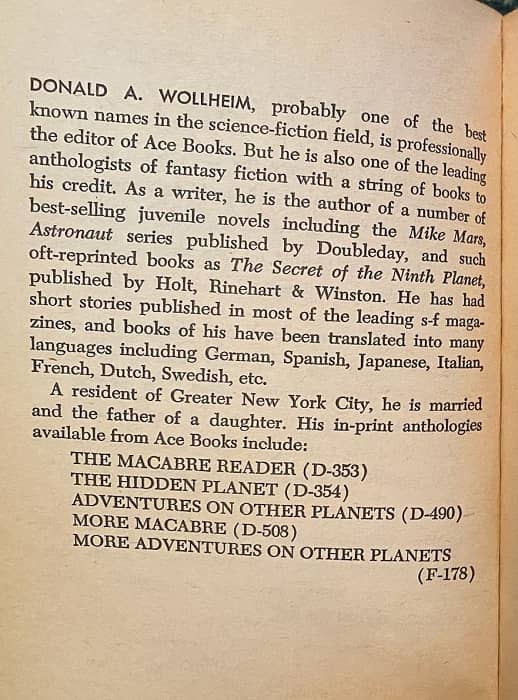
Inside cover and facing page for Swordsmen in the Sky
Edgar Rice Burrough’s biographer, Richard Lupoff, in Master of Adventure, suggested that ERB’s A Princess of Mars (1912) was influenced by a 1905 work called Lieut. Gulliver Jones: His Vacation, by Edwin Arnold. Gulliver Jones gets to Mars via flying carpet and finds a lost world, though not a desert world, inhabited by Martians.
There is a princess that “Gully” must rescue, and there’s a journey down a river, but otherwise there’s not a lot of similarities, and Gulliver’s story is a long way from being as compelling and entertaining as ERB’s Princess of Mars.
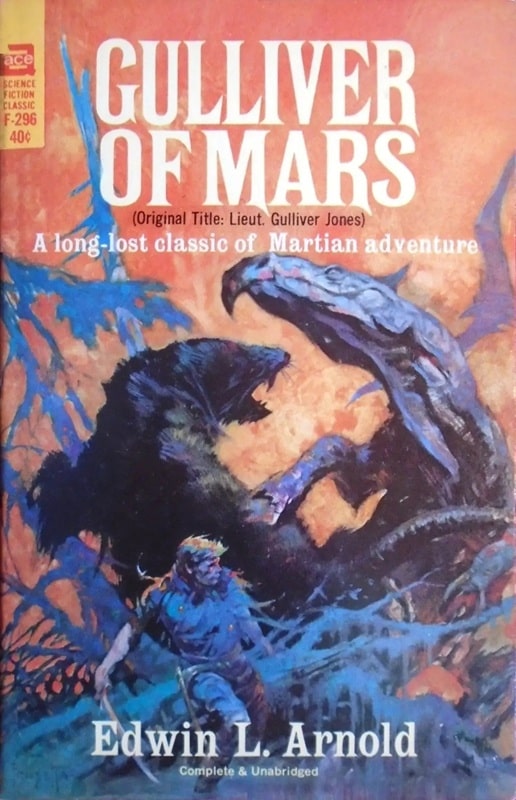
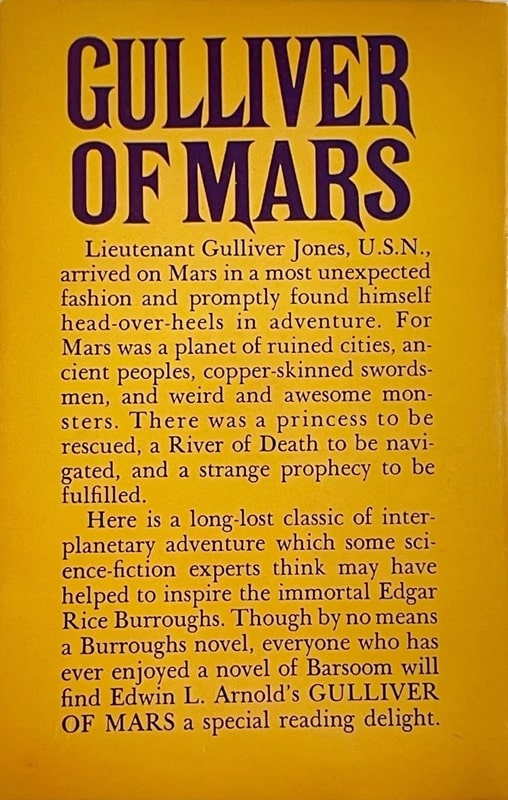
Gulliver of Mars (Ace Books, 1964). Cover by Frank Frazetta
Having read Lupoff, I sought out Arnold’s book, which was republished after the Burroughs boom began as Gulliver of Mars (1955). After reading that book, I personally couldn’t see anymore than the vaguest of similarities, and there’s no evidence that ERB actually ever read or knew of Arnold’s book.
Still, it’s an interesting curiosity and has a pretty cool cover in the reprint.
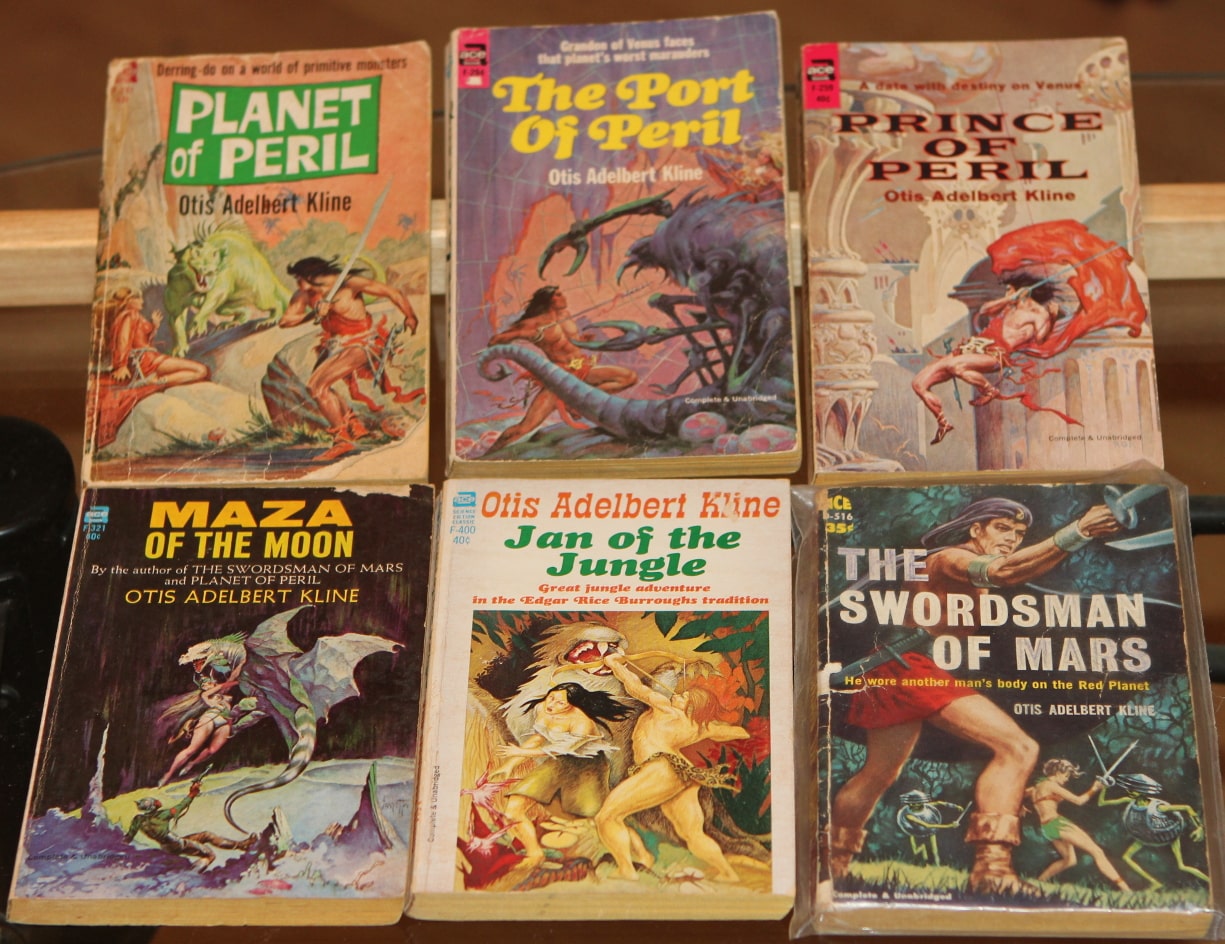 My Otis Adelbert Kline collection: Planet of Peril, The Port of Peril, and Prince of Peril (Ace Books, 1963-1964, covers by Roy Krenkel, Jr.), Maza of the Moon, Jan of the Jungle, and The Swordsman of Mars (Ace, 1965, 1966, and 1961; covers by Frank Frazetta, Stephen Holland, and Ed Emshwiller).
Otis Adelbert Kline
My Otis Adelbert Kline collection: Planet of Peril, The Port of Peril, and Prince of Peril (Ace Books, 1963-1964, covers by Roy Krenkel, Jr.), Maza of the Moon, Jan of the Jungle, and The Swordsman of Mars (Ace, 1965, 1966, and 1961; covers by Frank Frazetta, Stephen Holland, and Ed Emshwiller).
Otis Adelbert Kline
A contemporary of ERB was OAK, Otis Adelbert Kline. He also wrote sword and planet stories, and even jungle adventure. Both men had series set on Mars and Venus, and tales set on the moon. For a long time there were rumors of a feud between the two men but that idea has been generally debunked since no evidence from either party indicates any animosity between the two.
The publication dates of their stories certainly indicates some back and forth between their writings but nothing indicates any emotional intent behind it. I’ve read most of OAK’s stuff and find it fun, although — for me — without as much narrative drive and somewhat less colorful in imagination. OAK is also known to have been Robert E. Howard’s literary agent toward the end of Howard’s life.
Above is a picture of my Kline paperbacks. I have some other books by him in facsimile reprints. The Peril series (set on Venus) is particularly good in my opinion.

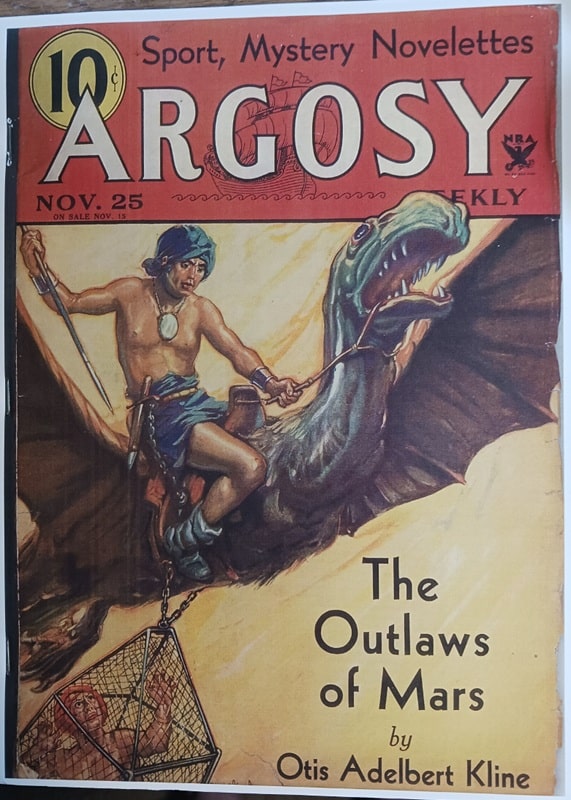
Facsimile editions of Argosy Weekly, January 7, 1933 and November 25, 1933. Covers by Robert A. Graef
Above are pictures of my facsimile copies of his two Mars books, The Swordsman of Mars and The Outlaws of Mars. These reprint the chapters from the original magazine publications with many of the illustrations.
Charles Gramlich administers The Swords & Planet League group on Facebook, where this post first appeared. His last article for Black Gate was a review of the Flashing Swords! anthology series edited by Lin Carter.
By Crom: It’s Conan…I Mean, Starr the Slayer!
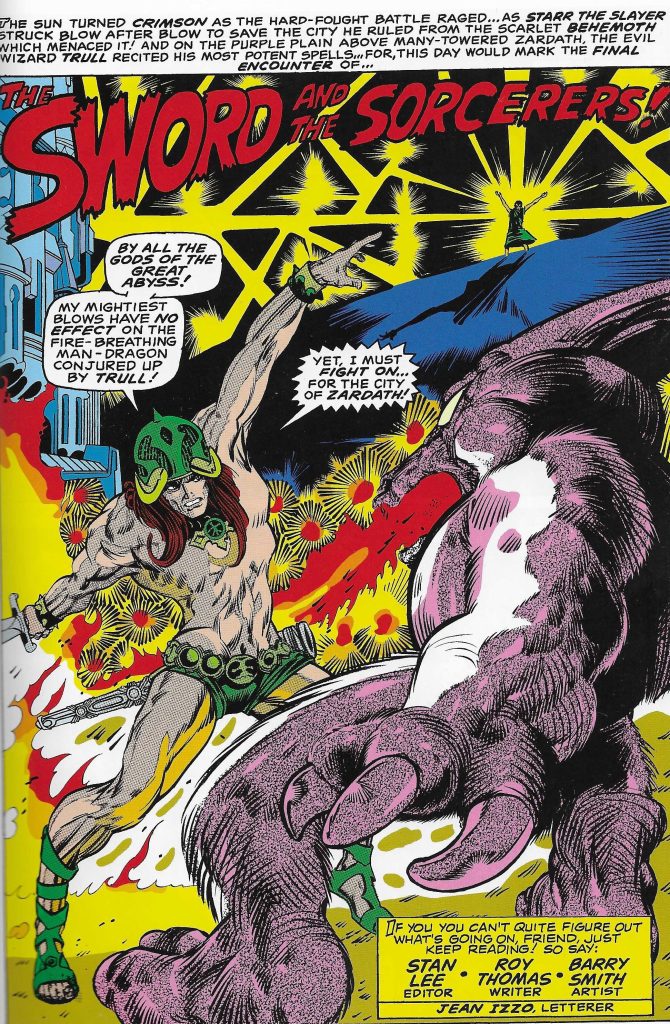 Having finished the first 100 issues of Marvel’s Conan the Barbarian, I did a post last week on Roy Thomas’s memoirs and that series. Which OF COURSE you read, here.
Having finished the first 100 issues of Marvel’s Conan the Barbarian, I did a post last week on Roy Thomas’s memoirs and that series. Which OF COURSE you read, here.
I started reading the first Savage Sword of Conan Omnibus from Marvel, but I’m still in a CtB mood. So, I decided to write another post about it. Sort of…
The first issue of Conan the Barbarian actually followed the sandalled feet of Starr the Slayer.
Just for fun, Roy Thomas had written a sword and sorcery story, and he had Barry (not yet ‘Windsor’) Smith draw it. Starr the Slayer was a very Conan-esque barbarian. In the story, he was the creation of Len Carson (named after Conan pastiche writer, Lin Carter), who dreamed his plots. But mentally exhausted from this, Carson wanted to kill off his meal ticket. Starr somehow travels to Carson’s time and kills the writer for attempting to dispose of him. Uh, okay, sure.
Starr appeared in the fourth issue of the Marvel anthology, Chamber of Darkness, hitting newsstands in April of 1970 (CtB debuted in October of the same year). Smith both penciled and inked the entire installment for Starr, from Thomas’ story.
Thomas did not intend for it to be an ongoing character, though it seems entirely conceivable that if Marvel had followed form and developed their own in-house character (giving them all the rights), instead of licensing one, Starr could well have been Marvel’s sword-swinger.
Smith gave Starr a distinctive medallion necklace. He also adorned the barbarian with a horned helm – except, the horns were in the front, rather than the side. This turned out to be important, because Smith and Thomas decided to keep both of those items for Conan. Marvel fans were used to superheroes in costumes. Conan got a bit of a mini-costume in this manner.
At only seven pages, it’s pretty short. Smith had been booted out of the United States green-card violations, and drew Starr while in England. He had also been doing some barbarian drawings for his own amateur magazine called Paradox. This black and white drawing by Smith might be one of them.
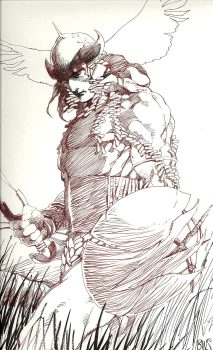 So, Smith had experience with drawing barbarians when Thomas approached him about Conan. Boss Goodman had put the kibosh on John Buscema by limiting the amount he would pay the illustrator. Which also knocked out fellow candidate Gil Kane (both of who would later draw much Conan). Thomas had passed on a couple Stan Lee suggestions, and then settled on Smith, who was near the bottom end of the pay scale.
So, Smith had experience with drawing barbarians when Thomas approached him about Conan. Boss Goodman had put the kibosh on John Buscema by limiting the amount he would pay the illustrator. Which also knocked out fellow candidate Gil Kane (both of who would later draw much Conan). Thomas had passed on a couple Stan Lee suggestions, and then settled on Smith, who was near the bottom end of the pay scale.
Thus, Marvel rather unintentionally did a trial run at Conan. I talked a bit about how the Conan comic book came about in last week’s post. But I do a deep dive into it in the started but nowhere completed series I have planned here at Black Gate on Thomas’ first ten issues of Conan the Barbarian. I have read the first hundred issues as prep work though. And this essay you’re reading was part of the series.
Marvel could easily have created their own in-house barbarian. And they had offered to pay Lin Carter for the use of his Conan clone, Thongor. But Carter’s agent held out for more money (apparently Martin Goodman NEVER caved on financial matters), and Thomas contacted Glenn Lord, the rights agent for Robert E. H(‘Of Aquilonia’ had come out.oward’s estate.
Lancer was essentially finished printing new Conan books (all but ‘The Buccaneer’ and ‘Of Aquilonia’ had already come out, and there was no popular Conan movie. There was no guarantee that Conan would be a hit. Thanks to those paperbacks with the Frank Frazetta covers, he was more recognizable than Thongor, or John Jakes’ Brak the Barbarian. But Conan was no sure thing as a comic.
Thankfully, Thomas convinced Stan Lee and Martin Goodman, and Conan became not only a Marvel best-seller, but is a popular franchise to this day (Marvel having re-obtained the rights a few years ago, but they are now held by Titan.
Starr did return, though not very memorably.
In 2007, Marvel included a version of Starr in its new version of the newuniversal series. I’ve never seen it, nor am I interested in the concept. You can go look it up for yourself if you want.
In 2009, Marvel’s Max Comics (adult-oriented imprint put out four new Starr the Slayer comics. All four are available digitally.
Prior Conan Comic Posts
By Crom: Marvel, Roy Thomas, and The Barbarian Life

Bob Byrne’s ‘A (Black) Gat in the Hand’ made its Black Gate debut in 2018 and has returned every summer since.
His ‘The Public Life of Sherlock Holmes’ column ran every Monday morning at Black Gate from March, 2014 through March, 2017. And he irregularly posts on Rex Stout’s gargantuan detective in ‘Nero Wolfe’s Brownstone.’ He is a member of the Praed Street Irregulars, founded www.SolarPons.com (the only website dedicated to the ‘Sherlock Holmes of Praed Street’).
He organized Black Gate’s award-nominated ‘Discovering Robert E. Howard’ series, as well as the award-winning ‘Hither Came Conan’ series. Which is now part of THE Definitive guide to Conan. He also organized 2023’s ‘Talking Tolkien.’
He has contributed stories to The MX Book of New Sherlock Holmes Stories — Parts III, IV, V, VI, XXI, and XXXVII.
He has written introductions for Steeger Books, and appeared in several magazines, including Black Mask, Sherlock Holmes Mystery Magazine, The Strand Magazine, and Sherlock Magazine.
You can definitely ‘experience the Bobness’ at Jason Waltz’s ’24? in 42′ podcast.
Mechanical Trees and Mini-Woolly Mammoths: May-June Print Science Fiction Magazines
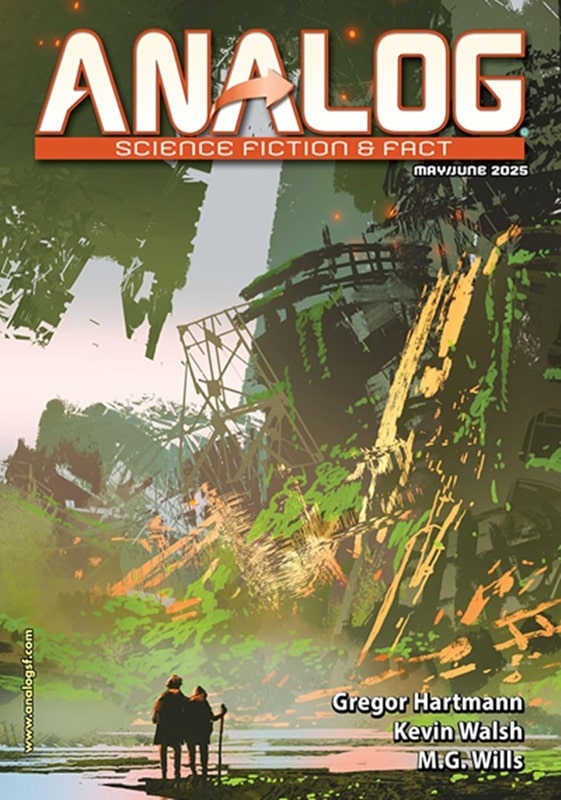
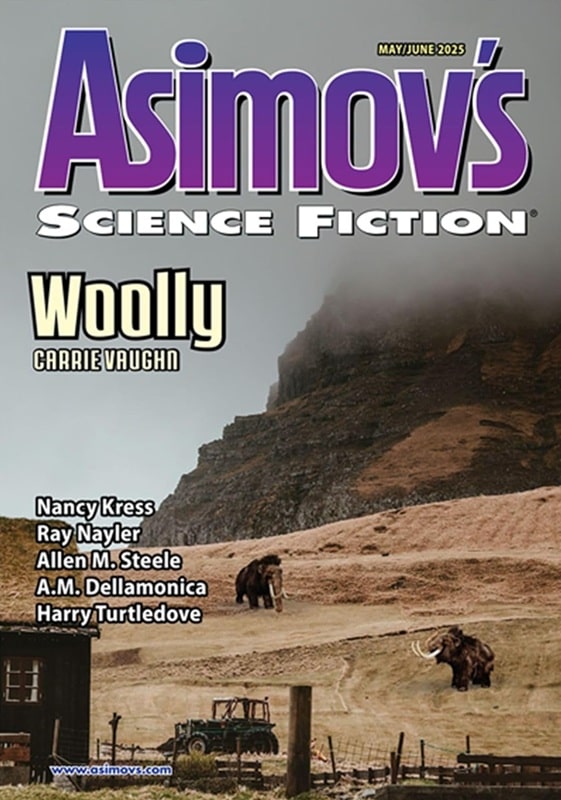
May-June 2025 issues of Analog Science Fiction & Fact and Asimov’s Science
Fiction. Cover art by Tithi Luadthong/Shutterstock, and IG Digital Arts & Annie Spratt
Back in February I was surprised to learn that the last surviving print science fiction magazines, Analog, Asimov’s Science Fiction, and The Magazine of Fantasy & Science Fiction, had all been sold to Must Read Books, a new publisher backed by a small group of genre fiction fans. I was very sad to see Analog & Asimov’s leave the safe harbor of Penny Press, where they’ve both sheltered safely for very nearly three decades as the magazine publishing biz underwent upheaval after upheaval.
But I was nonetheless cautiously optimistic. The magazines couldn’t continue to survive as they were, with 25+ years of slowly declining circulation — and indeed F&SF, while it claims to be an ongoing concern, has not published a new issue in nearly a year.
But after four months, that optimism is rapidly fading. The first issues from Must Read, the May-June Analog and Asimov’s, technically on sale April 8 – June 8, have yet to appear on the shelves at any of my local bookstores, and there’s been no word at all at when we can expect the July-August issues, scheduled to go on sale today. And there’s no whisper of when we might expect to see a new issue of F&SF at all.
 The March-April issues of Analog and Asimov’s SF, still on the shelves at Barnes and Noble in Geneva, Illinois on June 7, 2025
The March-April issues of Analog and Asimov’s SF, still on the shelves at Barnes and Noble in Geneva, Illinois on June 7, 2025
So why are there photos of the May-June issues at the top of this column? Are they ChatGPT hallucinations?
Nope. If you have a digital subscription, your issues of Analog and Asimov’s arrived on time on April 8. And I’m told that folks with print subscriptions received hard copies in the mail around May 15. So copies do, in fact, exist. But the new owners don’t seem to have the myriad complexities of distribution figured out yet.
A shame, since I’d love to get my hands on the latest issues (after having my copies mangled by the post office in the 80s, I switched to buying them from bookstores, and have stuck with that method for the last 40 years). They’re just as enticing as usual, with contributions from Nancy Kress, Allen M. Steele, Ray Nayler, Harry Turtledove, Steve Rasnic Tem, Carrie Vaughn, A.M. Dellamonica, Brenda Cooper, Shane Tourtellotte, Mark W. Tiedemann, Gregor Hartmann, Howard V. Hendrix, and many more.
Mina at Tangent Online enjoyed the latest Asimov’s.
“The Hunt for Lemuria 7” by Allen M. Steele is a sequel to “Lemuria 7 Is Missing” [from the July/August 2023 issue]. The story is a mosaic of various sources piecing together the efforts to find the missing crew of six like a lunar Mary/Marie Celeste. Merlin Feng is determined to find out what happened to his mentor and his mentor’s daughter and former girlfriend, Amelia. He designs robotic rovers with advanced AI systems to investigate the site of their disappearance and other sites where Transient Lunar Phenomena have been observed. Five years after the disappearance, Amelia turns up at the Great Wall of China. All she can say is that she has been sent back to warn others not to set foot on the moon…
“In the Forest of Mechanical Trees” by Steve Rasnic Tem is a thoughtful and thought-provoking story about a world living with climate change and other environmental ravages. An elderly couple run a theme park in the ever-growing Arizona desert. The park includes trees that soak up carbon dioxide and sculptures to commemorate the growing list of extinct species. The park’s staff are determined in their fight against the elements and it’s curiously not a depressing story. But it is a sobering reminder of the direction humanity is heading in.
“The Fight Goes On” by Harry Turtledove imagines a Sarajevo in 1914 filled with time travellers: some trying to stop the murder of Franz Ferdinand; some trying to ensure it happens. We follow the attempts of one time traveller. It was well-written and amusing but didn’t grab me.
In “The Tin Man’s Ghost” by Ray Nayler, we meet Sylvia Aldstatt again: the agent who can speak with the dead with the help of alien technology. We are in the McCarthy era but in a world changed by the use of technology reverse engineered from a crashed flying saucer. Sylvia’s mission this time is to talk to the ghost of a robot (also referred to as a war machine or the Tin Man by others, as a “mechanical” by itself). Sylvia discovers that all mechanicals were given the memories of one man, Alvin Greenly, but that they diverged over time. And she discovers that mechanicals are capable of courage and sacrifice. Sylvia also meets Oppenheimer but that is not the main focus of the story; the main focus is on stopping, or at least slowing down, the development of the atomic bomb. The mechanical, Bill, worms its way into our hearts, giving the last line of the story its full poignancy… an excellent novelette.
“Trial by Harry” by Michael Libling is ultimately a horror story. A new drug is on trial for older people in a vegetative state. Harry is visited faithfully by his two surviving children as he slowly comes back up from the bottom of a deep well. We see his memories as he recovers them and slowly we realise that Harry was not a good man. The title takes on a chilling double meaning as you reach the end of the story.
“Woolly” by Carrie Vaughn is a warm tale. Joy runs a rescue farm for abandoned, genetically modified, mini-woolly mammoths. When the government decides to put them all down, Joy needs to win more time to fight the decision in court. The tale ends on a light note, with the reader rooting for Joy and her charges.
Read Mina’s complete review here.
The new Analog is reviewed by the always reliable Victoria Silverwolf at Tangent Online. Here’s a sample.
“Isolate” by Tom R. Pike takes place in a galactic empire ruled by a monarch who is worshipped as a deity. The protagonist is a cleric and a linguist, sent to a remote region of a planet recently annexed to the empire. Her task is to determine if the local language is related to the empire’s official language, and thus acceptable, or if it must be eliminated…
In “The Robot and the Winding Woods” by Brenda Cooper, an elderly couple maintains a campground, even though there have been no visitors for many years. A robot arrives to tell them that the area is to be returned to pure wilderness, and that they must leave. Another fact revealed by the robot changes the situation…
“Mnemonomie” by Mark W. Tiedemann takes place in a society where boys become men by having their memories completely replaced, instantly changing them from adolescents interested in aggressive sports to adults with careers. One such young man suffers brain injury during an attack by a rival team, so the process is not completely successful, leaving him with memories of his past. In this way, he learns something about the world in which he lives…
“The Scientist’s Book of the Dead” by Gregor Hartmann takes place years after a devastating war wiped out most of humanity and a revolution resulted in a world ruled by technocrats. The western hemisphere is completely depopulated and left as a wilderness area. The aging leader of the revolution and his chief of staff, a young woman bred to be at the peak of human ability, lead the narrator and other technocrats on a hike in an otherwise deserted North America… The story offers much food for thought, without easy answers.
The two characters in “Siegfried Howls Against the Void” by Erik Johnson are sentient starships, many lightyears apart in their separate voyages. Over millennia, they send occasional messages to each other. One of them, identified as male, comes to depend on the signals from the other, identified as female. In addition to making the starships seem like people, the author also anthropomorphizes stars and planets, describing them as mothers and their children. Despite having no human characters, this is a romantic story, with interstellar exploration as a source of emotional wonder and despair… This is the author’s first published story, and it reveals a rich imagination and a lush narrative style that could benefit from a little discipline.
The novella “Bluebeard’s Womb” by M. G. Wills deals with a project to create a uterus within a man’s body, which can then have an embryo implanted in it so the man can give birth by Caesarean section. The first volunteer is an acquaintance of the woman in charge. He has his own agenda, which only becomes clear after the child is born. Although this is not the first story to feature male pregnancy, it is unusually realistic and scientifically plausible… this provocative work is sure to create controversy. Readers’ opinions on the issues raised in it will determine how they react to it.
Read Victoria’s full review here.
Here’s all the details on the latest SF print mags.
[Click the images for bigger versions.]
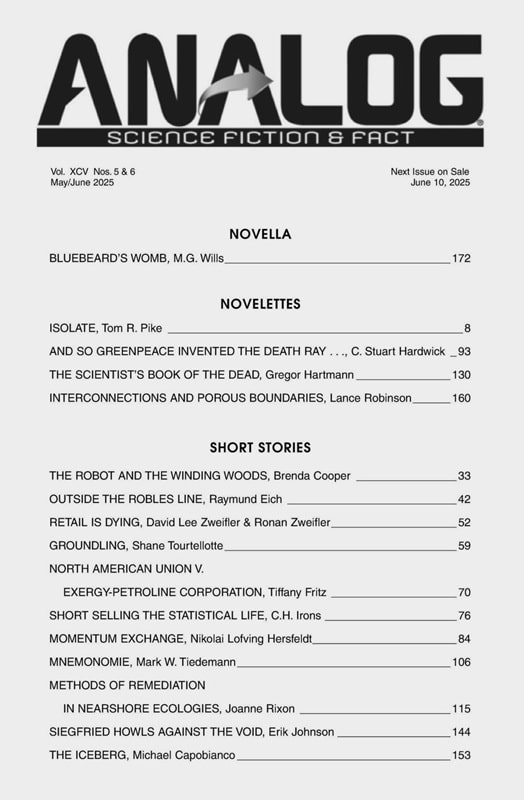
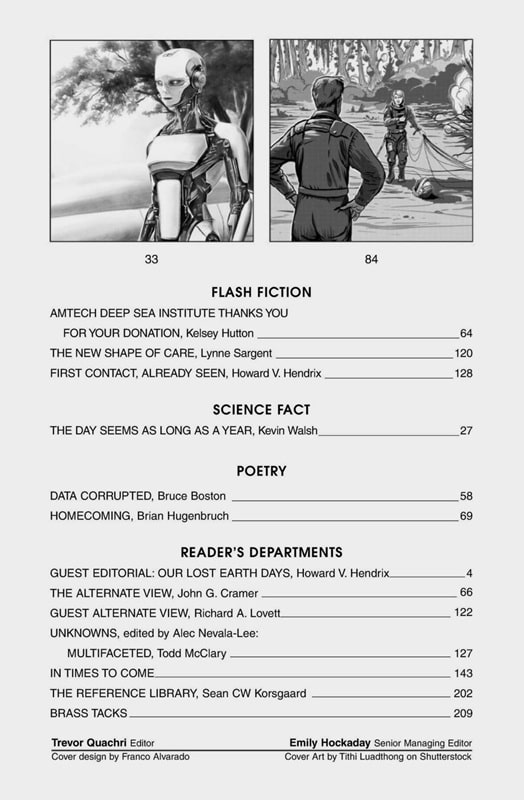
Analog Science Fiction & Science Fact, May-June 2025 contents
Editor Trevor Quachri gives us a tantalizing summary of the current issue online, as usual.
Unlike this issue, there’s no grand unifying theme for May/June other than “good stories,” but that’s okay: it’ll keep you on your toes!
First up is a bit of classic Schmidtian linguistic science fiction in “Isolate” by Tom R. Pike. We also anchor the issue with what’s likely to be the definitive hard SF take on a classic SFnal “What If . . . ?” scenario, in “Bluebeard’s Womb,” by M.G. Wills, plus a bunch of other fine fiction, including a game of cat and mouse between a jailer and his prisoner, only on a grand scale, in “Momentum Exchange,” by Nikolai Lofving Hersfeldt; an older couple trying to make it in a world that no longer has room for them in a very concrete way in “The Robot and The Winding Woods,” by Brenda Cooper, plus much, much more, from folks like C. Stuart Hardwick, Kelsey Hutton, Michael Capobianco, and Gregor Hartmann.
Here’s the full TOC.
Novella
“Bluebeard Womb” by M.G. Wills
Novelettes
“Isolate” by Tom R. Pike
“And So Greenpeace Invented the Death Ray…” by C. Stuart Hardwick
“The Scientist’s Book of the Dead” by Gregor Hartmann
“Interconnections and Porous Boundaries” by Lance Robinson
Short Stories
“The Robot and the Winding Woods” by Brenda Cooper
“Outside of the Robles Line” by Raymund Eich
“Retail is Dying” by David Lee Zweifler & Ronan Zweifler
“Groundling” by Shane Tourtellotte
“North American Union V. Exergy-Petroline Corporation” by Tiffany Fritz
“Short Selling the Statistical Life” by C.H. Irons
“Momentum Exchange” by Nikolai Lofving Hersfeldt
“Mnemonomie” by Mark W. Tiedemann
“Methods of Remediation in Nearshore Ecologies” by Joanne Rixon
“Siegfried Howls Against the Void” by Erik Johnson
“The Iceberg” by Michael Capobianco
Flash Fiction
“Amtech Deep Sea Institute Thanks You For Your Donation” by Kelsey Hutton
“The Shape of Care” by Lynne Sargent
First Contact, Already Seen” by Howard V. Hendrix
Science Fact
The Day Seems as Long as a Year, by Kevin Walsh
Poetry
“Data Corrupted” by Bruce Boston (Poetry)
“Homecoming” by Brian Hugenbruch (Poetry)
Reader’s Departments
Guest Editorial: Our Lost Earth Days by Howard V. Hendrix
The Alternative View, John G. Cramer
Guest Alternative View by Richard A. Lovett
In Times to Come
The Reference Library by Sean CW Korsgaard
Brass Tacks
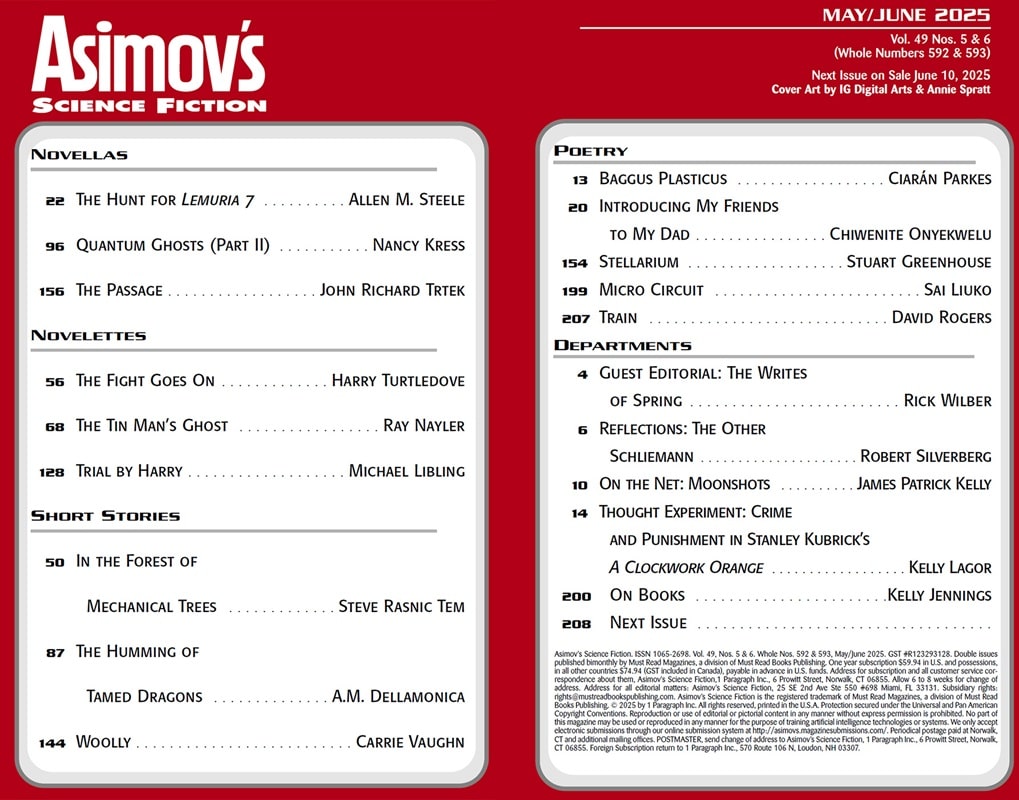 Asimov’s Science Fiction, May-June 2025 contents
Asimov’s Science Fiction
Asimov’s Science Fiction, May-June 2025 contents
Asimov’s Science Fiction
Sheila Williams provides a handy summary of the latest issue of Asimov’s at the website.
We have three thrilling novellas crammed into our May/June 2025 issue! The issue opens with Allen M. Steele’s exciting and enigmatic “Hunt for Lemuria 7”! Allen takes us back to the Moon where the mysterious disappearance of Lemuria 7 and its crew becomes a conundrum. John Richard Trtek delivers an exquisitely told tale set on a far-future Earth where humans who wish to emigrate to an alien planet must first embark on “The Passage.” Nancy Kress wraps up the issue with the conclusion to her brilliant hard SF story about “Quantum Ghosts”! You won’t want to miss any of these exciting works.
A.M. Dellamonica squeezes a movie-length suspense/romcom film into a short story about “The Humming of Tamed Dragons”; Michael Libling spins a deceptive horror story about what it means to endure “Trial by Harry”; Carrie Vaughn conveys the heartfelt story of a woman’s attempt to rescue “Woolly”; Ray Nayler’s novelette tells the complex tale of a retired Sylvia Altstatt called back into service by “The Tin Man’s Ghost”; Steve Rasnic Tem invites us “In the Forest of Mechanical Trees” where an elderly group of people who maintain a sculpture park try to create a whimsical sense of normalcy for a family escaping the ravages of climate change; and Harry Turtledove’s time travel tale about frustrating and tragic historical events reveal why “The Fight Goes On.”
Robert Silverberg’s Reflections muses about “The Other Schliemann”; James Patrick Kelly’s On the Net takes some “Moonshots”; Kelly Jennings’s On Books looks at works by T. Kingfisher, Madeline Ashby, John Wiswell, Cebo Campbell, Michael Bérubé, and others; Kelly Lagor’s Thought Experiment considers “Crime and Punishment in Stanley Kubrick’s A Clockwork Orange”; plus we’ll have an array of poetry you’re sure to enjoy.
Here’s the complete Table of Contents.
Novellas
“The Hunt for Lemuria 7” by Allen M. Steele (Novella)
“Quantum Ghosts (Part II)” by Nancy Kress (Novella)
“The Passage” by John Richard Trtek (Novella)
Novelette
“The Fight Goes On” by Harry Turtledove (Novelette)
“The Tin Man’s Ghost” by Ray Nayler (Novelette)
“Trial by Harry” by Michael Libling (Novelette)
Short Stories
“In the Forest of Mechanical Trees” by Steve Rasnic Tem (Short story)
“The Humming of Tamed Dragons” by A.M. Dellamonica (Short story)
“Woolly” by Carrie Vaughn (Short story)
Poetry
“Baggus Plasticus” by Ciarán Parkes (Poetry)
“Introducing My Friends to My Dad” by Chiwenite Onyekwelu (Poetry)
“Stellarium” by Stuart Greenhouse (Poetry)
“Micro Circuit” by Sai Liuko (Poetry)
“Train” by David Rogers (Poetry)
Departments
Guest Editorial: The Writes of Spring by Rick Wilber
Reflections: The Other Schliemann by Robert Silverberg
On the Net: Moonshots by James Patrick Kelly
Thought Experiment: Crime and Punishment in Stanley Kubrick’s A Clockwork Orange by Kelly Lagor
On Books by Kelly Jennings
Next Issue
Analog, Asimov’s Science Fiction and The Magazine of Fantasy & Science Fiction are available wherever magazines are sold, and at various online outlets. Buy single issues and subscriptions at the links below.
Asimov’s Science Fiction (208 pages, $8.99 per issue, one year sub $47.97 in the US) — edited by Sheila Williams
Analog Science Fiction and Fact (208 pages, $8.99 per issue, one year sub $47.97 in the US) — edited by Trevor Quachri
The Magazine of Fantasy & Science Fiction (256 pages, $10.99 per issue, one year sub $65.94 in the US) — edited by Sheree Renée Thomas
The May-June issues of Asimov’s and Analog are officially on sale until June 8, but (assuming they ever show up at all) likely will be on shelves a little longer than that. See our coverage of the March-April issues here, and all our recent magazine coverage here.
Half a Century of Reading Tolkien: Part Five: From the Beginning — The Hobbit by JRR Tolkien
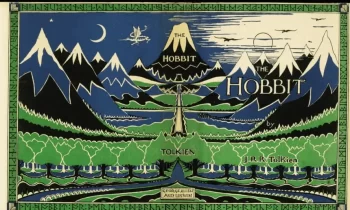 In a hole in the ground there lived a hobbit.
In a hole in the ground there lived a hobbit.
Chapter 1, An Unexpected Party – The Hobbit
Fifty years ago, when I first read this book, I didn’t imagine I’d still be reading it so many years later. Heck, I doubt I could have even imagined being as old as I am now. But I do reread it every few years. When I revisit The Hobbit, my journey is bathed in nostalgia as much as with the simple enjoyment caused by reading a charming book that I happen to know inside out, from the opening line above on through to the very end.
In my initial article on half a century of reading Tolkien back in January, I described my dad trying to get our first color tv in time to watch the Rankin & Bass The Hobbit. Remembering that again last week left me thinking more of my dad, now gone nearly 24 years, than the book. He was ten years younger than I am now when the movie first aired, which makes me feel incredibly old at the moment. For such a conservative man, he was excited to see it — admittedly, in a restrained way. I think we liked it well enough, but leaving out Beorn irked us both. Beyond Tolkien’s books, our fantasy tastes rarely coincided (I’ve got a shelf full of David Eddings books he bought, if anyone’s interested), but with The Hobbit and LOTR, we were in complete agreement.
What’s there to say about The Hobbit here on Black Gate? Nothing, really. I imagine most visitors here have read it, many more than once, and have their own ideas on it. It’s one of the most widely read books in the world. Instead, I’m going to discuss some adaptations of the book. But first, a summary.
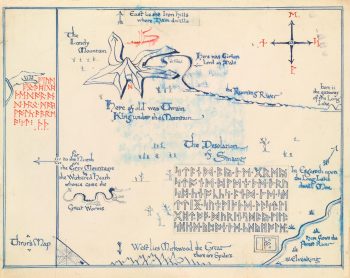 Map of the Lonely Mountain by JRR Tolkien
Map of the Lonely Mountain by JRR Tolkien
Hobbits are Tolkien’s slightly comical take on the staid British country folk. Their homeland is so British in nature, it’s even called the Shire. They prefer comfort and predictability and tend toward stoutness. Bilbo Baggins, the only son of wealthy parents has settled into a very predictable and very comfortable middle-age. When Gandalf, a wizard known fondly for magnificent fireworks and less fondly for occasionally leading young hobbits off on some adventure, appears at his doorstep, Bilbo’s life takes a drastic turn. The wizard has come to bring Bilbo on an adventure. Despite the hobbit’s denial of any interest in such an undertaking, Gandalf leaves a mark on his door so a throng of dwarves can find their way their the next day.
The dwarves, led by Thorin Oakenshield, are survivors of the Lonely Mountain. Once a mighty and wealthy dwarven stronghold, one hundred and seventy one years earlier, it was sacked by the great dragon Smaug and its citizens killed or driven out. Save Thorin and one other, the dwarves are miners and smiths, not fighters. Still, the band is determined to reclaim their mountain and their treasure, despite having neither a plan nor the means to remove the dragon.
Succumbing to a repressed ancestral taste for adventure, Bilbo joins the dwarven company on its quest. Soon, Bilbo finds himself on the wrong side of hungry trolls, angry goblins, and, perhaps worst of all, Gollum.
Deep down here by the dark water lived old Gollum, a small slimy creature. I don’t know where he came from, nor who or what he was. He was Gollum—as dark as darkness, except for two big round pale eyes in his thin face. He had a little boat, and he rowed about quite quietly on the lake; for lake it was, wide and deep and deadly cold. He paddled it with large feet dangling over the side, but never a ripple did he make. Not he. He was looking out of his pale lamp-like eyes for blind fish, which he grabbed with his long fingers as quick as thinking. He liked meat too. Goblin he thought good, when he could get it; but he took care they never found him out. He just throttled them from behind, if they ever came down alone anywhere near the edge of the water, while he was prowling about. They very seldom did, for they had a feeling that something unpleasant was lurking down there, down at the very roots of the mountain. They had come on the lake, when they were tunnelling down long ago, and they found they could go no further; so there their road ended in that direction, and there was no reason to go that way—unless the Great Goblin sent them. Sometimes he took a fancy for fish from the lake, and sometimes neither goblin nor fish came back.
Just prior to his encounter with Gollum, Bilbo finds a plain golden ring, a Ring that will come to prove of vital importance in later years. After discovering it turns its wearer invisible, Bilbo uses it to his advantage to escape from the goblins, and to save the dwarves on several occasions, once from giant spiders and once from elven prison cells. Eventually, he even uses it to allow himself to engage in some dangerous banter with the dragon.
“Well, thief! I smell you and I feel your air. I hear your breath. Come along! Help yourself again, there is plenty and to spare!”
But Bilbo was not quite so unlearned in dragon-lore as all that, and if Smaug hoped to get him to come nearer so easily he was disappointed. “No thank you, O Smaug the Tremendous!” he replied.
“I did not come for presents. I only wished to have a look at you and see if you were truly as great as tales say. I did not believe them.”
“Do you now?” said the dragon somewhat flattered, even though he did not believe a word of it.
“Truly songs and tales fall utterly short of the reality, O Smaug the Chiefest and Greatest of Calamities,” replied Bilbo.
“You have nice manners for a thief and a liar,” said the dragon. “You seem familiar with my name, but I don’t seem to remember smelling you before. Who are you and where do you come from, may I ask?”
“You may indeed! I come from under the hill, and under the hills and over the hills my paths led. And through the air. I am he that walks unseen.”
“So I can well believe,” said Smaug, “but that is hardly your usual name.”
“I am the clue-finder, the web-cutter, the stinging fly. I was chosen for the lucky number.”
“Lovely titles!” sneered the dragon. “But lucky numbers don’t always come off.”
“I am he that buries his friends alive and drowns them and draws them alive again from the water. I came from the end of a bag, but no bag went over me.”
“These don’t sound so creditable,” scoffed Smaug. “I am the friend of bears and the guest of eagles. I am Ringwinner and Luckwearer; and I am Barrel-rider,” went on Bilbo beginning to be pleased with his riddling.
“That’s better!” said Smaug. “But don’t let your imagination run away with you!”
By hands other than their own, the dwarves find themselves rid of the dragon. This leaves them in control of the mountain and the treasure. Part of the treasure, though, is sought, not unreasonably, by the dragon’s slayer, among others. Dwarves, being dwarves — “dwarves are not heroes, but calculating folk with a great idea of the value of money” — have no intention of giving up one farthing of their hoard, and soon the stage is set for a great battle. Bilbo makes it home, but only after having to commit an act of great moral bravery. The hobbit who returns home is not the same as the one who left, which of course, will turn out to be of the greatest importance for Middle-earth in the years to come.
The first and best adaptation I’m familiar with is the audio version performed by Nicol Williamson for Argo Records in 1974. Lasting nearly four hours, it has the room to tell most of the story. I remember my mother bringing it home from the library and realizing how long and complete it was. I listened to all of it on a Saturday and loved every minute of it.
Williamson himself did many of the edits, removing the most of the ‘he saids.’ He used various regional UK accents to differentiate the various characters. Williamson was one of the great stage actors of the last century, possessed of an absolutely magnificent and captivating voice. I haven’t listened to all of Andy Serkis’ unabridged presentation of the book, but as good as what I’ve heard is, Williamson’s is still the winner. Here’s Part Two of Williamson’s version, starting with Bilbo’s encounter with a wonderfully ghastly sounding Gollum.
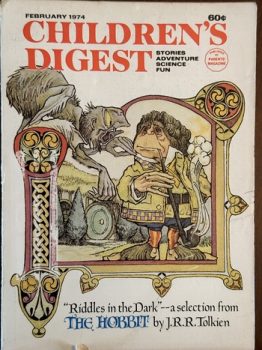 The video clip above of Bilbo and Smaug in the summary is from the second adaptation, the 1977 Rankin and Bass animated The Hobbit. The character designs were by Lester Abrams who had illustrated the Bilbo-Gollum confrontation for Children’s Digest. Arthur Rankin had seent he illustrations and liked them enough to engage Abrams for the movie. The animation was done by the Japanese company Topcraft (which would later go on to do Miyazaki’s first movie, Nausicaä of the Valley of the Wind, and become part of the foundation of Studio Ghibli).
The video clip above of Bilbo and Smaug in the summary is from the second adaptation, the 1977 Rankin and Bass animated The Hobbit. The character designs were by Lester Abrams who had illustrated the Bilbo-Gollum confrontation for Children’s Digest. Arthur Rankin had seent he illustrations and liked them enough to engage Abrams for the movie. The animation was done by the Japanese company Topcraft (which would later go on to do Miyazaki’s first movie, Nausicaä of the Valley of the Wind, and become part of the foundation of Studio Ghibli).
I love the movie, despite its too-rapid pace, the elimination of Beorn, and overall simplification. The painted scenery and backgrounds are wonderful, presenting Middle-earth in warm, muted colors. It looks at once realistic and fantastic. The voice acting, if not of Williamson’s caliber, is first-class, with Orson Bean as Bilbo, John Huston as Gandalf, Hans Conreid as Thorin, and, most wonderfully, Brother Theodore as Gollum.
 Map of Wilderland by JRR Tolkien
Map of Wilderland by JRR Tolkien
It’s far from perfect, but it succeeds better than anything else at conveying a sense of real wonder with each new encounter Bilbo has with the increasingly strange and dangerous denizens of the Wilderlands east of the Shire. Rankin had declared that there would be nothing in the movie that wasn’t in the book, and he proved largely true to his word. It also makes good use of Tolkien’s songs. I admit to not loving Tolkien’s songs and poetry in The Lord of the Rings, but in The Hobbit, he provides some solid children’s poetry and it carries over well in the film. That it remains a children’s film and not some tarted up action movie is its greatest strength. Bilbo is a likeable and brave, and the scary bits are just scary enough for young viewers. At 78 minutes, it’s also the perfect length to get exposed to Middle-earth and JRR Tolkien.
I haven’t much to say about Peter Jackson’s three, interminable, cacophonous movies save “I give up!” I feel like I watched them for penance for any and all sins I’ve ever committed and will yet commit. Martin Freeman is fine enough, if far too thin, as Bilbo, but everything else is awful. Instead of the episodic charm of JRR Tolkien’s actual book, Jackson delivered three movies totaling nearly eight hours of sodden, CGI-infested stuff, packed full of things JRR Tolkien could never have conceived of.
Like with his LOTR trilogy, the films diverge from their sources the further they move along. While the first, An Unexpected Journey (2012), largely follows the form and shape of the book, the second, The Desolation of Smaug (2013), adds an unbelievably poor romantic entanglement and hints of municipal corruption in Lake Town. The dwarves Rube Goldberg plan to encase Smaug in molten gold had me wishing I had more hair to pull out of my head. By the third chapter, The Battle of the Five Armies (2014), all bets are apparently off. Even though I hate Jackson’s desire to turn the the titular battle into a gigantic spectacle, I understand it. The shenanigans of the the Master of Lake Town, however, are awful and nothing anybody who’s at all interested in the fate of Bilbo and the dwarves will be at all interested watching.
Oh, and I haven’t mentioned the terrible-looking and slog that is Gandalf and the White Council’s battle with the Necromancer, aka Sauron. No more than a plot device to extract Gandalf from the story, Jackson turned it into a great, big thing. It was fun to imagine just what happened while reading the book, but on the screen, it’s just one more great big distraction from what should be the only focus — Bilbo and the dwarves. And bird crap-covered Radagast and his bunny-draw sledge is stupid.
The great thing about the Jackson’s movies is that you don’t have to watch them if you want some sort of theatrical presentation of The Hobbit. Just go listen to Williamson (or Serkis, if you prefer) or watch the Rankin and Bass. Both are clearly works of love and respect for JRR Tolkien’s actual book and almost as much fun as reading the book itself.
Next month, I think it’s a time for something special; a visit to the Harvard Lampoon’s tremendously funny and offensive parody (and excellent pastiche) of Lord of the Rings, the Harvard Lampoon’s 1969 Bored of the Rings.
Half a Century of Reading Tolkien: Part One
Half a Century of Reading Tolkien: Part Two – The Fellowship of the Ring by JRR Tolkien
Half a Century of Reading Tolkien: Part Three — The Two Towers by JRR Tolkien
Half a Century of Reading Tolkien: Part Four — The Return of the King by JRR Tolkien
Fletcher Vredenburgh writes a column each first Sunday of the month at Black Gate, mostly about older books he hasn’t read before. He also posts at his own site, Stuff I Like when his muse hits him
You Can’t Handle the Tooth, Part II
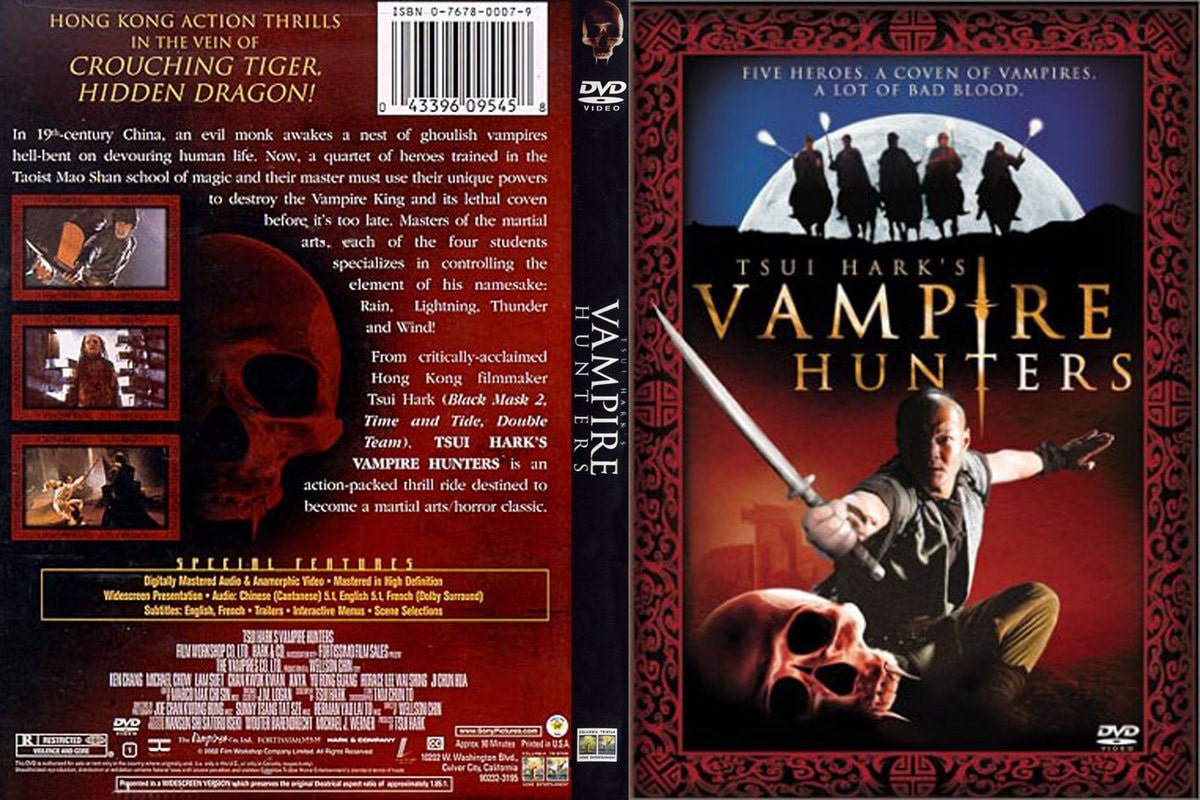 Tsui Hark’s Vampire Hunters (Film Workshop, 2002)
Tsui Hark’s Vampire Hunters (Film Workshop, 2002)
20 vampire films, all first time watches for me.
Come on — sink ’em in.
Tsui Hark’s Vampire Hunters (AKA The Era of Vampires) (2002) – PrimeThe original title is Era of Vampires, but for the North American release we end up with a spectacular bit of bait and switch trickery. Anyone who knows Tsui Hark’s work would be excited, after all, he gave us Zu Warriors from the Magic Mountain and the Once Upon a Time in China series — but we have been fooled. He produced this film, and wrote the story, but the director is Wellson Chin, better known for romantic comedies. For those of you who don’t know what this means, imagine going to see Steven Spielberg’s Jaws: The Legend Returns, and it’s directed by McG.
Anyhoo — the story is a simple one. Four Shaolin monks and their master have trained to locate and defeat vampires, but the first one they find manages to fend off 20 warriors and make the master go missing. The four (Rain, Wind, Lightening and Thunder) have a compass that points to vampire activity, and they track one to a wedding party. They infiltrate the home as party workers and try to find the monster. While all this is going on, there’s a separate band of robbers who want to find some hidden gold in the same domicile, the bride’s husband is killed, and the homeowner is covering any corpse he can find in wax. Naturally, threads and heads butt and much wire-work ensues.
The issue with this one is Chin really isn’t a very good action director. His shots are confusing and too close to the camera, and ultimately unsatisfying. There are some bonkers ideas, and the interaction between the monks is great, but overall it’s a bit weak.
One major highlight is the vampire itself — so nice to have a bloodsucker that can take on a gaggle of warriors instead of being easily staked by a surly teenager.
Check it out if you’re curious.
5/10

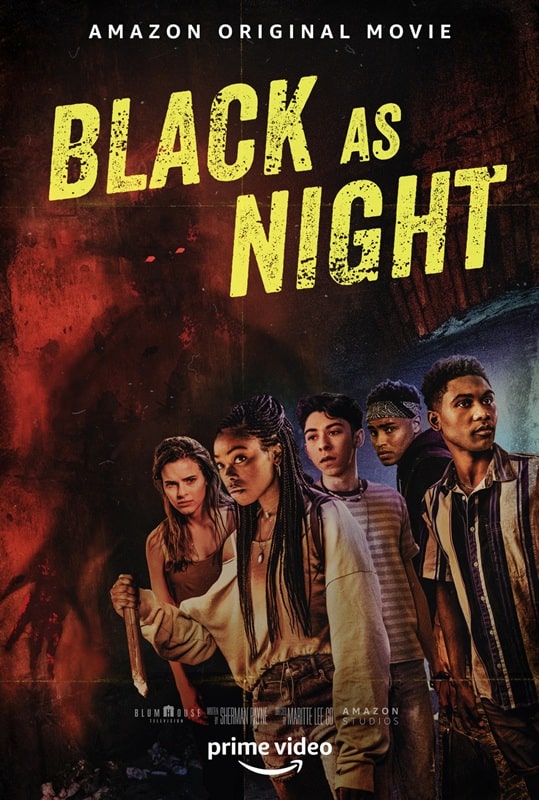
Vampie: The Silliest Vampire Movie Ever Made (Beautiful Rebellion Films,
February 14, 2014) and Black as Night (Amazon Studios, October 1, 2021)
Note, ‘Vampie’ is pronounced ‘Vam Pie’ as in ‘Meat Pie’.
I think we need to discuss the definition of ‘silly.’ When I think silly vampire movie, I think Mel Brooks’ Dracula: Dead and Loving It, or even Polanski’s Fearless Vampire Killers. A better alternative title for this one might have been Vampie: Mildly Amusing in One or Two Scenes. The rest of the time it’s a bit of a slog, hampered by a dodgy script and stilted line delivery. This is a shame, as writer/producer/star Ming Ballard and director Melissa Tracy have a potentially interesting concept, but not the chops (or budget) to make it work.
The story concerns Azure (Ballard), a centuries-old vampire who is allergic to blood. She runs a pastry shop with two friends, Tippy (Eric Strong), and Grace (Maya Merker, the highlight of the film).
Azure has a supernatural recipe item for a magical pie that she eats to stave off her blood hunger. When the pie ingredient is stolen by a rival vampire, she must get it back with the help of a Vatican assassin. That’s the plot in a nutshell.
Along the way, we get prolonged scenes of unfunny dialogue, unfunny flashbacks and a foul-mouthed chihuahua called Van Helsing. There are some moments of drama that are quite effective, but it was ultimately a chore to get through. Oh well.
4/10
Black as Night (2021) – PrimeHigh-schooler Shauna (Asjha Cooper, excellent), informs us via voiceover that what we are about witness is a crazy summer, one in which she got breasts, and killed vampires. This is no throwaway line in either respect. Shauna is 15 and riddled with anxiety, not only due to her own development, but the darkness of her skin (not helped by her brother who calls her Wesley Snipes in a wig), and her crush that she is too shy to talk to.
It’s a good way to start a film as her arc is clearly defined, but the main focus is shared between the vampires who prey on the homeless and addicted, and the after effects of Katrina, which continue to suck the very life out of the residents of this area of New Orleans. Part of the backdrop is The Ombreux, a rundown housing project that is home to junkies and the disenfranchised. This put me in mind of the Cabrini-Green inspired projects of Candyman, another film that explored the plight of black citizens framed with horror themes.
Many topics are explored in Black as Night through dialogue and one impressive speech by David Keith that touch on racism, gentrification, slavery and poverty, and these heavy issues are balanced with a frothy, Buffyesque romp featuring Shauna and her gang (best gay friend Pedro, crush Chris and vamp lit boff Granya). Moments actually put me in mind of Fright Night (inexperienced youths enter a forbidding mansion to kill bloodsuckers) and I enjoyed myself.
It’s not all great though, one villain was woefully underused, the narration started to outstay its welcome, and the actual horror was a bit lackluster, but overall, a solid film from director Maritte Lee Go, and I’m interested to see what she gets up to next.
7/10
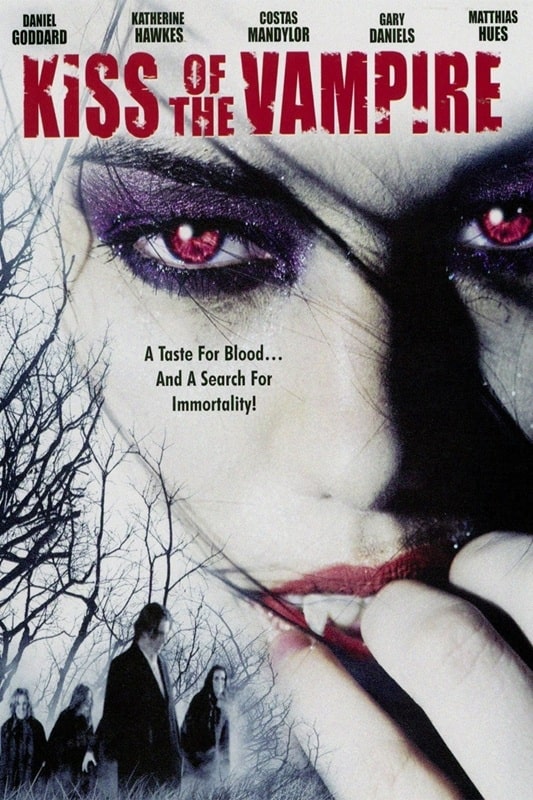

Kiss of the Vampire (Immortally Yours, January 6, 2009) and Renfield (Universal Pictures, April 14, 2023)
Ugh — we reach the halfway point and I want to chew my leg off.
I’ve stated before that I try not to rag too much on bad films, because I know first-hand how hard it is to make one (good or bad), but this one just annoyed the hell out of me. Despite having enough in their budget to lob a couple of thousand at Costas Mandylor (Saw series) and Martin Kove (everything else), the rest of the budget must have gone on craft services, because it definitely didn’t get spent anywhere else.
Especially not on sound. Scenes are barren and poorly miked, and the costumes came straight from Ruby’s Halloween bargain bin. The effects are tragic, the acting lacklustre and the story is nonsensical. I’m sure the actors were told they were making an epic based on Twilight and Underworld, with the Illuminati thrown in, but they ended up in a convoluted mish-mash of ideas, none of them concluded satisfactorily.
Avoid.
Or watch, if you’re full of self-loathing.
2/10
Renfield (2023) – PrimeA lesson to be learned here about getting your hopes up. I was pretty excited to see this one, as I desperately want Universal to have a hit (The Invisible Man is the only one they haven’t screwed up), and I love Nicholas Hoult, Nic Cage and Awkwafina (to a degree).
I knew going in that the tone would be irreverent, but I had no idea how slapstick they were going to go with the horror (an impressive blend of practical and CG), or that Cage was going to portray Dracula as if he was in Carry On Count.
I thought the concept was excellent (if a little flimsy), however I would have really dug a film closer in tone to Ready or Not or Werewolves Within. Everyone just needed to dial the lampooning down two notches. Ah well.
7/10

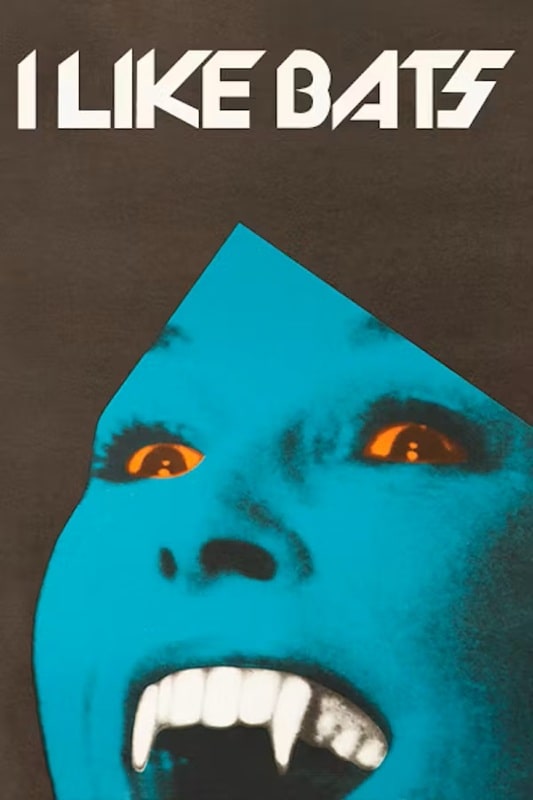
Vampires vs. The Bronx (Netflix, October 2, 2020) and I Like Bats (Zespół Filmowy, 1985)
Zoe Saldana is listed in the opening credits, and is gone after 2 minutes. Hey, it’s a good name to bait investors with, so fair play to them.
Vampires vs. The Bronx brings nothing new to the table, it evokes the kids vs monsters theme of Attack the Block and Lost Boys (even emulating Greg Cannom’s Lost Boys vampire makeup), makes several references to Blade (and copies its gnarly deaths), and is littered with in jokes (the realtor firm is called ‘Murnau’, and their logo is Vlad himself).
It might be derivative, but it also skips along at a fair old pace, helped by a charismatic group of child actors and a tongue-in-cheek script. The vampire front is a realtor company (headed by Shea ‘Skull Island’ Whigham) and the metaphors fly thick and fast as the Bronx rapidly succumbs to the soul-sucking practices of gentrification.
It’s fun, horror-lite, gateway fare for younger viewers who might be vamp-curious, and one of the few Netflix productions that doesn’t rely on green and purple gels. Worth a look if you’ve got a spare 90 mins.
7/10
I Like Bats (Lubię nietoperze) (1985) – PrimeIt’s off to Poland now, for a strange little film that can’t quite settle on a genre or tone. It’s a game of two halves, the first being the infinitely better one, but we’ll get to that.
Katarzyna Walter is Izabela, a vampire whose raison d’être seems to be ridding the world of scumbag men. General creeps, stalkers, would-be rapists, and murderers are first seduced and then sucked dry by Iza, whose overbearing aunt persistently complains about the lack of men in her life.
I enjoyed this half — with Iza in the role of avenging angel. It’s moody, gothic and beautifully shot. It also feels timeless — scenes of the contemporary town could be from decades before the mid-80s, and some clothing and vehicles feel anachronistic, but one character mentions AIDS, and we are jolted back to the correct setting.
The second half of the film is where things go awry. Iza checks herself into a psychiatric hospital in an effort to become human because she has fallen in love with the head doctor. They don’t believe her of course, however, she can’t be hypnotized or x-rayed and is soon biting the workers (her first victim is the lothario gardener who shags all the nurses in the tomato house). Then, all of a sudden, Iza is settled in domestic bliss. And that’s it.
A bit of a curio, recommended for certain types. Not saying who.
5/10
Previous Murky Movie surveys from Neil Baker include:
You Can’t Handle the Tooth, Part I
Tubi Dive
What Possessed You?
Fan of the Cave Bear
There, Wolves
What a Croc
Prehistrionics
Jumping the Shark
Alien Overlords
Biggus Footus
I Like Big Bugs and I Cannot Lie
The Weird, Weird West
Warrior Women Watch-a-thon
Neil Baker’s last article for us was Part I of You Can’t Handle the Tooth. Neil spends his days watching dodgy movies, most of them terrible, in the hope that you might be inspired to watch them too. He is often asked why he doesn’t watch ‘proper’ films, and he honestly doesn’t have a good answer. He is an author, illustrator, teacher, and sculptor of turtle exhibits. (AprilMoonBooks.com).
Tor Double #9: Isaac Asimov’s The Ugly LIttle Boy and Theodore Sturgeon’s The [Widget], the [Wadget], and Boff
 Cover for The Ugly Little Boy by Alan Gutierrez
Cover for The Ugly Little Boy by Alan Gutierrez
Cover for The [Widget], the [Wadget], and Boff by Carol RussoThe ninth Tor Double collects novellas by Isaac Asimov and Theodore Sturgeon, the only entries by either author. The Asimov’s story is The Ugly Little Boy and Sturgeon offers the oddly titled The [Widget], the [Wadget], and Boff. This volume is the first to include two stories that did not win, or even receive a nomination, for any awards. Leigh Brackett’s story in the previous volume wound up winning the 2020 Retro Hugo Award.
Theodore Sturgeon’s The [Widget], the [Wadget], and Boff was originally published in F&SF in November, 1955. The strange title is entirely fitting for the strange story Sturgeon has to tell. Just as two of the words in the title are framed by brackets, the story has a science fictional device framing it, in the form of a report by two aliens visiting Earth. In their report, which partly looks at whether or not “Synapse Beta sub Sixteen” exists in humans (and whether the species can survive without it), but also serves as an indictment of one of aliens by the other, the aliens set words in brackets when there is no exact English equivalent for what they are attempting to say.
The story framed by this conceit could have been published in any of the mainstream magazines. It tells the story of the residents of a boarding house in a small town. Bitty and Sam Bittelman run the house, which has gathered its fair share of misfits. Tony O’Banion is a successful lawyer whose privileged upbringing gets in his way, Mary Haunt is a movie star wannabee who is waiting for her break, Phil Halvorson has undefined issues, but seems to be either gay or asexual in a world which sees both as a perversion, Miss Schmidt is a school librarian who keeps to herself, and Sue Martin is a hostess in a nightclub. Sue’s three-year-old son, Robin, creates a connection between the characters.
Robin is an easy going child, whose happiness with the world around him causes most of the residents of the boarding house to adopt him. When his mother is sleeping during the day, the Bittelman watch over him. If they aren’t available, “Tonio Banion” tries to make time for him, taking him along of visits to a local amusement park where O’Banion provides legal services. Miss Schmidt cares for him at night when Sue Martin is at work.
Although Robin is not a view-point character in the story, Sturgeon does an excellent job of presenting his world view, from his mishearing O’Banion’s name as Tonio to his anthropomorphizing of kitchen appliances, such as Mitster (a mixer) or Washeen (the washing machine). Robin also has two imaginary friends, the titular Boff and Googie.
As the story progresses, Sturgeon’s focus on the residents of the boarding house slowly builds up the complexity of their relationships and personal problems. Many of the characters receive a spotlight, either as Sturgeon explores their activities or inner thoughts or when they have conversations with Bitty or Sam, both of whom have a tendency to ask probing questions of their boarders that make them reconsider their lives and choices. At the same time, Bitty and Sam are never shown as prying or anything less than nurturing.
The result is that even as their boarders begin to come to terms with the realities of their existence, either dreams that cannot be attained or the manner in which they are standing in the way of the own success, the story starts to feel more hopeful. Once their issues are realized, they are more likely to be able to take care of them. Throughout the story, reports from the two aliens who are watching them also continue to play a role, giving the indication that the growth of the individuals is caused, at least in part, by the “Synapse Beta sub Sixteen” the aliens are looking out for.
Boff and Googie are woven throughout the story, and while Robin is always aware of their activities and location, as imaginary friends, they are either dismissed or patronized by the adults in the story. The reader, aware that Boff’s name appears in the stories title, realizes that there is an importance to the characters and the manner in which the nature of Robin’s imaginary friends is revealed is clever and ties in quite well to his way of seeing the world through the eyes of a three year old.
Even if the revelations each of the characters have about themselves in response to the Bettelman’s questions can’t be considered a happy ending, each of the characters appear to be in a healthier place when the story ends, having come to terms with their position in life and finding a way to continue further in a way which will not leave them more damaged than they were at the beginning of the story.
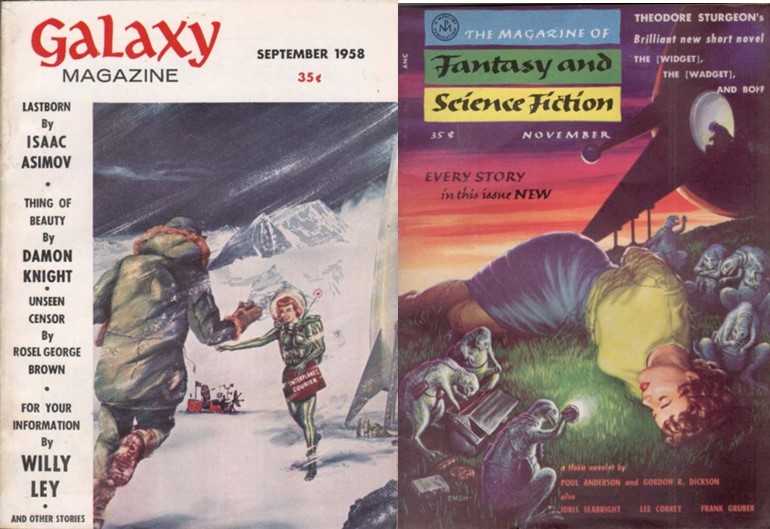 Galaxy Magazine September 1958 cover by Dember
Galaxy Magazine September 1958 cover by DemberThe Magazine of Fantasy and Science Fiction November 1955 cover by Ed Emshwiller
The Ugly Little Boy was originally published as “Lastborn” in Galaxy in September, 1958. It was nominated for the Hugo Award and the Nebula Award, winning the latter. In 1991, Robert Silverberg would publish an expanded, novel length version of the story, retitled Child of Time (although the American version of the novel would retain the title The Ugly Little Boy.
Just as three-year-old Robin is to center of The [Widget], The [Wadget] and the Boff, the titular boy in Asimov’s story is also three years old when his story begins, or at least in the flashback that shows how he got into the situation the story covers.
Edith Ffellowes is a nurse who has been hired by a company called Stasis, Inc. under the assumption that their first experiment, to bring a Homo neanderthalensis to the contemporary period. The CEO of Stasis, Inc., Gerald Hoskins, hires Ffellowes after a cursory interview in which he is mostly concerned over whether she loves all children or just pretty children. It isn’t until she shows up for the attempt to retrieve the child that she begins to understand the actual details of the job for which she has been hired.
Although Ffellowes is taken aback by the boy’s appearance when she shows up, she is a professional and works to take care of him, cleaning him up and attempting to engage with him despite the language barrier. By bringing a three year old rather than an adult, Asimov is able to ignore the cultural issues which would have arrived by bringing in a fully functioning member of Neanderthal society. It also gives him the opportunity to have Ffellowes attempt to educate the boy, who she names Timmie in a failed attempt to stop the press from referring to him as an ape-boy.
The primary purpose of Stasis, Inc’s, experiment was to bring a living creature from the Neanderthal period to the modern time, and they succeeded. The secondary purpose was to learn about Neanderthal culture and physiology. Although the latter was possible from their experiment, a three-year-old will not be able to teach them much, especially one who’s culture is infected by the teachings of a modern woman.
As the story progresses, Ffellowes works to socialize Timmie, including asking Hoskins to allow him to interact with a modern human boy of the same age. Although the initial meeting between Timmie and Hoskins’ own son, Jerry, does not initially go well, eventually the two build up a friendship of sorts, although there is always an undercurrent of tension brought on due to the differences between the boys and Hoskins’ own attitude toward Timmie. Although he generally says the right things to Ffellowes about her charge, he occasionally indicates that he sees Timmie a less than human.
Asimov’s focus with the story is on Ffellowes and the relationship she builds up with Timmie. Even as the world sees him as an ape-boy, she fights for his dignity and to teach him how to be a person. Asimov’s is less interested in the impact their relationship has on Timmie’s way of thinking, taking the point of view that there is no difference between a three year old Neanderthal and a three year old human are essentially the same, except for their physical appearance.
He also doesn’t seem to be overly interested in the ethics of Hoskins’ experiment. Hoskins’ questionable scientific ethics are apparent from the beginning, when he hires Ffellowes with only the briefest of interviews and without providing her with the information that she would need to make an informed decision. Throughout the experiment, he shows little more interest in Timmie than he does in the inorganic material Stasis also brings through, eventually attempting a similar experiment with a fourteenth century Italian, demonstrating that from an ethical point of view the company has learned nothing.
Written in Asimov’s clear style, it is similarly clear why Robert Silverberg expanded the story into a novel 34 years after its initial publication. The story is overly simplistic, offering hints and weighty issues that it could address. Similarly the understanding of Neanderthal culture advanced in the intervening years. Silverberg’s focus was more on the Neanderthal period than the ethical concerns regarding Hoskins and Stasis, Inc.’s methodology.
The cover for The Ugly Little Boy was painted by Alan Gutierrez. The cover for The [Widget], the [Wadget], and Boff was painted by Carol Russo.
 Steven H Silver is a twenty-one-time Hugo Award nominee and was the publisher of the Hugo-nominated fanzine Argentus as well as the editor and publisher of ISFiC Press for eight years. He has also edited books for DAW, NESFA Press, and ZNB. His most recent anthology is Alternate Peace and his novel After Hastings was published in 2020. Steven has chaired the first Midwest Construction, Windycon three times, and the SFWA Nebula Conference numerous times. He was programming chair for Chicon 2000 and Vice Chair of Chicon 7.
Steven H Silver is a twenty-one-time Hugo Award nominee and was the publisher of the Hugo-nominated fanzine Argentus as well as the editor and publisher of ISFiC Press for eight years. He has also edited books for DAW, NESFA Press, and ZNB. His most recent anthology is Alternate Peace and his novel After Hastings was published in 2020. Steven has chaired the first Midwest Construction, Windycon three times, and the SFWA Nebula Conference numerous times. He was programming chair for Chicon 2000 and Vice Chair of Chicon 7.
A Kind Heart and the Right Sort of Hands: Carbonel, the King of the Cats by Barbara Sleigh
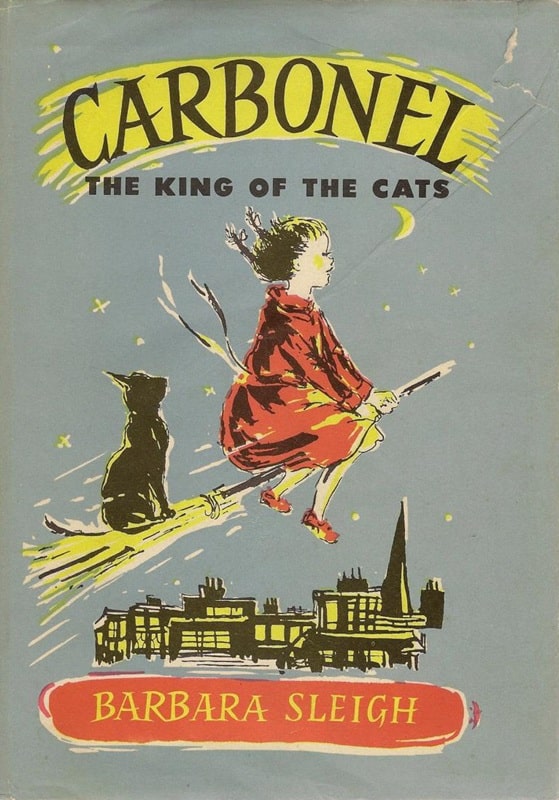 Carbonel the King of the Cats by Barbara Sleigh (Bobbs-Merrill Company, 1957). Illustrated by V.H. Drummond
Carbonel the King of the Cats by Barbara Sleigh (Bobbs-Merrill Company, 1957). Illustrated by V.H. Drummond
Over the past few years, I’ve started tracking down books I read as a child and still remember, to see what I think of them now. Some of them I’ve had to buy; but I live close to a university library, which still has others on its shelves. I just reread Barbara Sleigh’s Carbonel, the King of the Cats (illustrated by V.H. Drummond), originally published 1955, and enjoyed it enough to think it deserves a review.
Sleigh was clearly an aelurophile; this book is dedicated to one cat and to the shades of four others. I’m pleased that its feline hero, Carbonel, is a black cat (as his name suggests!) — a breed that doesn’t get as much love as it deserves. He has very convincing catlike manners, mixing condescension, sarcasm, and occasional affection. At the same time, he fits one of the classic story formulas, being a lost heir of royal birth, with a title that he hopes to reclaim.
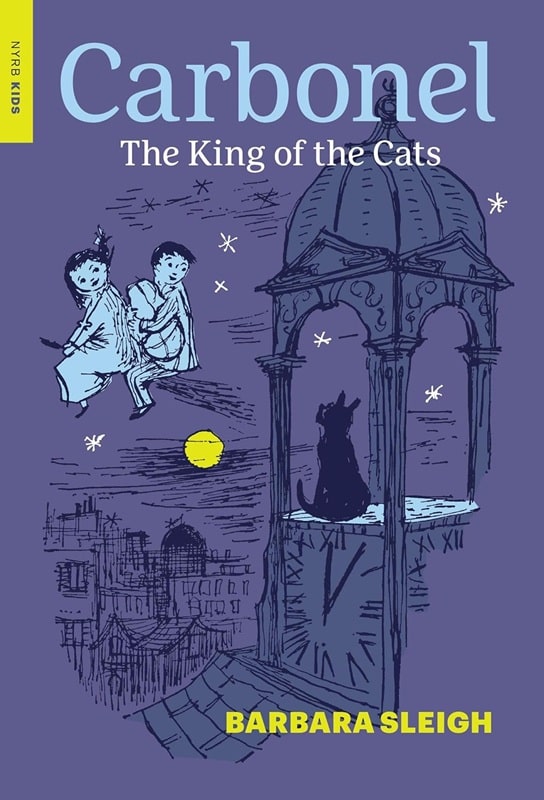 Carbonel the King of the Cats paperback edition (New York Review of Books, August 7, 2018)
Carbonel the King of the Cats paperback edition (New York Review of Books, August 7, 2018)
But the novel’s other hero is human: Rosemary Brown, a girl of ten, the daughter of a widow who supplements her pension by working as a seamstress. (Given the novel’s publication date, Rosemary’s father may well have died in the Second World War.) This is another classic formula, the child growing up under straitened circumstances — one that was still with us in Harry Potter and the Philosopher’s Stone (a much better title than the American Sorcerer’s Stone).
I have to say that Rosemary is more enterprising than Harry: When her vacation from school begins, she comes up with the idea of finding some sort of work to earn money at, in order to help her mother. (Though to be fair, there might have been far fewer obstacles to such a project in 1955 than in 1997.)
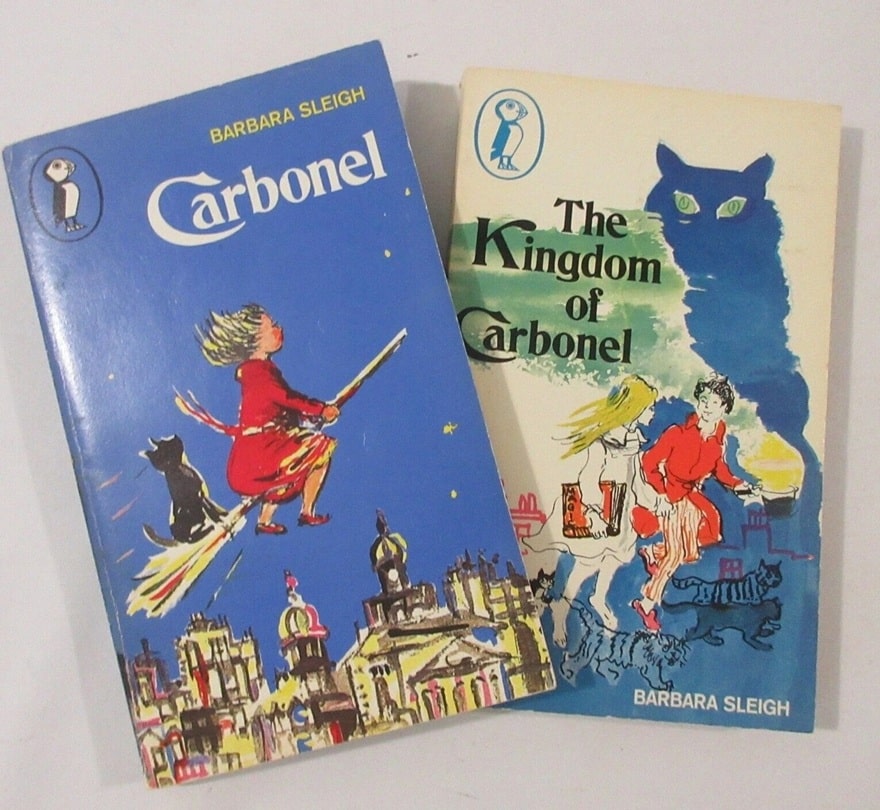 Carbonel and its sequel The Kingdom of Carbonel (Puffin paperback editions, June 1961)
Carbonel and its sequel The Kingdom of Carbonel (Puffin paperback editions, June 1961)
In any case, that’s where the adventure begins: Rosemary decides that she could earn something by cleaning and sets out to buy a broom with the contents of her money box. As it turns out, what she gets is a witch’s broom, and one that’s crudely made, with a bundle of twigs at the sweeping end, and on the verge of falling apart.
But she also gets the witch’s cat, with her last three farthing, and learns that the broom not only flies, but grants her the power to understand what the cat says to her. Unfortunately, it’s not suited for the kind of indoor cleaning Rosemary has in mind: It looks more like a gardener’s broom.
 Illustration by V.H. Drummond
Illustration by V.H. Drummond
But Carbonel, the cat, brings his own complications: He’s still bound by a spell the witch cast on him, and can’t reclaim his heritage and give the feline kingdom a proper ruler until he’s set free. And the conditions for doing so entangle Rosemary and her newly made friend John (the nephew of one of her mother’s customers) in a long series of complications.
I thought they were ingeniously worked out and had just the kind of odd magical prohibitions that are proper to a fairy story; and the resolution of Sleigh’s plot also resolves several other issues that came up earlier, from a small theatrical troupe’s troubles to the career of a retired witch. I really thought this book showed a lot of ingenuity in tying everything together.
 Carbonel the King of Cats
Carbonel the King of Cats
I was also struck by a point I missed when I read this as a child, because of the other things I hadn’t read: In one chapter John figures out something significant and cites a maxim of Sherlock Holmes’s to explain how he did it — one from “A Scandal in Bohemia,” the story that gave us Irene Adler. I don’t know if I would have understood a story about royal love affairs and potential blackmail when I was 10, and perhaps John doesn’t, either. But clearly at least part of the story stayed with him.
Sleigh does a good job both of making the reader sympathize with Rosemary, and through Rosemary’s own sympathy of making the reader sympathize with Carbonel. Both of them were entertaining characters, and they made me feel that my private project is being worthwhile.
William H. Stoddard is a professional copy editor specializing in scholarly and scientific publications. As a secondary career, he has written more than two dozen books for Steve Jackson Games, starting in 2000 with GURPS Steampunk. He lives in Lawrence, Kansas with his wife, their cat (a ginger tabby), and a hundred shelf feet of books, including large amounts of science fiction, fantasy, and graphic novels. His last article for us was a review of Dorsai! by Gordon Dickson.
A Hand-Crafted World: Karel Zeman’s Invention for Destruction
Is there anything more dispiriting than the ceaseless quest for novelty, especially when it seems bound to end in disappointment? It’s something I feel just about every time I turn on the TV. We’ve never had so many viewing choices, but so often everything feels reheated, recycled; we’ve seen it all before. The genuinely different is so rare that when you do see it, you know it — and you never forget it.
Sometime in the 70’s I saw an old black-and-white movie on television; it was called The Fabulous World of Jules Verne and it was the most extraordinary-looking thing I had ever seen. Guess what? I never forgot it.
A few years later I saw a movie on the late-night tube about the world’s greatest liar, Baron Munchausen. This time I couldn’t say that I had never seen anything like it because there was one thing that it reminded me of — The Fabulous World of Jules Verne. It was only years later that I learned that both films were the work of the Czechoslovakian director, Karel Zeman.
Zeman was born in 1910 in Austria-Hungary, and after spending most of his twenties working in advertising in France, in 1936 he returned to his home in what had become Czechoslovakia and began to work his way into the film business. He managed to survive both the Nazi occupation of his country during World War Two and the following grey decades of Czech subserviency to the Soviet Union, making films, both shorts and full-length features, that existed in — that created — a stubbornly non-political realm of beauty and humor and eccentric individuality. He died in 1989, shortly before the collapse of the Eastern European satellite regimes.
A few years ago, Criterion released Jules Verne under its original 1958 title, Invention for Destruction, along with 1962’s The Fabulous Baron Munchausen and another Zeman film, 1955’s Journey to the Beginning of Time, in a beautiful Blu-ray set titled Three Fantastic Journeys by Karel Zeman. It has a place of honor on my shelf, and it deserves one on your shelf, too, for Invention for Destruction alone; I guarantee it really is like nothing you’ve ever seen before.
Exactly what was it that I found so striking, so indelibly memorable about Invention for Destruction? What still makes it a jaw-droppingly unique movie, even after all the cinematic and technological innovations of the past seven decades? What made it the most internationally successful Czech film ever (a propaganda success that blessedly kept the cultural commissars off his back)?
Well, imagine that you’re looking at an old book, let’s say a volume of Jules Verne, lavishly illustrated with quaint nineteenth-century steel engravings. Now imagine that those obsessively, almost insanely detailed black-and-white images of Verne’s incredible creations begin to move, begin to assume a reality that overflows the pages of the book to finally become the entire visible world. That’s Invention for Destruction.
Zeman lays his cards on the table in the first scene of the movie, which begins with a narrator browsing through a volume of Verne, looking at page after page of illustrations, until the last one, an engraving of a steamship at sea, begins to move; while still retaining all of the sharp-edged, fine-lined qualities of the original picture, the waves roll, the sidewheel turns, smoke billows from the smokestack, and the camera cuts to the deck of the ship, where we meet our main character, an assistant to a renowned inventor, and the story is off and running. We have literally fallen into a book.
The achievement is all the more amazing because it was done, not with CGI, but with good, old-fashioned legerdemain, with practical effects and camera tricks that go back to the dawn of cinema.
In speaking of Zeman’s methods, Phil Tippett, who supervised the dinosaur animation for Jurassic Park, said,
He employed a technique where he would set up his shots in multiple planes — say you would have a stop-motion character or a live actor shot against… a flat that had painted on it this architecture, and maybe in front of that there would be cut-outs, kind of like a matte painting.
It sounds simple, but when you consider that the entire world of the film was created this way, that virtually every single shot consisted of these multi-layered set-ups, often combined with forced perspective and in-camera split screens, you begin to realize that such a film must have been fiendishly difficult to plan and shoot.
The ultimate effect is not realistic, but hyperreal (at times even hallucinatory), and the movie is filled with something that even the best CGI is unable to convey — the human wit and charm that only comes from something that visibly maintains its connection with the hands of the craftsman who shaped it.
Director and animator John Stevenson (Kung Fu Panda) summed up the Zeman difference perfectly:
Karel Zeman is one of the great magicians in cinema, right up there with Georges Méliès, with Willis O’Brien, George Pal, Ray Harryhausen, and he really should be considered part of that pantheon of people who put extraordinary images into the public consciousness. But what other people like George Pal, Ray Harryhausen, Willis O’Brien were trying to do — their illusions were designed to be as, if not “realistic”, as believable as possible; they wanted you to believe that somebody was fighting a dinosaur or being carried around by a twenty-five-foot gorilla. Karel Zeman invites and audience to come into a completely hand-made, hand-crafted world, and to accept that nothing they’re going to see looks believable or realistic… he was activating that part of the brain that allows you to make a fort out of the cushions of the settee and believe it’s a fort or get in a cardboard box and believe it’s a spaceship or a pirate ship.
Zeman’s highly stylized mixed-media method, his artful and humorous juggling of live-action, stop-motion, puppets, paper cut-outs and anything else he could think up, worked perfectly for Jules Verne (an author he loved as a child), allowing him to act as a master showman, giving us a buoyant nineteenth-century dream of mechanical progress… but a dream that may easily shade into nightmare if the anticipated progress does not take the course we want it to. (Hence the threat implicit in the double-edged title: an Invention, yes… but for Destruction.)
The movie’s plot is largely taken from Verne’s 1896 novel, Facing the Flag, a book that is often seen as a quasi-prediction of the atomic bomb. The novel blends science and geopolitics in a story in which an inventor creates an explosive that is far more powerful than any ever seen before. (Many of the film’s images are taken directly from the engravings that Léon Benett did for the first edition of the novel.)
Zeman (who co-wrote the script as well as directed) uses Verne’s tale as a Christmas tree on which to hang his delightful and amazing ornaments, and Invention for Destruction is a movie replete with wonders enough to satisfy the appetite of every boy — or girl — who ever loved a ripping yarn. (Zeman once said, “I have only one wish: to delight the eyes and heart of every child.”)
In the world as envisioned by Verne through Zeman, all of earth’s realms have been subdued and transformed by the hand of scientific man: the land is continually crisscrossed by steam locomotives, steam-powered automobiles, and in one indescribably odd scene, by camels on roller skates; the air is crowded with balloons, balloon-cycles, pedal-powered one-man airplanes, and enormous, dreadnought-like airships upheld by dozens of propellers; the sea is swarming with commercial steamships, warships, and submarines large and small – to say nothing of an enormous octopus or two, which, as every lover of Jules Verne movies knows, always spells trouble.
It’s a world with castles perched on rocky promontories from which innocent inventors are kidnaped at midnight at the behest of a monomaniac millionaire and spirited away to an isolated island, where they are forced to work on an enormous cannon which will enable the madman to blackmail the world with explosive shells which could obliterate entire cities.
Image after image is quirkily spectacular or spectacularly quirky. The most amazing sequence is probably the one in which a submarine rams a ship, sending it to the bottom, after which the sunken vessel is looted by divers riding pedal-powered underwater aquabikes… which are equipped with bells, just like any paperboy’s bicycle. The scene ends with an undersea swordfight and though it only lasts six minutes, it’ll take you three times that long to watch it because you’ll be backing it up every thirty seconds, which is true of the film as a whole, at least the first time you watch it.
Paradoxically, for me the movie’s most memorable and resonant image is one of its simplest. As our hero (the inventor’s assistant) and heroine (a young woman from a looted ship who is a prisoner on the island) escape in a balloon, the inventor thwarts his captor’s evil scheme by detonating one of the explosive shells and vaporizing the great gun, the evil millionaire, and the island itself. Zeman sums up the results of the inventor’s brave action in a beautifully eloquent shot: we see a gentleman’s silk top hat, the emblem of bourgeois nineteenth-century elegance, respectability, security, sail silently into the immense sky, becoming smaller and smaller… pause in its ascent… and then fall into the empty sea below.
As much as I trust my ability with words, in this instance I don’t think you should rely on my descriptions of Karel Zeman’s astonishing achievement, because I’m afraid my words aren’t up to the task — I think you should see for yourself:
Well, was I lying?
In this era when CGI has become so sophisticated, so pervasive, and so pro forma that it is increasingly incapable of genuinely surprising or delighting us, where filmmakers can show us literally anything and therefore there is often nothing that they can show us that really excites us, the work of Karel Zeman is a revelation and a tonic. It can awaken that much-maligned but very real thing, a sense of wonder, and it can truly make you feel like a kid again, looking with unclouded eyes at a world in which new marvels are waiting around every corner.
If you watch Invention for Destruction and his other fabulous films, I think you’ll agree that Karel Zeman achieved his ambition and more; his passion was so deep and his vision so inspired and his craft so meticulous that it’s not only the eyes and hearts of children that he succeeded in delighting.
Thomas Parker is a native Southern Californian and a lifelong science fiction, fantasy, and mystery fan. When not corrupting the next generation as a fourth grade teacher, he collects Roger Corman movies, Silver Age comic books, Ace doubles, and despairing looks from his wife. His last article for us was The Old-Fashioned Way: Tove Jansson’s Hobbit Illustrations
Trope Subversion, Level: Master
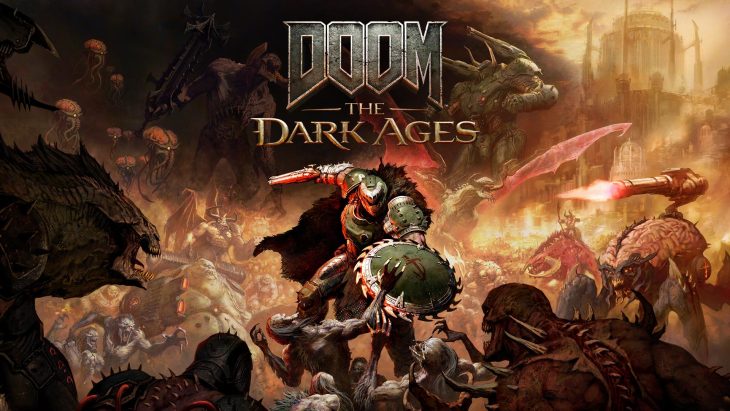
Good afterevenmorn, Readers!
If video games aren’t your thing, you’re not going to like my post today. With the release of Doom: The Dark Ages and let’s plays popping up all over my YouTube feed, I’m going to nerd out today about Doom for a moment. Actually, I’m going to nerd out about one specific cutscene in Doom: The Dark Ages because it flips a common horror trope to highlight the mythology of the main character so perfectly, I’ve been nerding out since I saw the clip during an episode of Jacksepticeye’s let’s play just a little over a week ago. Welcome to my new hyper-fixation.
Before I get into the scene exactly, we’re going to have to dive into the history and lore of Doom.
 Doom, Released 1993
Doom, Released 1993
The first Doom game released in 1993. To be perfectly honest, I had little to no interest in the game in 1993. I was not yet aware of what an incredible medium for story-telling video games can be. Besides, video games were for boys, and weren’t art anyway, so I wasn’t going to engage. Look, 1993 me was a bit of a snob… and very, very wrong. Mostly. Doom was (and remains) a hyper-violent game, which can be a bit much. But there is a story in there, and as the games progressed, the story has become increasingly well-written and executed. What is that story?
Well, an unnamed marine is sent to Mars as punishment for striking his commanding officer when his commanding officer ordered him to fire upon unarmed civilians. I immediately like the guy. On Mars and its moons Deimos and Phobos, the UAC (United Aerospace Corporation) is conducting teleportation experiments and they accidentally open a portal to Hell. Actual Hell. The hot place with all the demons and things.
Well, all those demons and things pour through, and it’s up to this punished marine to obliterate the Hellish host. Which he does, cutting through the demons like a man possessed. That was terrible. I will be here all week.
At the end of the the game, we discover the head of a white bunny on a pike — the unnamed marine’s (whom we’re now calling Doom guy) pet bunny Daisy, setting up an entirely fresh hatred for the armies of Hell (incidentally, I don’t think it’s an accident that John Wick’s puppy is called Daisy. Space Marine John Doe did not go John Wick on the minions of Hell, John Wick went all Doom Guy on the criminal underworld).
 Doom 2, Released 1994
Doom 2, Released 1994
In Doom 2, our hero Doom Guy is called into action again. Earth has been overrun, and he is once again called to take on the armies of Hell in an effort to save humanity. I believe that the two games are set very close together in the timeline. Fueled now by the rage engendered by the loss of his pet bunny (so goofy, and I love it. Also, he supposedly also lost his wife and child, but the big fuss is about the bunny. I’m still figuring that one out) as well as his own innate goodness, Doom Guy once again goes on a rampage. All the same frenetic gameplay and gore.
1996 gave us The Final Doom (it was not, in fact the final one). In this one the UAC, having learnt nothing, I guess, establishes a base on Jupiter’s moon Io. Once again, the UAC manages to open a portal to Hell, and Doom Guy is once again the one who comes to the rescue, tearing through Hell’s minions to save humanity. Poor guy. Bet he has some pretty hefty trauma from it all.
 Doom 64, Released 1997
Doom 64, Released 1997
A year later, and Doom 64 is released on the Nintendo 64. Doom Guy is pulled out of retirement to once again battle Hell. This time, he means for it to be for good (it was not for good). At the end of the game, after defeating the Demon Mother, Doom Guy realizes that the only way he can keep Hell’s forces away is to draw them away. In what can only be described as an incredible act of insanity (you thought I was going to say courage, right? Sometimes the two are indistinguishable), he elects to remain in Hell, fighting demons until he dies (he does not die).
And that’s where he remains. We learn in later games that he is such a savage in Hell, he has become their bogey man. He is their monster under the bed. Say his name in a magma pool three times and he appears behind you and takes your head off.
All is quiet on the Doom front until 2004, in which Doom 3 was released. No one can quite figure out how it fits into the timeline, and while the studio assures us that it is canon, our Doom Guy can’t be the protagonist. He is in Hell for this events of this game. The best fans have come up with is that it’s a different unnamed space marine. The world will never know his name. We salute you, brave sir.
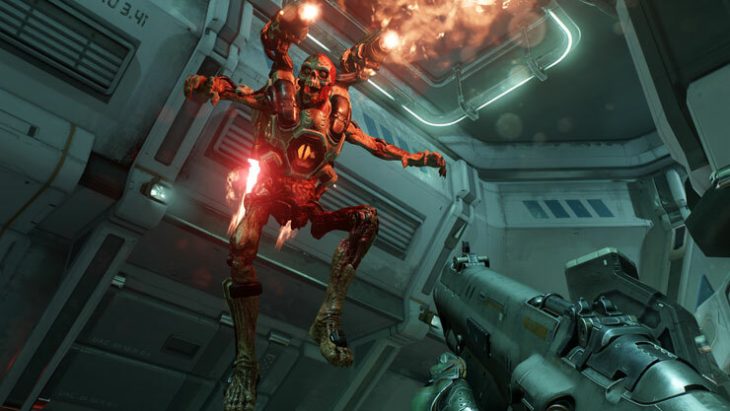 Doom 2016 – The soft reboot of the original
Doom 2016 – The soft reboot of the original
It’s another eight years before Doom returns to the gaming world. And this is where we start jumping around in the timeline.
In 2016 we get Doom (2016), and a return to the original Doom Guy. In this game, the UAC —Again! Someone take away their funding!— unleashes Hell again when a certain Dr. Pierce attempts to use Hell’s energy in order to solve an energy crisis on Earth. The obvious result is, of course, that Hell once again invades. In this game, Doom Guy has been sealed away in a sarcophagus for centuries, and has acquired a new moniker. Ladles and jelly spoons, introducing the Doom Slayer. He awakens in an overrun facility on Mars, and immediately begins to rip and tear (quite literally) through the demonic ranks.
This is the game where we start to get story cutscenes, and you’re expected to piece together the story from both these scenes and the gameplay. From this game, you get that the Doom Slayer is the avatar of rage. However, he saves that rage for the demons only. Humanity is safe from him.
With the help of the AI Vega, and UAC Scientist Dr. Hayden, who has managed to transfer his consciousness into an android, the Doom Slayer travels between realms, finds the Crucible (the weapon capable of closing the Well facilitating the invasion) and seal the Well. But Dr. Hayden turns on the slayer. After assuring him that the Well has been sealed, Hayden takes the crucible and teleports the Doom Slayer back to Mars in a betrayal that would surprise no one who paid attention during the game.
 Doom Eternal, released 2020
Doom Eternal, released 2020
Four years later, the next instalment in the Doom series is released. Doom: Eternal. Taking place after the events of Doom (2016), Doom: Eternal is where we start to get some depth to our protagonist. We discover that he survived his stay in Hell. Found by humans from the realm of Argent D’nur, he is a traumatized mess of a man. But the Sentinels (the knight-warriors) of Argent D’nur see in him a great deal of potential. He enters their ranks.
The gods of Argent D’nur are the Elemental Wraiths, but there are those who have begun to worship the Maykrs; basically techno-angels. They were allies at one time. We learn in one of the flashbacks that a rogue Maykr known as the Seraphim imbues the Doom Guy with near God-like power. This is how he became the Doom Slayer, instead of just Doom Guy.
In this game, the UAC has been thoroughly corrupted, becoming basically a Hell-worshiping cult. It is also revealed that the leader of the Maykrs has made a pact with Hell. In order to maintain the prosperity of the Maykrs, she has agreed to provide Hell with worlds to invade, in exchange for Argent power, created from the suffering of Human souls. And, well, she’s invaded Earth. Well, the Doom Slayer is having none of that. Time to rip and tear again.
And he does.
This is the important thing. Doom Guy, AKA the Doom Slayer, had thwarted Hell’s invasions thrice before going to live full time in Hell. He survived Hell, he made it out (was a complete wreck, but he made it out), he joined the ranks of warriors who battled Hell (before the Maykr’s betrayal), and then thwarted Hell again centuries later (in Doom (2o16)), and then AGAIN in Doom: Eternal, where he also obliterated the leader of the Maykrs. The man is too angry to die. No Hellion has managed to kill him. All who have faced him have perished.
Hell is terrified of him (and not just Hell).
And boy did the director make that plain in the cutscene of Doom: The Dark Ages that caught my attention and made me nerd out enough that I’m writing about it here… because I had to gush to someone, and you’re that person. Sorry and or you’re welcome.
(Doom: The Dark Ages is a prequel, taking place before the events of Doom (2016). The let’s play I’m following hasn’t concluded yet, so I’m not sure about the story exactly, so I can’t summarize it for you yet.)
The manner in which the cutscene plays makes it abundantly clear that the Doom Slayer is a monster to monsters. His entrance is reminiscent of countless horror movies. He cuts through a heavy locked door. The drop of his weapon, a flail, reminds me of the Witch King of Angmar as he faces Eowyn on the battlefield in Return of the King. The way he drags it on the ground, sparks flying, as he walks slowly towards his target (the demon Prince Ahzrak), is straight out of Silent Hill (Pyramid Head, anyone?). The way he keeps coming — an unstoppable force of nature— is reminiscent of Halloween.
Here, see for yourself:
The dude is a horror villain. Except he’s on our side. It flips the horror trope so beautifully that I was rooted to the spot while watching, and then immediately geeked out. And have been geeking out for about a week.
I cannot express how much I love this inversion. It’s excellent visual storytelling. Beyond everything you learn throughout the games, this one scene shows the player exactly who the Doom Slayer is, and what he is to the demons. He is not trapped in a facility on Mars with the armies of Hell. The armies of Hell are trapped in a facility on Mars with him. And it’s great.
Anyway, thanks for letting me nerd out for a moment. I’ve really made this a long one. You’re a champion if you made it all the way to the end. I don’t really have a question for you this time around. I’m still marveling over that cutscene. So instead, I’ll wish you all a wonderful day and an even better week.
When S.M. Carrière isn’t brutally killing your favorite characters, she spends her time teaching martial arts, live streaming video games, and cuddling her cat. In other words, she spends her time teaching others to kill, streaming her digital kills, and a cuddling furry murderer. Her most recent titles include Daughters of Britain, Skylark and Human. Her serial The New Haven Incident is free and goes up every Friday on her blog.
By Crom: Marvel, Roy Thomas, and The Barbarian Life
So, back in January of 2022, I did a post on Roy Thomas and the Marvel Conan comic he created in the seventies. I never read that comic. But for some reason in 2019, I decided to buy the first of what turned out to be his three memoirs about the series (mostly about the first 115 issues, which constituted his first run with Conan), and also one of the Marvel Omnibuses that had been put out recently. I ended up getting four of the high-quality Omnibuses, which are those 115 issues he covered in his books.
And I just finished, a couple years later, the first 100, which culminated with the death of Belit, from “Queen of the Black Coast.”
I also recently started the Savage Sword of Conan Omnibus, which ran around the same time, and was black and white. It’s a more ‘literary Howard’ comic, and definitely different than the color Conan one (also less popular).
Below is the original post I did. Then, an additional section, having read through the first hundred. I think this comic is definitely a must for Conan fans. I prefer some of these stories to the Tor pastiches. They’re not all good, of course, but I have enjoyed my read through. And I cannot recommend enough, getting Thomas’ three books. Read one comic issue, then the accompanying short chapter from his book. It’s a terrific experience. Read on, MacDuff (a little literary malapropism for you).
One Black Gate series which I have started, but is still for somewhere down the line, is a look at the first dozen-or-so issues of Roy Thomas’ Conan the Barbarian comic. And even before running that series, I intend to write one for the second dozen-ish, so I can tie together the various overlaps. This was prompted by a combination of the over-sized Marvel hardback Omnibuses, and Roy Thomas’ TERRIFIC (now) three-volume memoir about the series, from Pulp Hero Press.
I never read the series, growing up. I bought some of the Dark Horse collections, which I liked. And when Marvel reacquired the rights and put out that first door-stopper compendium, I bought it. And I liked it enough to get the next three. I was buying them in conjunction with Roy Thomas’ Barbarian Life. The first Thomas volume covered the genesis of the comic, and the first fifty-one issues – which happened to be the same ones included in the first Omnibus.
Thomas helmed the series for 115 issues – which is how many are covered by the first four Omnibuses (both series’ talk about other issues as well). So, Thomas’ three books complement the Omnibuses perfectly. I read a story, and then I read Thomas’ insights. Along with the relevant commentary in the Omnibus itself. It’s a real Conan treat!
Thomas would write other color Conans for Marvel, and return to it over the years. And he would also contribute to Dark Horse while they had the rights. But it’s that first run, when he was Stan Lee’s right hand, and he made Conan a best-selling property for Marvel, which fans revere.
At the same time, Thomas was running the black-and-white The Savage Sword of Conan, (originally Savage Tales. That’s another post some day)which was more risque, and told a more in-depth story (LOTS of words). It’s a very different experience than Conan the Barbarian, and Marvel has collected those in Omnibuses as well.
Conan the Barbarian ran for 275 issues, from 1970 to 1993. That’s pretty amazing, as when it debuted, Conan was not the well-known figure he is today.
Here’s an excerpt from the first part of the planned Black Gate series:
An awful lot of people were introduced to Robert E. Howard’s Conan (best known as ‘The Barbarian’) through L. Sprague de Camp’s paperback series first from Lancer, and then, Ace. They featured those fantastic Frank Frazetta covers that are still popular today.
And in the early eighties, Arnold Schwarzenegger starred in two popular Conan movies that set the standard for fantasy movies until Peter Jackson’s amazing Lord of the Rings trilogy. The sword-swinging former governor of California is the image of Conan many people still have today.
In between those two ‘sources,’ came Marvel Comics’ Conan the Barbarian, with Roy Thomas in charge for the first 115 issues of a much longer run.
De Camp is justly criticized for rewriting Howard’s prose: Robert E. Howard did not need to be ‘edited.’
He has taken somewhat less-justified abuse for the Conan pastiches he wrote – by himself, and with Lin Carter, and Byron Nyborg. While they certainly can be criticized, in general; they deserve to be more fairly assessed than they are, I feel. I like most of them.
While Director John Milius did incorporate some elements from Howard’s original stories, Schwarzenegger’s Conan is a far cry from the original creation. Thomas co-wrote a screenplay for the second Conan movie, but Milius didn’t use it. It forms the basis of The Horn of Azoth comic book, from Marvel.
And Roy Thomas and Barry Smith certainly created their own version in the comics. But Thomas liked Howard’s writing and included much of it. Even though it didn’t feature a superhero, Marvel’s comic was one of the most popular of the seventies and eighties, unlikely as that seems. As is the case with de Camp’s paperbacks and Schwarzenegger’s movies, the Conan comic book was how many people discovered the sword-swinging barbarian. And its importance in the history of Conan cannot be minimized.
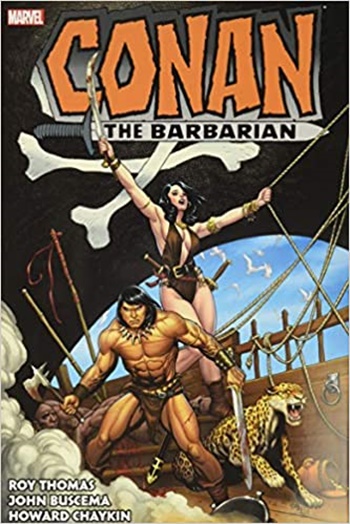 I’ve always got a couple of things in the works for here at Black Gate, but I’d really like to get to this Marvel Conan the Barbarian (CtB) series. Is the comic canonical? – no. But Thomas really draws on the source material. And not just the original Conan stories. I’ve already written a 1,500-word essay on The Grim Grey God, which is one of my favorite REH historicals. And it was adapted for Marvel issue number three. It’s terrific! Thomas (with some effort and wrangling) also got to use some of de Camp’s stories as well.
I’ve always got a couple of things in the works for here at Black Gate, but I’d really like to get to this Marvel Conan the Barbarian (CtB) series. Is the comic canonical? – no. But Thomas really draws on the source material. And not just the original Conan stories. I’ve already written a 1,500-word essay on The Grim Grey God, which is one of my favorite REH historicals. And it was adapted for Marvel issue number three. It’s terrific! Thomas (with some effort and wrangling) also got to use some of de Camp’s stories as well.
I’ve read a LOT of Sherlock Holmes stories which have NOTHING to do with the original character. They’re complete bastardizations of Arthur Conan Doyle’s creations. I’ve had several Holmes stories published, and I try very hard to write the character Doyle created.
Thomas’ Conan is recognizable as Howard’s Conan. No, not exactly the same. But he didn’t just slap the Conan name on a barbarian and draw whatever the heck he wanted to.
BTW – the series will talk about how it was almost Lin Carter’s Throngor, not Conan, that was going to be the hero of the strip. Circumstances barely conspired to result in it being Conan!
Each Omnibus has an introduction from Thomas, talking about the various issues. The comics themselves are in glorious color. I’ve seen some criticism of the quality of the reproduction. I think it’s fine. Easy to read with good lighting (my eyes are getting old – like me). The text is clear. Colors are distinctive. Seeing that splash page, and the color, full-size, is terrific!
There are a bunch of extras at the end of each book, including some artwork, essays by Thomas, and other miscellany. I believe that each volume has been about 800 pages of Conan goodness.
Thomas had written an extensive history of his Conan Marvel experiences for Spanish publication. That work was translated into English, revised, and expanded: and that makes up the three volumes of Barbarian Life. He shares his memories in each volume. Comments on the story, inker, problems, things he liked about them – just great stuff for a fan of the series. A ton of info.
So, the first four, with Thomas’ three-book series, gives you a detailed look at the first 115 issues; with additional topics covered. It’s no surprise Thomas talks a fair amount about his other Conan series, the black-and-white Savage Sword of Conan. And the Omnibuses even include an issue or two.
The Omnibuses are $125 when they come out, but they drop below $100 relatively quickly. They have sold out, though Titan seems to be republishing theri version. I haven’t gotten Volume 5, as it marks the beginning of the post-Thomas Era. Marvel’s King Conan, based on de Camp’s later pastiches, start coming out this summer in Omnibus form.
I really enjoy Thomas’ three books. They are a treat to read. And obviously, being able to read the issue he’s talking about makes it a better experience. I recommend his books, and the accompanying Omnibuses. I have paperbacks of Thomas’ books, for research purposes. But I also have the first two as e-books, and I love the color covers in them. They look great on my Kindle Fire.
Now, if I could get around to writing that series for Black Gate…
UPDATE – MAY 2025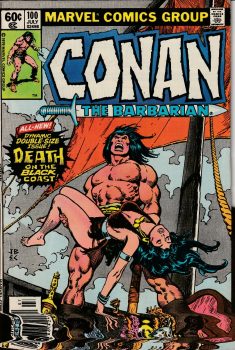 I really enjoyed quite a few of the early issues. #3 was one of my favorite REH historicals, based on “The Grim Grey God. That was immediately followed by the classic “Tower of the Elephant.” #7 was “The God in the Bowl.”
I really enjoyed quite a few of the early issues. #3 was one of my favorite REH historicals, based on “The Grim Grey God. That was immediately followed by the classic “Tower of the Elephant.” #7 was “The God in the Bowl.”
Thomas continued to mix in non-Conan stories, and fragments, by Howard. “Queen of the Black Coast is one of the most popular Conan tales. Thomas built his tenure around this story. Issue #57 was devoted to what resulted in the opening of “Queen,” ending with Conan galloping towards the docks. #48 recounts the first part of Howard’s story, with Conan joining Belit’s crew on the Tigress, and becoming Amra (The lion).
Thomas would get to the second and concluding part, 43 issues later in #100 (in a double-length issue). There were flashbacks, and a few solo adventures, but he had Conan and Belit adventure for about three and-a-half years. Thomas comments that the Miller and Clark timeline (tacitly endorsed by Howard himself) had them roaming for three years.
But there’s plenty of Conan and Belit in this first hundred issues. Belit and Red Sonja (who in Howard’s original stories is nothing like the chainmail bikini clad warrior here) appear in a few issues together. They do not become bffs.
Elric of Melnibone comes by (twice, I think). A John Jakes plot is used, but it’s not one of Brak the Barbarian’s. Thoth Amon emerges as a foe of Conan.
El Borak, Steve Clarney, and Kull, are among those REH characters whose stories are converted to Conan. And many one-off REH stories. Literary estate executor Glenn Lord worked well with Thomas, allowing Marvel to buy the rights to use many REH works (originally Marvel had the character, but not the Conan stories, though that changed).
There’s plenty of original Conan, but it’s cool to see so much Howard – and other writers’, including Norvell Page (separate post coming on that one). I enjoy reading non-Conan stories, such as “Out of the Deep,” rewritten for Conan (that’s a cool Weird Menace story).
I am going to switch over and read some Savage Sword of Conan, having bought the first two Omnibuses. I also skipped over most of the included Annuals, added to the end of each Omnibus. Volume Three had and Annual with the first Conan story, “The Phoenix on the Sword,” which has always been a favorite of mine.
I’ll get back to the final fifteen Thomas stories, which are post-Belit.
But I think that the Conan comic was quite good. If you’re going to check it out, I HIGHLY recommend getting at least Thomas’ first memoir. The books absolutely enhance the experience, issue by issue.
Jeffrey Talanian wrote an essay on Thomas and Conan, which you can read here.
And, this page has ALL of my Robert E. Howard essays here at Black Gate. I’ve written quite a bit.

Bob Byrne’s ‘A (Black) Gat in the Hand’ made its Black Gate debut in 2018 and has returned every summer since.
His ‘The Public Life of Sherlock Holmes’ column ran every Monday morning at Black Gate from March, 2014 through March, 2017. And he irregularly posts on Rex Stout’s gargantuan detective in ‘Nero Wolfe’s Brownstone.’ He is a member of the Praed Street Irregulars, founded www.SolarPons.com (the only website dedicated to the ‘Sherlock Holmes of Praed Street’).
He organized Black Gate’s award-nominated ‘Discovering Robert E. Howard’ series, as well as the award-winning ‘Hither Came Conan’ series. Which is now part of THE Definitive guide to Conan. He also organized 2023’s ‘Talking Tolkien.’
He has contributed stories to The MX Book of New Sherlock Holmes Stories — Parts III, IV, V, VI, XXI, and XXXVII.
He has written introductions for Steeger Books, and appeared in several magazines, including Black Mask, Sherlock Holmes Mystery Magazine, The Strand Magazine, and Sherlock Magazine.
You can definitely ‘experience the Bobness’ at Jason Waltz’s ’24? in 42′ podcast.
Transcendent and Creepy: Rich Horton on The Forever War by Joe Haldeman
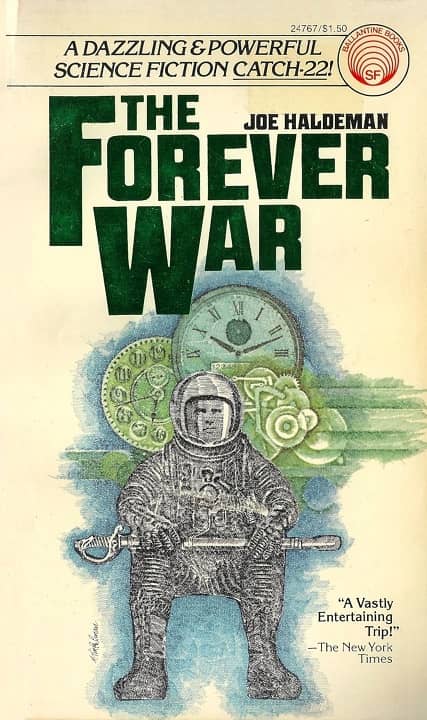
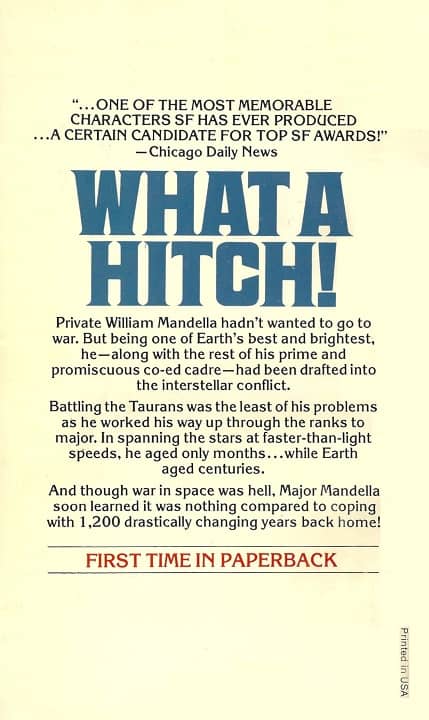
The Forever War (Ballantine Books, 1976). Cover by Murray Tinkelman
Rich Horton continues to review classic science fiction novels at his blog, Strange at Ecbatan. Last month he turned his attention to Joe Haldeman’s The Forever War, on the 50th anniversary of its release.
It’s definitely worth reading — a bitter and cynical look at war, some cool ideas including the effect of time dilation and lots of physics, a somewhat transcendent but pretty creepy conclusion. And, also, some very ’70s things, including pretty questionable — at times downright offensive — “sexual revolution” era sexual politics, and oddly 70s-ish notions of dystopia. My impression… I liked it then and I endorsed its Hugo and Nebula wins.
The Forever War is one of the most honored science fiction novels of all time. First published by St. Martin’s Press in 1975, it swept every major SF Award, including the Hugo, Nebula, and Locus awards. In 1987 it placed 18th on Locus’ list of All-Time Best SF Novels, beating out The Martian Chronicles, Starship Troopers, and Rendezvous with Rama. It’s been in print nearly continuously for the last four and a half decades. Here’s some of the most noteworthy editions.
[Click the images for bigger versions.]
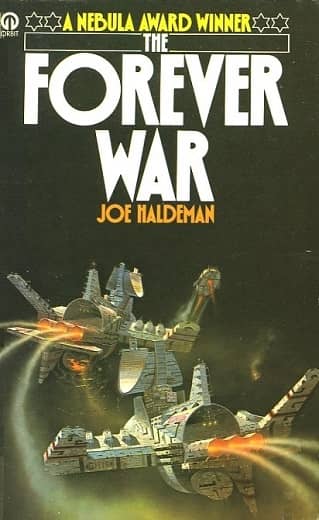

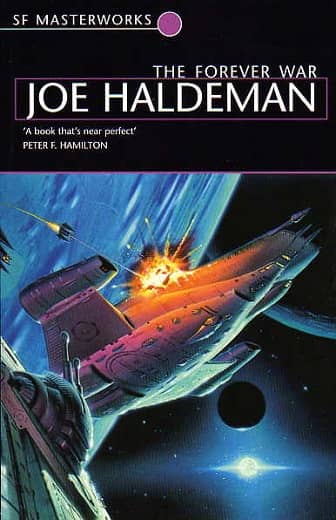
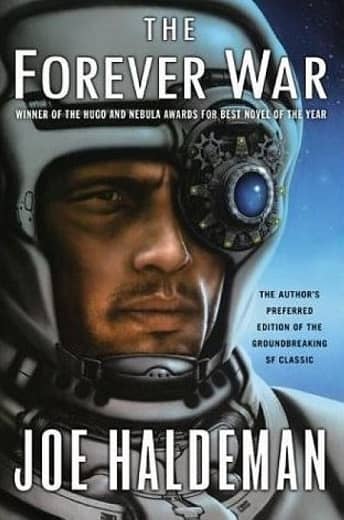
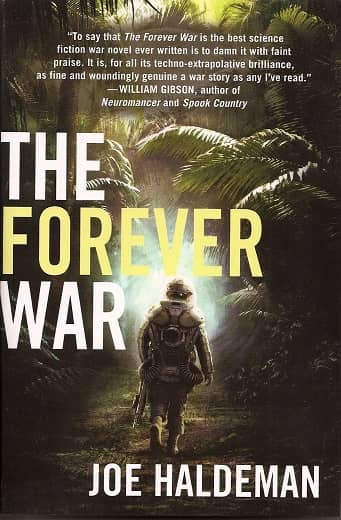
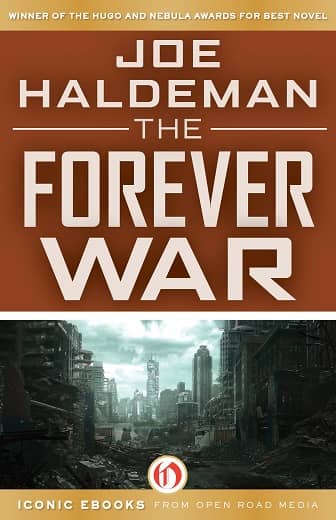
Three decades of The Forever War. First row: Orbit (1976), the first unexpurgated edition (Avon, 1991),
and the Gollancz SF Masterworks edition, with Author Notes (1999). Covers by Patrick Woodroffe,
Dorian Vallejo, and Chris Moore. Second row: Eos (2003), St. Martin’s Griffin (2009), and
Open Road (2014). Covers by Jim Burns, Tomislav Tikulin, and Michel Vrana.
So what’s the book about? Here’s Rich again.
William Mandella is drafted into a war against the aliens, there are several very impressive battle scenes, he falls in love with fellow soldier Marygay Potter, they are separated by time dilation, the war ends when it is realized the whole thing was a mistake due to poor communication, Marygay waits for William by flying back and forth in a spaceship until time dilation means their timelines are synchronized again…
What did I think on a reread? It’s still a pretty effective book. The telling is cynical in a totally believable way. The Army scenes ring very true — and Haldeman would certainly be a better authority than me anyway. The soldiers are foulmouthed, dislike their commanding officers, but fairly disciplined if only because the alternative is dying…
It’s very exciting, and well-written. The battle setups are interesting, and seem like a plausible use of the technology Haldeman invents. Some of this tech is pretty implausible, but in an almost believable fashion. The new section, originally called “You Can Never Go Back”, concerns William and Marygay’s return to Earth after their battles, at which time they are eligible to muster out. They describe at thoroughly decayed Earth society, in a very ’70s fashion. Homosexuality is [encouraged] as a population control measure (though — as Mandella even points out — birth control is pretty easy to enforce anyway.) Haldeman’s depiction of homosexuality is mostly positive, I suppose, but there are some cliches, which I understand he regretted in later years. The rest of the depiction of Earth at that time seems a bit over the top — but partly it’s a device to make it plausible that the two of them reup.
As Rich notes in his review, the early (pre-1991) editions of The Forever War were significantly abridged, omitting the entire middle section. The 1991 edition restored most of the expurgated sections, but left some some clumsy changes from the early edits intact. It wasn’t until 1997 that Avon published a version that Haldeman considered definitive.
See the complete details on the publishing history of The Forever War here at Black Gate, and read Rich’s complete review at his blog here.
You Can’t Handle the Tooth, Part I
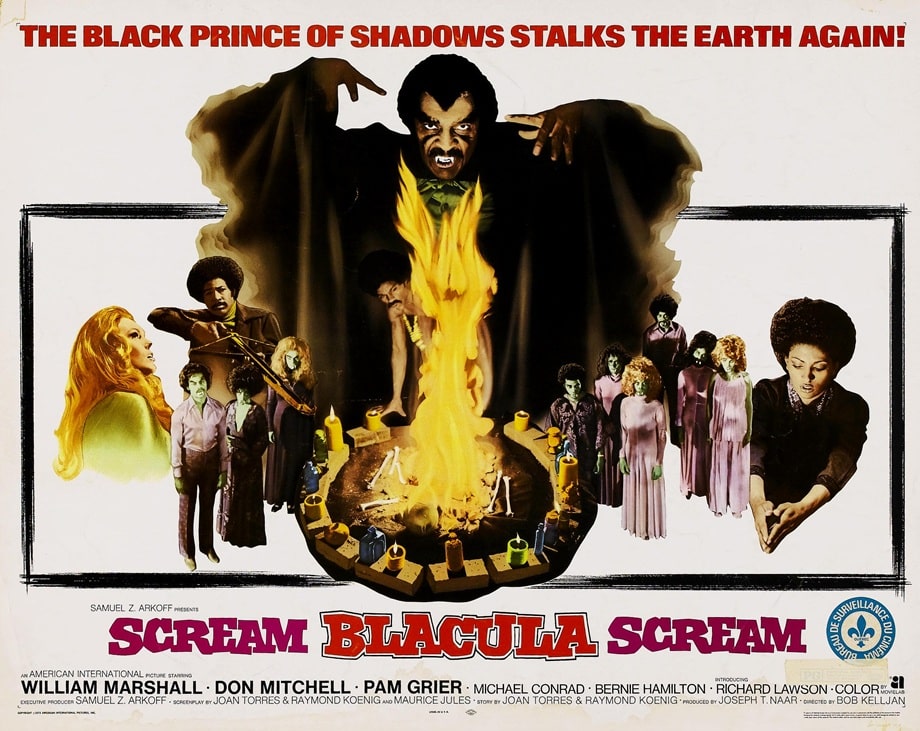 Scream, Blacula, Scream (American International Pictures, June 27, 1973)
Scream, Blacula, Scream (American International Pictures, June 27, 1973)
20 vampire films, all first time watches for me.
Come on — sink ’em in.
Scream, Blacula, Scream (1973) – TubiI’ve seen Blacula (1970) plenty of times, but somehow never got around to watching the sequel, and thank the stars I did, because it’s excellent. I think I like it even more than the original.
If you are new to this nonsense, the original film told the tale of an African prince who is bitten by Dracula and becomes a bloodsucking fiend on the streets of L.A., tapping all jive turkeys he comes across. It’s obviously a product of the Blaxploitation era, but its dodgy premise is saved by the presence of William Marshall. For my money, Marshall can stand toe-to-toe with Christopher Lee as one of my favorite depictions of the count (so to speak). Like Lee, he brings much gravitas, animalistic savagery, and raw sex appeal to the role, along with one of the best voices in the business.
This sequel though has the added bonus of Pam Grier at her height of acting skill and gorgeousness, and a voodoo sub-plot that adds an extra layer to what is ultimately a tragedy. Marshall brilliantly walks the line between monster and victim, and it doesn’t matter how many other players are in the scene, he and Grier keep you mesmerized.
A wonderful start to a new project — onwards and upwards!
8/10
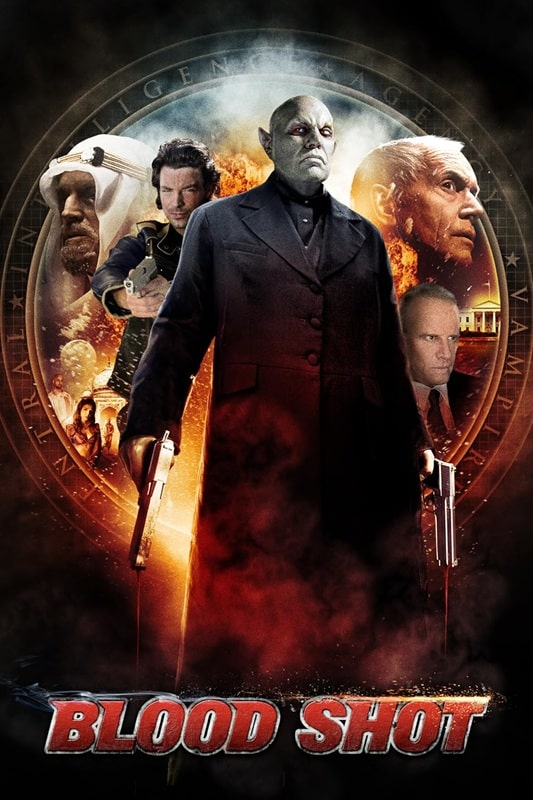

Blood Shot (Infinite Justice Productions, 2013) and Night Teeth (Netflix, October 20, 2021)
Nope, not the quickly forgotten Vin Diesel actioner from four years ago, nor the other Blood Shot from 2013 starring Danny Dyer, this one is a straight to video chunk of sparkly tomfoolery featuring brief cameos from a lot of actors who need new patios.
In a nutshell, the CIA has a special division that employs the services of the last living vampire to take out terrorist threats to the US of A. This vampire (Michael Bailey Smith — wonderful) is a wise-cracking brute of a Nosferatu, and an effective hitman (bitman?). However, his missions are often hampered by a dogged detective, played with maximum grizzledness by Brennan Elliott, who is determined to kill the vamp. His attempts to kill the bloodsucker grow successively funnier as he exhausts his collection of tricks (garlic-filled shotgun shells etc.), all the while getting the snot kicked out of him. Things come to a head when a nefarious gang on a manic jihad arrive in the city, ready to unleash a nuclear bomb, and the vampire and detective must reluctantly team up to take them down.
First of all, I wasn’t expecting anything from this, but I had a splendid time. The snippy buddy-cop routine between the two leads was excellent and there were some genuinely funny moments.
It’s not all YIKES-free though.
A close squint at the poster will reveal Brad Dourif in brown-face and hook-nose prosthetic as ‘Bob’, the jihad organizer whose real name is too long so everyone shortens it. He’s not the only white actor playing a character of Middle-Eastern descent, so be forewarned. It’s a bizarre decision, but perhaps in keeping with the irreverent nature of the story. Also, if you do decide to take a look, don’t be put off by the seizure-inducing first 10 mins. It settles down quickly, possibly because the editor got tired or had to go to hospital.
A cautious recommendation.
7/10
Night Teeth (2021) – NetflixFirst up, I don’t like this title. It’s awkward to say and isn’t very interesting. Secondly, this is a Netflix film, and I like that they are producing so many films and giving newish directors a crack, but I’ve reached the point where they all look the same to me. Same lighting, same editing, same polished ‘product.’
That’s what they’re knocking out. Not films. Content.
Anyhoo, on a more positive note, I liked the idea of L.A. being split into five, vampire-run, districts, and one uppity bloodsucker attempting a coup during the course of one night. The monster on the power trip is Victor (of course), played by Alfie Allen (Theon Greyjoy of GoT), and he has sent his faithful hitwomen out to do the dirty deeds. The bitey ladies, Zoe (Lucy Fry) and Blaire (Debbie Ryan) need a driver for the night, and the hapless Benny (Jorge Lendeborg Jr.) ends up filling in for his brother, who is up to shenanigans. As Benny drives the women from slaying to slaying, he slowly figures out what is going on, and then has to fight for survival.
It’s a potpourri of borrowed ideas from the likes of the Underworld and John Wick films (especially the secret society with rules), and could have been spectacular, but leaden writing and wooden delivery (particularly from Sidney Sweeney and Megan Fox in a 5-minute cameo) let it down. I was really impressed with Ryan and Lendeborg Jr. though, and could stand to see them in more projects.
Recommended if you like glitz and exposition.
6/10

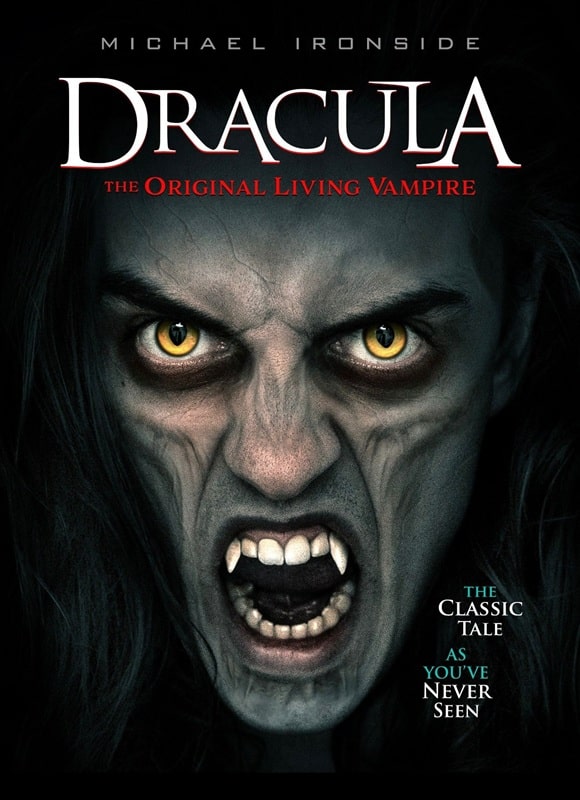
Vampires on Bikini Beach (Beacon Films, 1988) and Dracula:
The Original Living Vampire (The Asylum, January 28, 2022)
Remember the 80s? That glorious time when the best vampire films came out? Fright Night, Near Dark, Lost Boys, Innocent Blood, Vamp, et al. What a time. Anyhoo, writer/producer/director Mark Headley thought “Hey, folks love vampire flicks, and they like bikinis, and my pal needs an 80-minute promo video for his dull band, I got it!” and so this film came to be, and it was bad.
Here’s the skinny: some boring teens find a boring book that has something to do with some boring vampires in the most boring parts of Venice Beach. Boredom ensues.
It’s so shoddily written, acted and filmed, that it can’t even be considered as a ‘so bad it’s good’ flick; it’s just aggressively rubbish. It’s the first hate-watch I’ve done in a while, which is amazing considering all the crap I watch.
Recommended.
1/10
Dracula: The Original Living Vampire (2022) – PrimeCue arguments about whether vampires are technically ‘living.’
Anyhoo, when the words ‘The Asylum presents’ flash up on screen, they tend to trigger a Pavlovian response in that my expectations are immediately quashed. This is a very healthy attitude, and can sometimes lead to a pleasant surprise. Not this time, however.
D:tOLV is a weird film. It really doesn’t know what it wants to be — a horror film, police procedural, or a comedy. I don’t suspect the latter was intentional. It allegedly takes place in the UK, which for some reason is depicted as a turn of the (previous) century Austrian town transplanted to the Carpathians, complete with mountain-top castle. The clothing is early 20th C, houses are lit by candle light and some bulbs, Van Helsing carries a luger, and characters say stuff like ‘it’s above my paygrade.’
Anachronisms aside, it’s an interesting twist on the tale. Amelia Van Helsing is a police detective working with Captain Renfield. Amelia works closely with mortician Dr Seward (Michael Ironside, briefly phoning it in), and chemist Jonathan Harker, as the group tries to solve the murders of a bevy of red-haired women, all drained of blood. When Van Helsing’s girlfriend, Mina, gets targeted by Drac, they must rally forth and get on with some slaying.
This premise is let down by some pretty bland acting (Amelia and Dracula in particular were wrongly cast) and a great deal of dull conversation. I mean, a LOT of conversation. 50% of the film is Harker and Van Helsing pulling a Mulder and Sculley – the twist being that Van Helsing doesn’t believe any of it. The other 50% is filled with Seward talking to himself, some lacklustre action, and a couple of sex scenes to ensure there are some knockers for the foreign markets. Wasted potential.
Minus another point for the bad grammar on the poster.
4/10
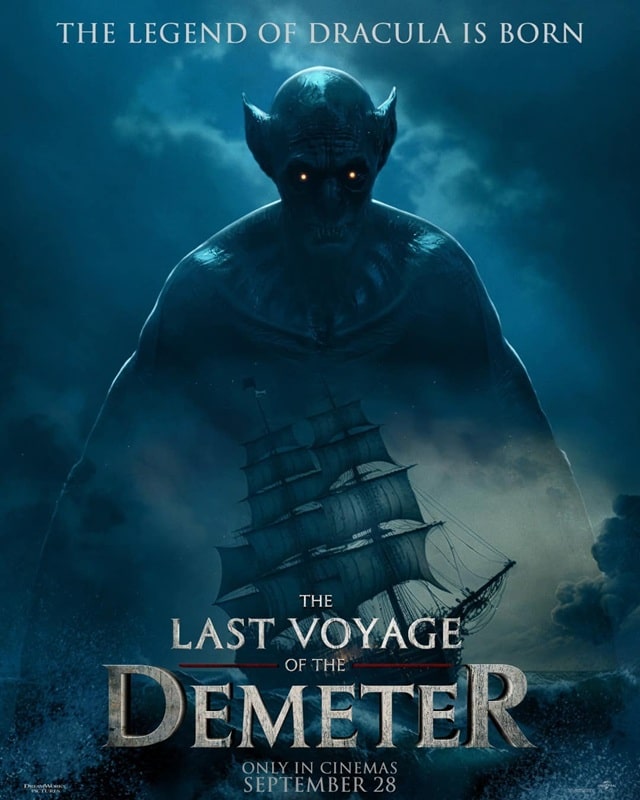
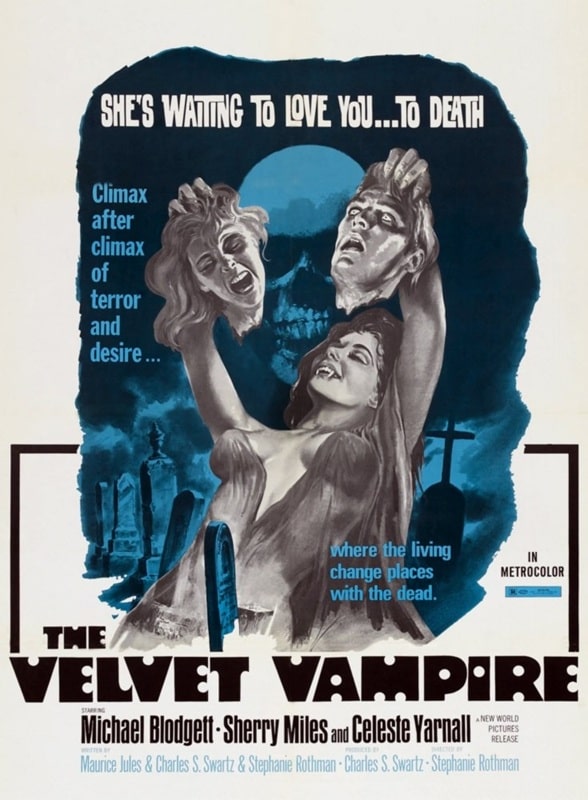
The Last Voyage of the Demeter (Universal Pictures, August 11, 2023)
and The Velvet Vampire (New World Pictures, June 1971)
The untold story of the doomed Demeter from Bram Stoker’s Dracula has long been a gothic tease for horror fans. It has been touched upon in other films (and was my favorite part of the recent Dracula adaptation by Mark Gatiss and Steven Moffat), but my anticipation was riding high when I heard André Øvredal was directing a version of the story. Øvredal is responsible for Troll Hunter and The Autopsy of Jane Doe, two of my favorite films, and with a cast fleshed out by the likes of Liam Cunningham and Corey Hawkins, how could it go wrong? Well, it didn’t, but it also didn’t go spectacularly either.
It looks good, and the performances are great, but there was something about it that didn’t quite work for me. Perhaps it was the repetitive, episodic feel of crewmembers being bumped off one by one while exposed on the deck during the night watch, maybe it was Dracula himself. I loved the design of the vampire, but his face didn’t do it for me. His savagery was undeniable though, and the effects, a seamless blend of practical and CG, were top notch. Hawkins’ character, Clemens, offered up an interesting angle being not only a man of science, but also black, in a time when Eastern Europeans would have been remarkably intolerant. He does touch upon this, but I feel it could have been explored further.
Cunningham is the captain of the ship in every sense of the word, elevating every scene he is in, and the skeleton crew do their jobs well, even if they are largely forgettable aside from the reliable David Dastmalchian. I went into this assuming it would be a ten-out-of-ten movie, but it gets eight from me, partly because I hyped it up too much for myself, and partly because an awesome sequel is hinted at but the box-office was so dire that, like Dracula, it will never see the light of day.
8/10
The Velvet Vampire (1971) – PrimeIt would be remiss of me not to include a title from the Roger Corman stable, so here we are, with a notable title for several reasons. Firstly, it was directed by Stephanie Rothman, a trailblazer in the film industry and responsible for a clutch of genre-bending flicks. Rothman leaned into the fluid sexuality of vampires, no doubt prompted by the recent success of Hammer’s lesbian vampire films (Vampire Lovers, Twins of Evil, Lust for a Vampire), and adapted a story, Carmilla, written in 1872 by J. Sheridan Le Fanu. Carmilla is considered to be the first lesbian vampire story ever published, and the lead antagonist, Diana Le Fanu, is named after him as a direct homage.
The tale concerns Sarah and Lee, a swinging married couple who encounter Le Fanu at an art gallery (where the actual Johnny Shines is playing a fantastic tune), and the enigmatic Le Fanu invites them to stay at her remote home in the middle of the Mojave desert. By this point, Le Fanu has already killed a would-be rapist in the opening scene, so we are well aware of her strength.
Car trouble forces the couple to start walking, but then Le Fanu turns up in a dune buggy (!), and takes them back to her place. After that, not much happens. There’s some walking around, a bit of jealous chat, and some semi-erotic dream sequences, but you will have to wait about 40 mins for someone to actually get bitten.
Naturally, shenanigans ensue.
Is it a great film? Not particularly, but you can see why it’s a cult classic. Lee’s casual promiscuity, Sarah’s blank-faced screaming, Diane’s bisexual seductions, some early electronic scoring, and some lovely color design (look for all the red bits) are certainly worth a look if you don’t have anything more pressing to attend to.
5/10
Previous Murky Movie surveys from Neil Baker include:
You Can’t Handle the Tooth, Part II
Tubi Dive
What Possessed You?
Fan of the Cave Bear
There, Wolves
What a Croc
Prehistrionics
Jumping the Shark
Alien Overlords
Biggus Footus
I Like Big Bugs and I Cannot Lie
The Weird, Weird West
Warrior Women Watch-a-thon
Neil Baker’s last article for us was Part VII of Tubi Dive. Neil spends his days watching dodgy movies, most of them terrible, in the hope that you might be inspired to watch them too. He is often asked why he doesn’t watch ‘proper’ films, and he honestly doesn’t have a good answer. He is an author, illustrator, teacher, and sculptor of turtle exhibits. (AprilMoonBooks.com).
Tor Doubles #8: Leigh Brackett’s The Nemesis from Terra and Edmond Hamilton’s Battle for the Stars
 Cover for The Nemesis from Terra by Tony Roberts
Cover for The Nemesis from Terra by Tony RobertsCover for Battle for the Stars by Bryn Barnard
This volume includes the story Nemesis from Terra by Leigh Brackett and Battle for the Stars, byt Edmond Hamilton. There are two significant distinctions for this volumes. The two authors represented were married to each other and one of the stories was previously included in the Ace Double series. The Tor Double was originally published in May 1989.
The Nemesis from Terra was originally published as “Shadow Over Mars” in Startling Stories in Fall, 1944. It was previously published as part of an Ace Double (F-123, with Robert Silverberg’s Collision Course) in 1961. The Nemesis from Terra is the first of three Brackett stories to be published in the Tor Doubles series.
Although set on Mars in the far future, as with many of Brackett’s Martian stories, The Nemesis from Terra feels more like a fantasy novel than a science fiction novel. It is a descendant of the Mars of Edgar Rice Burroughs and could easily be classified with the stories of Robert E. Howard, neither of which is a surprise.
Rick Urquhart is the main character of the novella, although to call him a protagonist gives him more agency than he really has. From the earliest pages, in which he ducks into a doorway to avoid the anthropoid Martians who are tracking him down and hears an old woman prophecy that his shadow will extend over Mars until the final pages, he is more reactive to events, whether they are forcing him into a course of action or he is attempting to avenge wrongs perpetrated on him.
His life isn’t entirely horrible. While escaping the clutches of the evil Terran Exploitation Company, run by Ed Fallon and his henchman Jaffa Storm, Rick meets Mayo McCall, and the two fall instantly in love, although there seems little reason for their affection. Rick is also the subject of Kyra’s love, a young winged Martian girl, who sees in him the future of Mars.
Of more interest that the plot or Rick himself, is Brackett’s complex depiction of her Martian society. Made up of humans and Martians, the humans, like Fallon, are looking to exploit the planet. There seem to be multiple races of sentient Martians who are not unified. The Martians led by Haral, the last of his line, possess the Collar of Ruh, which signifies legitimacy to rule. The Thinkers are a legendary race of Martians who may have plotted out the planet’s history before disappearing. The winged race to which Kyra belongs lives in their own city, mostly not venturing forth.
Brackett briefly explores all of these civilizations, as well as Fallon’s Company, his competitor, Hugh St. John, and briefly mentions regulatory agencies which deal with Martian and interplanetary trade. The result is a complex society, but one which Brackett is not able to fully explore and Rick is buffeted by all of their forces to fulfill the old woman’s prophecy.
Although the prophecy regarding Rick is uttered in a small, secluded room, the contents of the prophecy become generally known without agency. Although Rick initially fights against the idea that he will one day rule Mars, a concept which puts a target on his back for all of the various entities Brackett has created. However, Despite the love that Mayo and Kyra seem to feel for him, Rick’s self-centeredness makes him hardly a sympathetic figure for the reader. Not evil, especially when compared to Fallon and Storm, Rick doesn’t seem to believe in anything and never really changes. His motives are almost entirely self-preservation and vengeance. Even Mayo, who purportedly loves him questions whether the prophecy is right about him and whether she wants to see him succeed. The only complete affection for Rick that is shown is by Kyra, who Rick seems to see more as a tool to be used than as a person.
Brackett’s complex Martian society demonstrates that even at this early stage of her career, this was her first novel, although she had been publishing short stories for eleven years, shows her strengths. While characterization is a weakness in The Nemesis from Terra, that is also an area in which Brackett would eventually improve.
Although Brackett and Hamilton first met in 1940, they didn’t marry until 1946 and remained together until his death in 1977. Brackett survived her husband by thirteen months, during which time she worked on the first draft of a sequel to Star Wars, which was ultimately not used, although she received a writing credit on the film The Empire Strikes Back.
 Startling Stories Fall 1944 cover by Earle K Bergey
Startling Stories Fall 1944 cover by Earle K BergeyBattle for the Stars cover artist unknown
Battle for the Stars was originally published as a stand-alone novel by Dodd, Mead in November, 1961. Edmond Hamilton began publishing in 1926, and although his earliest stories appeared in Weird Tales and were Lovecraftian and Howardian in their feel, he eventually turned his attention to science fiction, writing the 1940s Captain Future stories. And eventually for DC Comics. He gained the nickname “World Wrecker” for the wake of destruction that occurred throughout his stories.
Given that reputation and the title Battle for the Stars, it would seem clear that this novel, which was originally published in 1961, would not only include the promised battle of the title, but also the destruction of worlds, although as it happens, Hamilton shies away from that trope in this novel.
Commander Jay Birrel leads the Fifth Squadron and reports to Ferdias, the leader of Lyra Sector, one of many galactic sectors that is jostling for supremacy in a galaxy in which Earth has fallen to a backwater planet. Lyra sector’s main rival is the Orion Sector, and the novel opens the one the Orion’s agents, Taucer, attempting to torture Birrel, who manages to escape.
Birrel is ordered to lead the Fifth Squadron to Earth, not to invade the planet, but to serve as an emissary from Lyra on the occasion of the bicentennial of the first spaceflight. Ferdias is aware that there are rumors that he is trying to conquer the Earth, and in addition to assuring Birrel that it isn’t the case, he tells Birrel that the Fifth Squadron will be accompanied by a variety of other ships that includes the civilian dependents of the soldiers of the Fifth Squadron.
To make things more interesting, Birrel is married to Lyllin, a Lyran woman who has no desire to leave her native planet, but understands that Birrel’s duty can splash onto her. She is more concerned about the fact that three of Birrel’s ancestors are from Earth, giving him closer ties to the planet than most, and she worries about the planet’s pull on him and whether they will ultimately be able to return to Lyra or if he will chose to remain on Earth, a notion Birrel finds ridiculous since he has never visited the planet and has no real desire to.
Birrel and Lyllin’s relationship is one of the weaker points of the novel. The two characters don’t really seem to know each other or even talk to each other. If Lyllin makes her concerns known, Birrel pushes them aside. He orders her around as if she were serving on one of his ships without noticing that she is his wife and doesn’t feel she should have to follow his order.
However, Hamilton’s strength shows through in his treatment of the political situation. When ordered to Earth, Birrel reminds Ferdias that he is not a diplomat, but his dealings with the Terrans Charteris and Mallinson help move the Lyran agenda along. At the same time, Despite Birrel knowing that the Lyrans are on Earth merely to help celebrate the bicentennial of spaceflight, the reader is constantly wondering if Charteris and Mallinson are correct that the Lyrans desire to conquer the Earth. Ferdias clearly hasn’t told Birrel everything and the reader can only surmise the plans that have not been revealed to him.
Part of Birrel’s orders involve him visiting the small town of Orville, New York, where his great-grandfather lived. Although his connection in Orville doesn’t go as intended, Hamilton creates a welcoming small town that remembers when Birrel’s ancestors lived there and welcome him as one of his own, despite his protestations. These sections display a nostalgia that is not typically associated with Hamilton’s writing and Orville almost feels like the sort of rural community Clifford D. Simak wrote about.
Ultimately, the Terrans must decide whether they distrust the Lyrans or the Orionids more, for if the Orionids attack, as Birrel believes that will, they will need Lyran help to fend them off, but the rumors swirling are that any attack on each will come from the Lyrans. The fact that Birrel is raising the alert level of the Fifth Squadron in response to his believes about the Orionids only causes the Terrans to take actions that make him continue to raise the alert level, making the Terrans that much more sure of his intentions.
The political situation facing Birrel and the Terrans is complex, but at the same time, it seems overly simplistic. Hamilton has created a system in which, although his focus is on the Lyrans, Terrans, and Orionids, there are several other sectors that come into play. On a more micro level, once Birrel arrives in Orville, the very friendliness of the locals raises questions of paranoia. Which of them are in the employ of the Orionids or the Terrans. Which of them hold a grudge against Birrel for something done by his ancestors. The personal aspects of Orville adds an entire unexpected facet to the story.
The cover for The Nemesis from Terra was painted by Tony Roberts. The cover for Battle for the Stars was painted by Bryn Barnard.
 Steven H Silver is a twenty-one-time Hugo Award nominee and was the publisher of the Hugo-nominated fanzine Argentus as well as the editor and publisher of ISFiC Press for eight years. He has also edited books for DAW, NESFA Press, and ZNB. His most recent anthology is Alternate Peace and his novel After Hastings was published in 2020. Steven has chaired the first Midwest Construction, Windycon three times, and the SFWA Nebula Conference numerous times. He was programming chair for Chicon 2000 and Vice Chair of Chicon 7.
Steven H Silver is a twenty-one-time Hugo Award nominee and was the publisher of the Hugo-nominated fanzine Argentus as well as the editor and publisher of ISFiC Press for eight years. He has also edited books for DAW, NESFA Press, and ZNB. His most recent anthology is Alternate Peace and his novel After Hastings was published in 2020. Steven has chaired the first Midwest Construction, Windycon three times, and the SFWA Nebula Conference numerous times. He was programming chair for Chicon 2000 and Vice Chair of Chicon 7.
The Old-Fashioned Way: Tove Jansson’s Hobbit Illustrations
Okay — close your eyes and visualize Middle-earth. I can’t be certain what you’re seeing behind your eyelids, but I think I have a good chance of guessing; five will get you ten that whatever you’re conjuring bears a strong resemblance to the Alan Lee Lord of the Rings book illustrations and to Tolkien’s world as envisioned in Peter Jackson’s films (on which Lee and John Howe did much of the production design).
The austere, rather chilly (once you’re out of the Shire, anyway) Lee/Howe template has become the default picture of Middle-earth for many — if not most — people, but there are other ways to view Tolkien’s realms and their inhabitants. I have already sworn my fealty to the first such visualization that I ever encountered: the beautiful Tim Kirk paintings that were featured in the 1975 Tolkien Calendar.
I am also partial to another version that’s not nearly well enough known, the gorgeous illustrations done by Michael Kaluta for the 1994 Tolkien Calendar. (Kaluta is probably best known for his comic book work, especially on the 1970’s Shadow for DC.)
One thing that makes both Kirk’s and Kaluta’s art so attractive to me is that its depiction of Middle-earth is just different from the one that has become the current standard. (Kaluta’s work is especially striking because it is so extravagantly colorful compared to Lee’s and Howe’s bleached-out work.)
Also, please understand, I — who cannot draw a straight line — am not criticizing the fine work of Lee and Howe or any other artist, merely pointing out that there are other, equally fruitful ways of looking at Tolkien’s creations.
All of which is to say that there’s more than one way to skin an orc — or draw a dwarf — and alternate visions can come from unexpected places, as I found out last Christmas when my daughter Samantha gave me a gift that was a real surprise — a Finnish edition of The Hobbit. Instead of coming from an Amazon warehouse, it came all the way from Finland (I was told that it arrived just in the nick of time), and is indeed in the exotic-looking Finnish language, which, uh… I can’t read a word of (except for “Bilbo” and “Gandalf”, which are apparently the same in Finnish, and I think I’ve figured out that dwarves are kääpiötä).
Nevertheless, it was a wonderful gift, because it’s illustrated by Tove Jansson, who was herself wonderful.
 Tove Jansson and friends.
Tove Jansson and friends.
Jansson (who died in 2001) was a Finnish artist and writer who is probably best known (outside of Scandinavia, anyway) for the eight “Moomin” children’s fantasies she wrote beginning in the mid-1940’s and ending with the last volume in 1970. Set in Moominland and featuring the Moomin family and their eccentric friends (Moomins look sort of like hippos, or ambulatory marshmallows), the books are whimsical, dreamlike, gentle, satirical and sinister, all at the same time. I only recently discovered them, and I find them disquieting and delightful, which is one of the best combinations going.
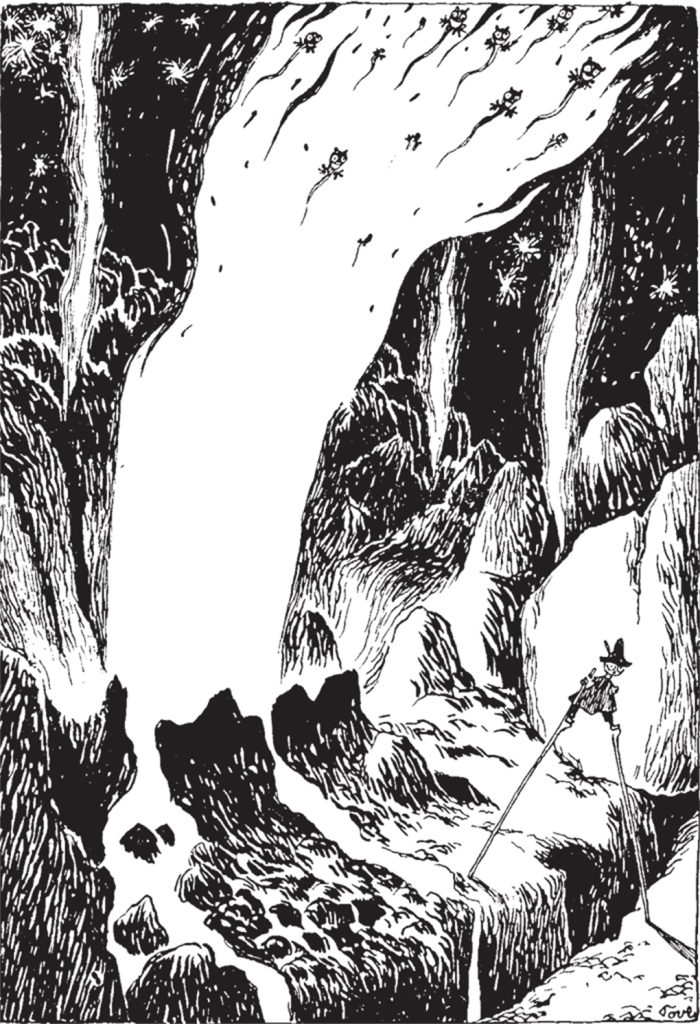 From Comet in Moominland. ©the estate of Tove Jansson
From Comet in Moominland. ©the estate of Tove Jansson
Jansson illustrated the Moomin stories herself, and her pen-and-ink drawings are some of the best things about the books. The illustrations for the first book in the series, Comet in Moominland, are especially striking; some of them are a cross between a kind of nightmare Lovecraftian landscape and the surreal imagery of William Hope Hodgson’s The Night Land.
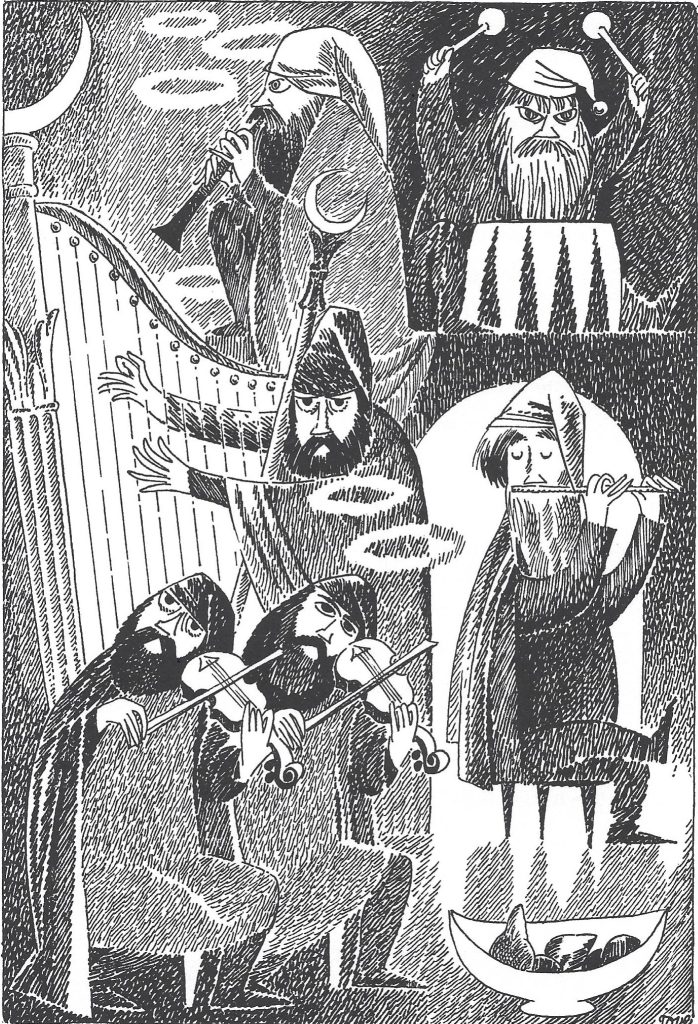 The Dwarves. ©the estate of Tove Jansson
The Dwarves. ©the estate of Tove Jansson
Though I’ve steadily been working my way through the Moomin books, I wasn’t aware until I had the Finnish Hobitti in my hands that Jansson had illustrated anyone else’s work. One look at her gorgeous cover illustration made me glad that she did. (There will always be a special place in my heart for a rampaging dragon.)
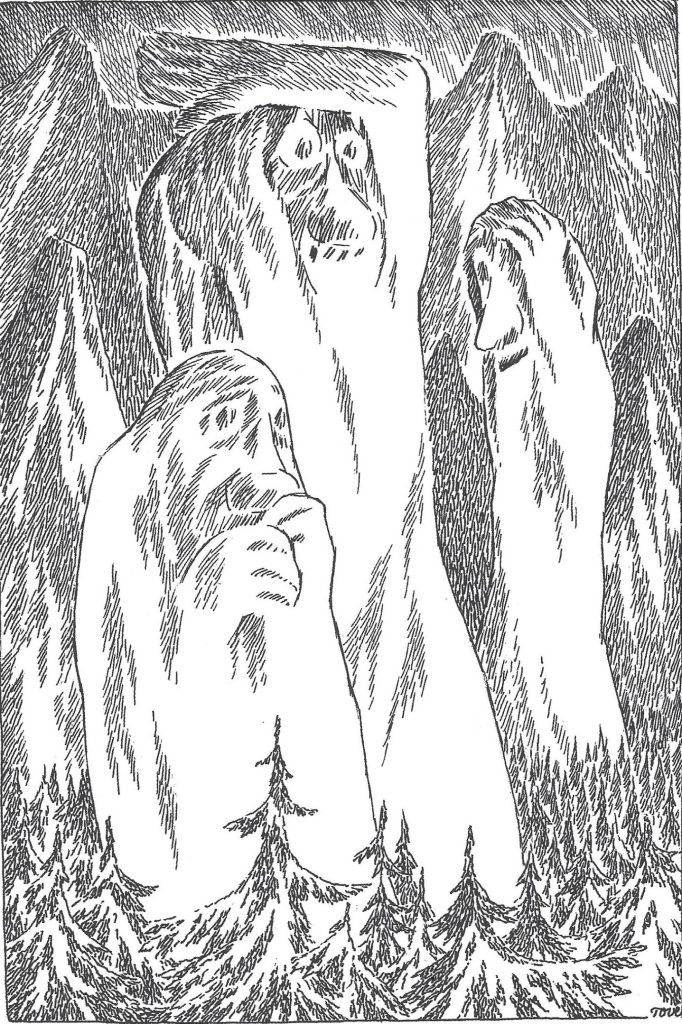 The Trolls. ©the estate of Tove Jansson
The Trolls. ©the estate of Tove Jansson
Jansson did her Hobbit illustrations for a 1962 Swedish edition (she was a member of Finland’s Swedish-speaking minority community) and they are refreshingly different from the more realistic renderings of Middle-earth and its inhabitants that are common today. She did twelve full-page black-and-white drawings for the book, another ten that cover half to a third of a page, and many smaller drawings that decorate the beginning or end of chapters.
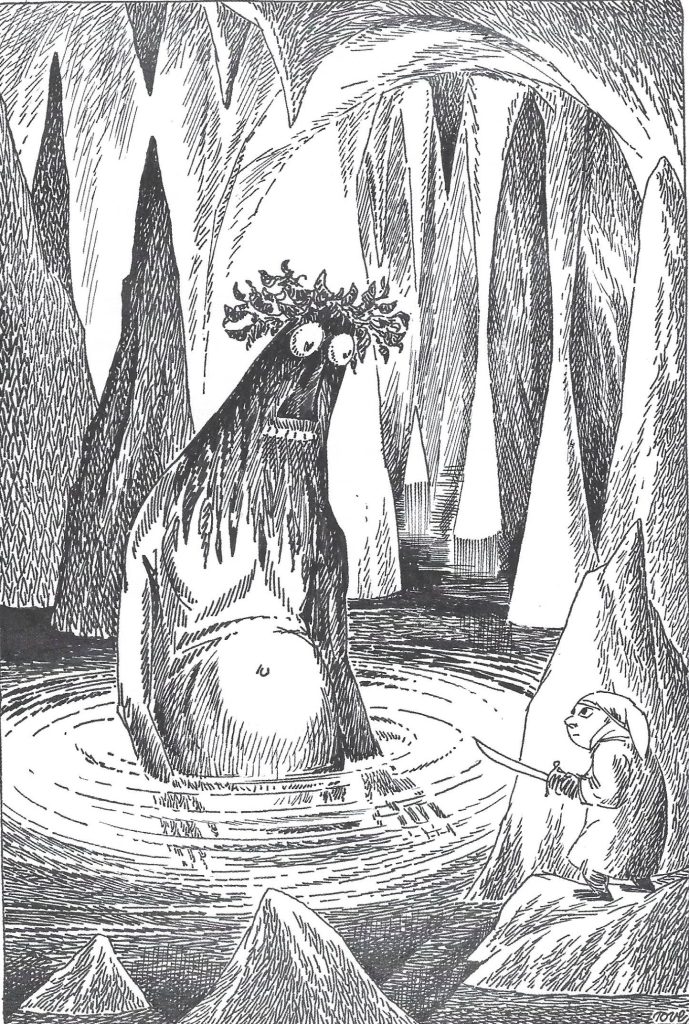 Bilbo and Gollum. ©the estate of Tove Jansson
Bilbo and Gollum. ©the estate of Tove Jansson
One thing that will immediately stand out to any Tolkien lover who flips through Jansson’s Hobitti is her visualization of Gollum. In Jansson’s drawings he’s huge, towering over Bilbo, and when Tolkien saw these illustrations, he supposedly realized that he had never specified exactly how large the slimy creature was, and so made the appropriate corrections for the Hobbit’s next edition, cutting Bilbo’s antagonist down to size.
 The Wargs. ©the estate of Tove Jansson
The Wargs. ©the estate of Tove Jansson
Jansson’s Tolkien illustrations are all her own; they’re not like any other rendition of Middle-earth that I can think of, and in comparing these wonderful pictures with more current ones, you can glimpse an older tradition, one that has its roots in the “North” that Tolkien loved, one that goes back to the sagas and Norse eddas that gave him his inspiration.
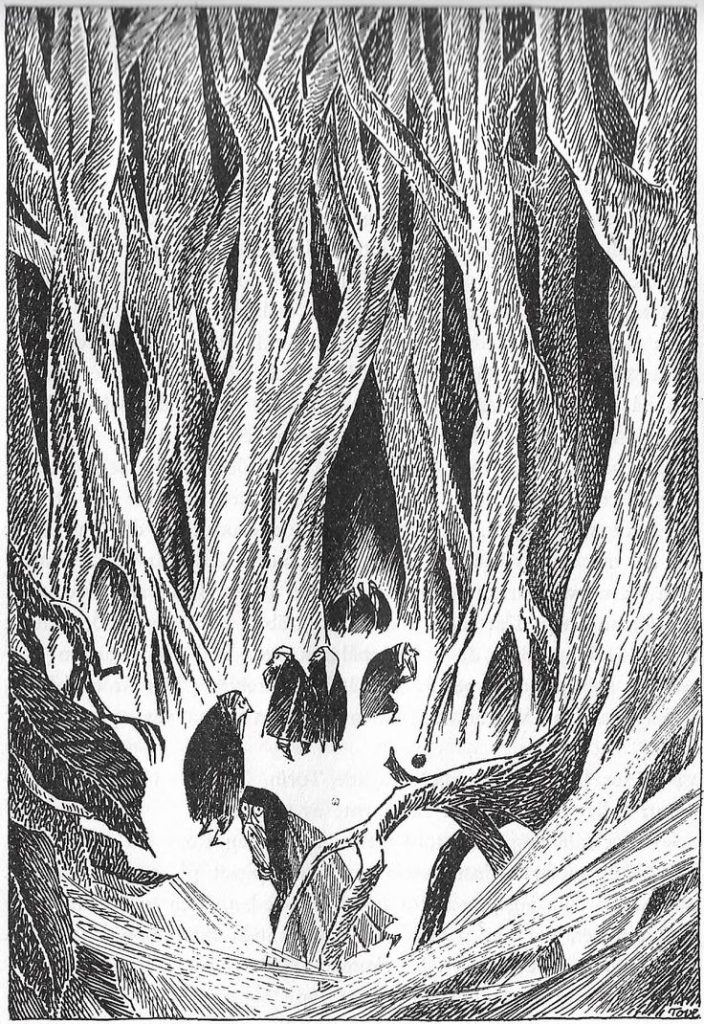 Mirkwood. ©the estate of Tove Jansson
Mirkwood. ©the estate of Tove Jansson
These simple-looking illustrations may not be to the taste of folks raised on fantasy photorealism (of course, in the hands of a true artist, there are few things deeper and more nuanced than simplicity), but I love them; their bold, expressionist lines combine the weird and the whimsical, the humorous and the beautiful, all with echoes of the heroic and the epic. I think Tove Jansson was a perfect match for Tolkien and his world.
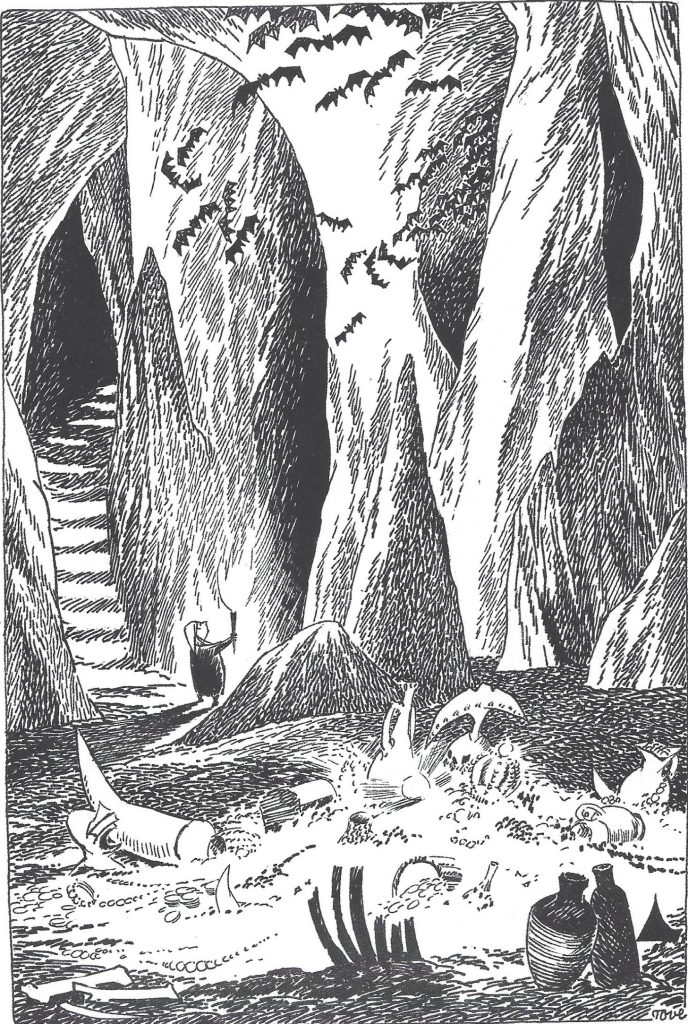 Smaug’s Treasure. ©the estate of Tove Jansson
Smaug’s Treasure. ©the estate of Tove Jansson
Just the other day I found out that Jansson did illustrations for Lewis Carrol’s Alice’s Adventures in Wonderland; NYRB Classics has just published a new edition featuring her drawings. Seeing what sparks Carrol’s story struck from Jansson is a rabbit hole I can’t wait to go down.
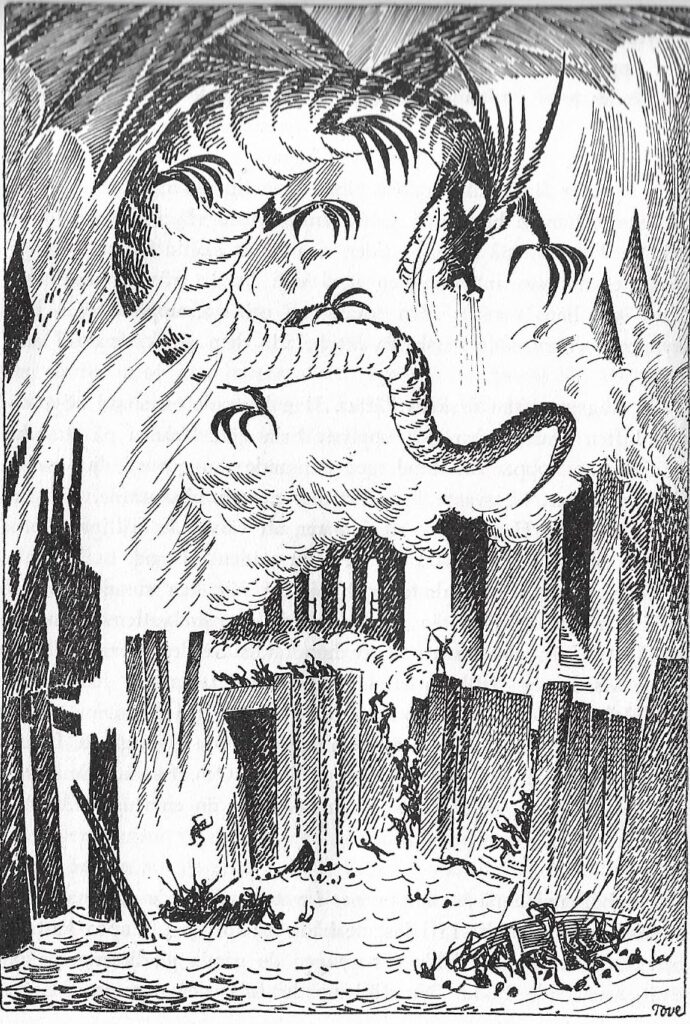 Smaug destroys Lake-Town. ©the estate of Tove Jansson
Smaug destroys Lake-Town. ©the estate of Tove Jansson
Until I can report back on Jansson’s Alice, I commend her Hobitti to you (her Moomin books, too), and I leave you with this:
Kaikki asekuntoiset ihmismiehet ja suurin osa haltiakuninkaan joukoista valmistautuivat marssimaan pohjoiseen Vuorta kohti. (What does that mean? I dunno, but it comes at the end of chapter Tulta Ja Vettä.)
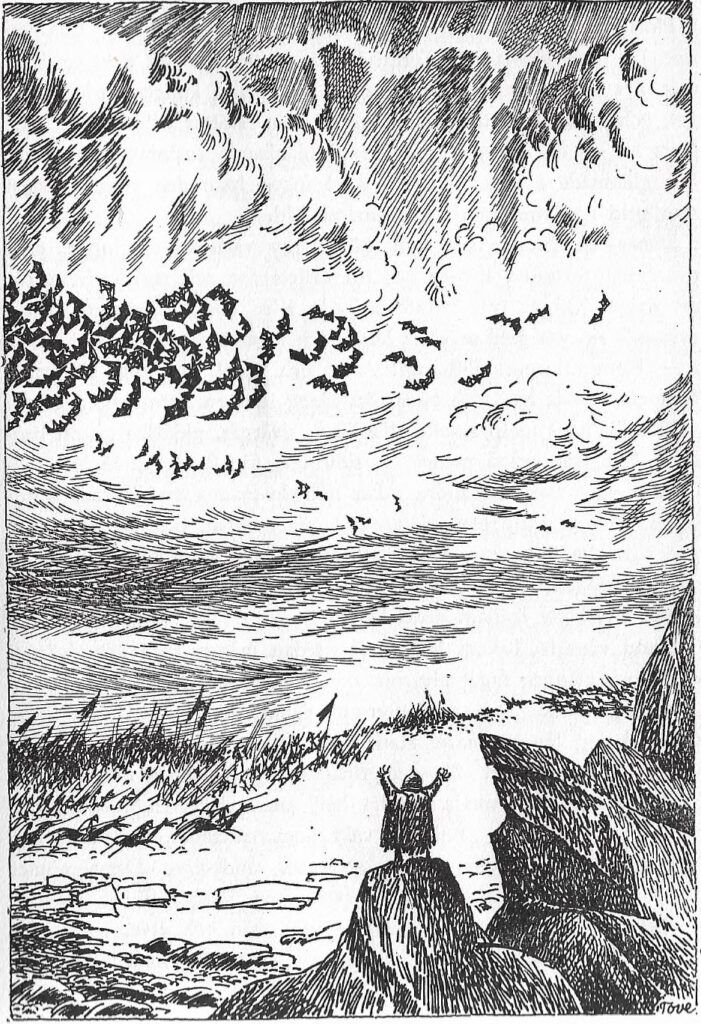 The Battle of Five Armies. ©the estate of Tove Jansson
The Battle of Five Armies. ©the estate of Tove Jansson
Thomas Parker is a native Southern Californian and a lifelong science fiction, fantasy, and mystery fan. When not corrupting the next generation as a fourth grade teacher, he collects Roger Corman movies, Silver Age comic books, Ace doubles, and despairing looks from his wife. His last article for us was The Lost World
Nosferatu: Was It the Time Change What Killed The Beast?
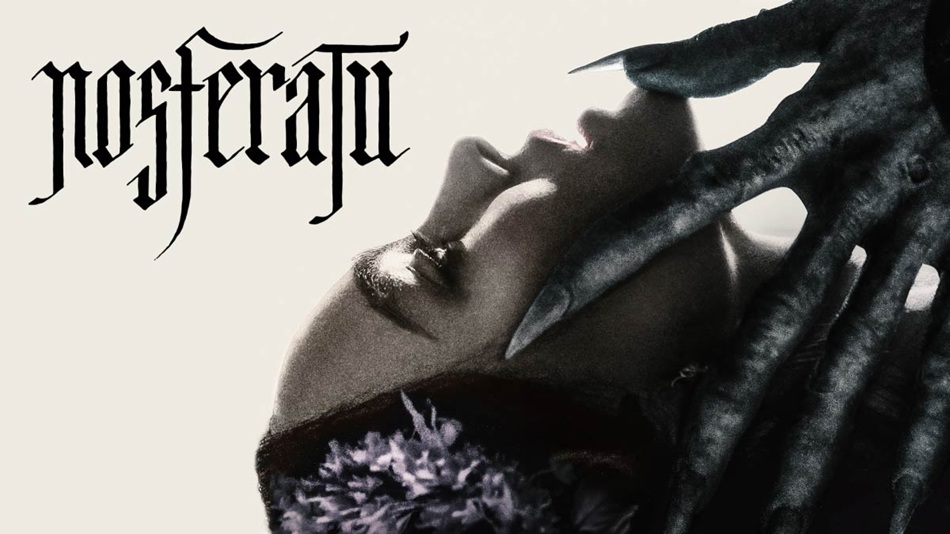 Nosferatu, written and directed by Robert Eggers, based on Nosferatu: A Symphony of Horror (1922), written by Henrik Galeen, and Dracula, penned by Bram Stoker in 1897.
Reboots and Adaptations
Nosferatu, written and directed by Robert Eggers, based on Nosferatu: A Symphony of Horror (1922), written by Henrik Galeen, and Dracula, penned by Bram Stoker in 1897.
Reboots and Adaptations
Okay. So I finally got around to watching Eggers’ version of FW Murnau’s classic from 1922, Nosferatu: A Symphony of Horror. By now, I think everyone knows the story behind FW Murnau’s Nosferatu, but here’s a brief summary: Murnau’s Nosferatu was an unauthorized adaptation of Bram Stoker’s Dracula, changing character names and locations but retaining the core plot elements. The film, which originally claimed to be adapted from Stoker’s novel, was made to avoid copyright issues and was eventually subject to legal action that nearly destroyed all prints.
Despite the name changes and some alterations, the film’s narrative largely follows Dracula’s journey, with the protagonist, Count Orlok (instead of Dracula), traveling to a new land — Romania to Germany, instead of Transylvania to England — and spreading a plague. Eggers’ reboot is definitely well made and impressive, and it has an other-worldly feel to it. It’s different from other vampire films. That being said, the original silent version is way creepier.
Now, allow me to digress for a paragraph or so. In 1979, there was a remake of the film — Nosferatu the Vampyre, known in Germany as Nosferatu: Phantom of the Night — directed by Werner Herzog and starring Klaus Kinski as Count Dracula. Yes, all Stoker’s character names were used in this film version. Not a bad film, but a bit anemic, you should pardon the pun. There’s also a fun flick from 2000 called Shadow of the Vampire, a fictional telling of the making of the silent Nosferatu, in which Willem Dafoe (who also has a role in Eggers’ version) stars as Max Schreck, the real name of the actor who first played Nosferatu. The twist is this: Max Schreck is a real vampire — a vampire playing a human actor who’s playing a vampire. (Sort of a Victor/Victoria, with blood.) Now where was I? Oh, yeah.
Expect SexFirst off… yes, sex is at the heart of Eggers’ Nosferatu. Sex is at the heart of Stoker’s novel, which was written in the sexually repressed Victorian Era. Sex plays a part in almost every vampire film I’ve ever seen. Francis Ford Coppola’s Bram Stoker’s Dracula (1992), for example, is loaded with sex and nudity, like the Three Brides feeding on Keanu Reeves, one of whom is Monica Bellucci. There’s also a wild scene between Dracula (Gary Oldman), in wolf manifestation, humping Lucy Westenra (Sadie Frost.) Then there’s the love scene between Mina Harker (Winona Ryder) and Dracula, where she licks his blood off his chest.
So there’s nothing new on the sexual theme and subtext of this latest version of Nosferatu. In fact, Nosferatu owes a lot to Coppola’s Dracula, a film I am quite fond of, in spite of some cringe-worthy acting, dialog and miscasting. Gary Oldman was fantastic; he owns that role and that film, just as Lily-Rose Depp, the real star of Nosferatu, owns this film. I’ll come back to her.
AtmosphereEggers’ Nosferatu owes a lot to Coppola’s Dracula in its use of shadows and some “camera tricks.” It also boasts some exquisite scenery and set design, which convey the ideal atmosphere for the story. The cinematography by Jarin Blaschke is masterful, the film score by Robin Carolan is spot on, and there are some haunting audio FX that add to the grimness of this film. The script pretty much follows the plot of the original screenplay by Henrik Galeen, but doesn’t owe much to Bram Stoker, other than his novel being the inspiration for the original, silent film.
I found this extended version to be a bit — (a bite?) — too long (in the tooth?) because it was almost deadly-dull at times. It moved as slowly as a corpse first waking up as one of the Walking Dead. The film spent too much time on mood and set up, and the first two acts I found to be somewhat tedious and boring. Not enough was happening! I did not find it at all exciting. It was like watching a pair of heroin addicts playing chess. The third act picked up some energy, but by then I was yawning. The plague of rats was pretty cool, though. There are a lot of rats in this film. I mean, a lot of rats.
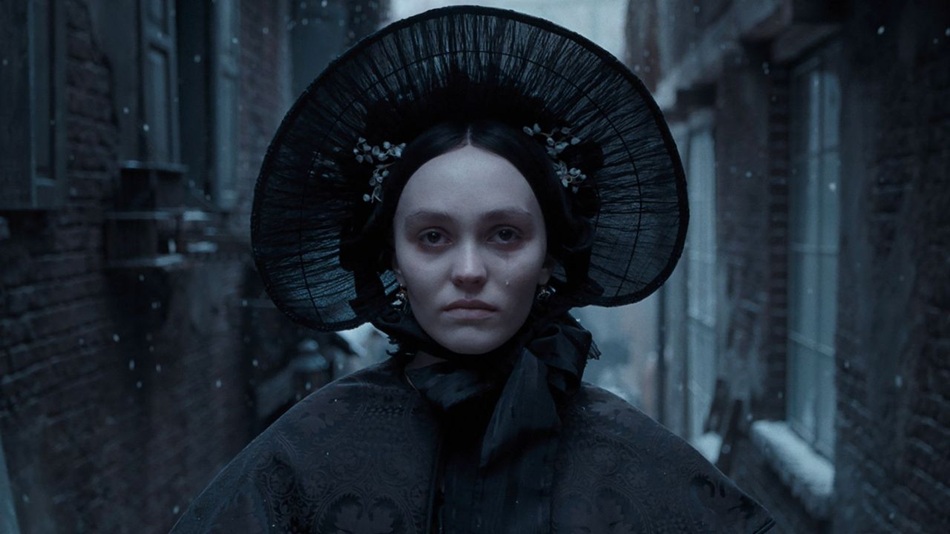 Lily Rose from Nosferatu 2024
Casting
Lily Rose from Nosferatu 2024
Casting
The cast was capable but not exceptional. They did their jobs and they did well enough. Willem Dafoe did a stand-up job, however, and in only one brief scene does he go over the top. I just couldn’t get emotionally attached or involved with any of the characters — except for Lily-Rose Depp. This is her film and she totally owns it. Her performance as Ellen Hutter (Mina Harker, in Stoker’s novel) is powerful and spot-on in every scene. She nails it and steals the show. She is put through the emotional ringer in this film — loving, angelic, quirky, possessed, demonic — you name it, she throws it all up there on the screen. She blew me away with a solid, heroic performance that was never over-the-top. She was brilliant. Her self-sacrifice in the final act is a powerful scene, and a sad one, as well.
As for the two kids who play the children of Anna Harding and Frederich Harding (Emma Corrin and Aaron Taylor-Johnson) I found them to be as annoying as a blister on the tip of my big toe, and when Nosferatu feeds on them, I cheered him on. It’s a brief, darkly-lit scene that quickly shift’s to Anna who sees her children being devoured, and the look on her face and her scream of horror, followed by her final fate, is chilling. That was a good bit. As for Bill Skarsgård, the other major player in Nosferatu and the title character…
I’m a fan. I’ve enjoyed his work in such films as John Wick, The Crow, and as Pennywise in the theatrical version of Stephen King’s IT — a feat of acting that, considering Tim Curry’s wonderful Pennywise, I applauded because he made the role his own: his Pennywise was the only good thing about that version of King’s novel.
But as for his take as Nosferatu… it didn’t work for me at all. I did not care for the make-up or the way he portrayed the character. There was nothing “supernatural” about him. He was just a force of evil, more like a big, hulking brute… and maybe that’s what Eggers wanted. I know The Last Voyage of the Demeter was not very well received, but I enjoyed that film and got a genuine sense of Dracula as being demonic, sorcerous, powerful, and evil. I didn’t get any sense of what Nosferatu felt for Ellen (Mina), no lost love, no real idea of why he wanted her, nothing about her being the reincarnation of a lost love. He says something about her not being of this world, of not being human or belonging to the living world — whatever. I must have missed something about how they were connected, but I’m not going back to “watch again,” at least not for the time being.
When Skarsgård’s dialog was in Romanian, it was subtitled in English. But when he spoke English, his accent was very difficult for me to understand. I was like, “What the hell is he talking about?” I kept expecting the villagers from Young Frankenstein to show up and shout in unison: WHAT?
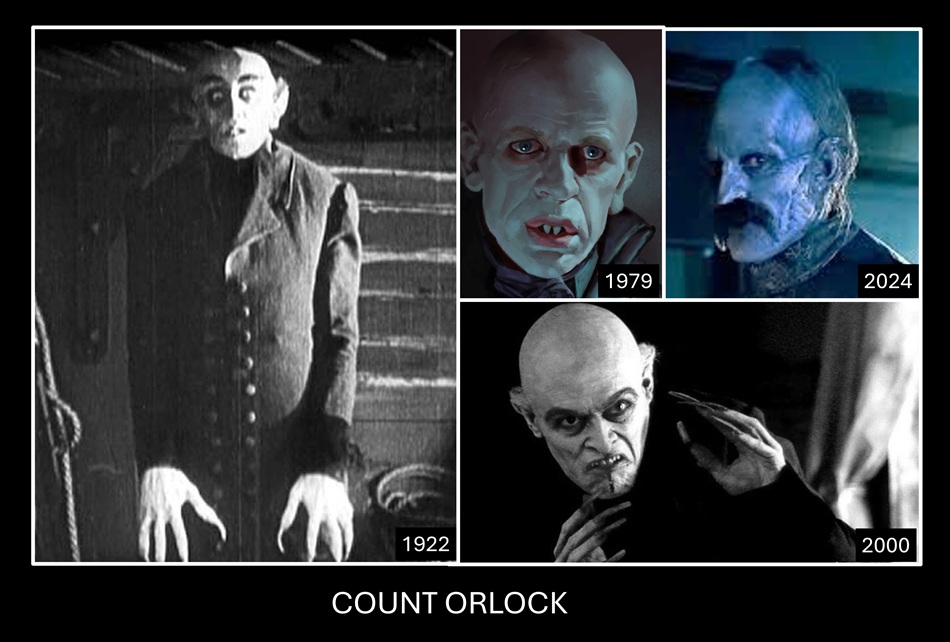 1922 MAX SCHRECK Nosferatu; 1979 KLAUS KINSKI Nosferatu the Vampyre; 2000 WILLEM DAFOE Shadow of the Vampire; 2024 Bill Skarsgård Nosferatu
Omnipotent Vampire Ignores Chicken, Dies
1922 MAX SCHRECK Nosferatu; 1979 KLAUS KINSKI Nosferatu the Vampyre; 2000 WILLEM DAFOE Shadow of the Vampire; 2024 Bill Skarsgård Nosferatu
Omnipotent Vampire Ignores Chicken, Dies
Now, here’s the problem I always had with the original version of Nosferatu, and with this one, too. I find it funny that an ancient, demonic, powerful vampire could become so besotted with blood and sex that he doesn’t see the sun rising and doesn’t pay attention to the cock’s first crowing. By the time of the second crowing, it’s too late. Didn’t he see or feel the sunlight shining through that honking-big window? Did he leave his watch at home? Did he forget about the time change? Or… maybe he knew that there was nowhere he could run and hide, because the coffin(s) full of his native soil had been destroyed. Or was this his fate, his desire — to perish in the arms of Ellen Hutter? I think that was it, because he could have let anyone destroy him at any time, if he wanted death and oblivion, but he wanted her to be his doom, he wanted to take her with him, to be with him forever in death. But what do I know? I’m not a real film critic. I’m just hear to entertain you Black Gate readers.
Check Out My DisappointmentI do not hate or dislike this version of Nosferatu. I am just disappointed in it. All the hype about this film, the word-of-mouth, gave me expectations of something I imagined would be a revelation, a landmark in moving pictures and vampire flicks in general. Thus, not getting what I expected, I was disappointed. It happens. And that’s on me. But if you haven’t seen the film, don’t let my review stop you from doing so. Check it out. You might like it. I’m sure I’ll watch the film again. Maybe it will grow on me. There are many favorite films I did not enjoy on first viewing, and vice versa, too. Anyway, Nosferatu was a big hit, it’s popular and made lots of $$$$$, so that should tell you something. One thing I do know… Lily-Rose Depp is going to have one helluva fine film career. I look forward to seeing her in more films.
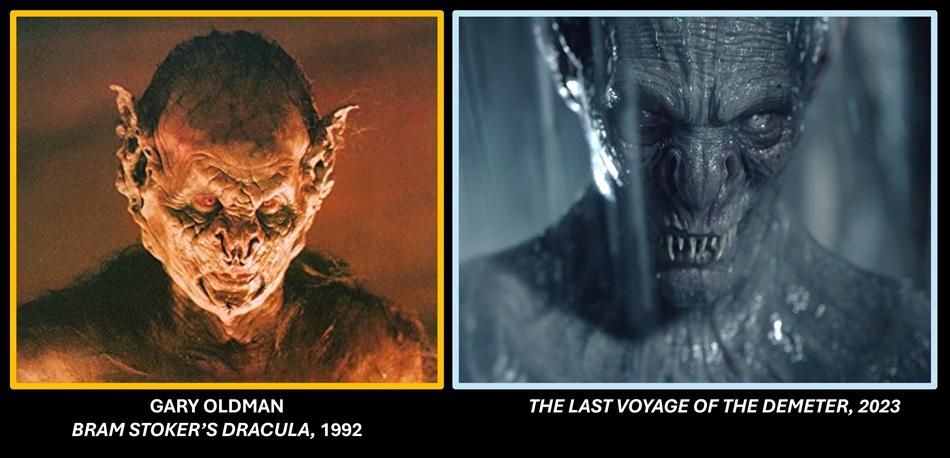 Left: GARY OLDMAN – BRAM STOKER’S DRACULA, 1992 Right: THE LAST VOYAGE OF THE DEMETER, 2023
Left: GARY OLDMAN – BRAM STOKER’S DRACULA, 1992 Right: THE LAST VOYAGE OF THE DEMETER, 2023
Joe Bonadonna is the author of the heroic fantasies Mad Shadows — Book One: The Weird Tales of Dorgo the Dowser(winner of the 2017 Golden Book Readers’ Choice Award for Fantasy); Mad Shadows — Book Two: The Order of the Serpent; Mad Shadows — Book Three: The Heroes of Echo Gate; the space operaThree Against the Stars and its sequel, the sword and planet space adventure, The MechMen of Canis-9; and the sword & sorcery pirate novel, Waters of Darkness, in collaboration with David C. Smith. With co-writer Erika M Szabo, he penned Three Ghosts in a Black Pumpkin (winner of the 2017 Golden Books Judge’s Choice Award for Children’s Fantasy), and its sequel, The Power of the Sapphire Wand.
He also has stories appearing in: Azieran: Artifacts and Relics; Savage Realms Monthly (March 2022); Griots 2: Sisters of the Spear; Heroika I: Dragon Eaters; Poets in Hell; Doctors in Hell; Pirates in Hell; Lovers in Hell; Mystics in Hell; Liars in Hell; Sinbad: The New Voyages, Volume 4; Unbreakable Ink; Poetry for Peace; the shared-world anthology Sha’Daa: Toys, in collaboration with author Shebat Legion; and with David C. Smith for the shared-universe anthology, The Lost Empire of Sol.
In addition to his fiction, Joe has written numerous articles, book reviews and author interviews for Black Gate online magazine.






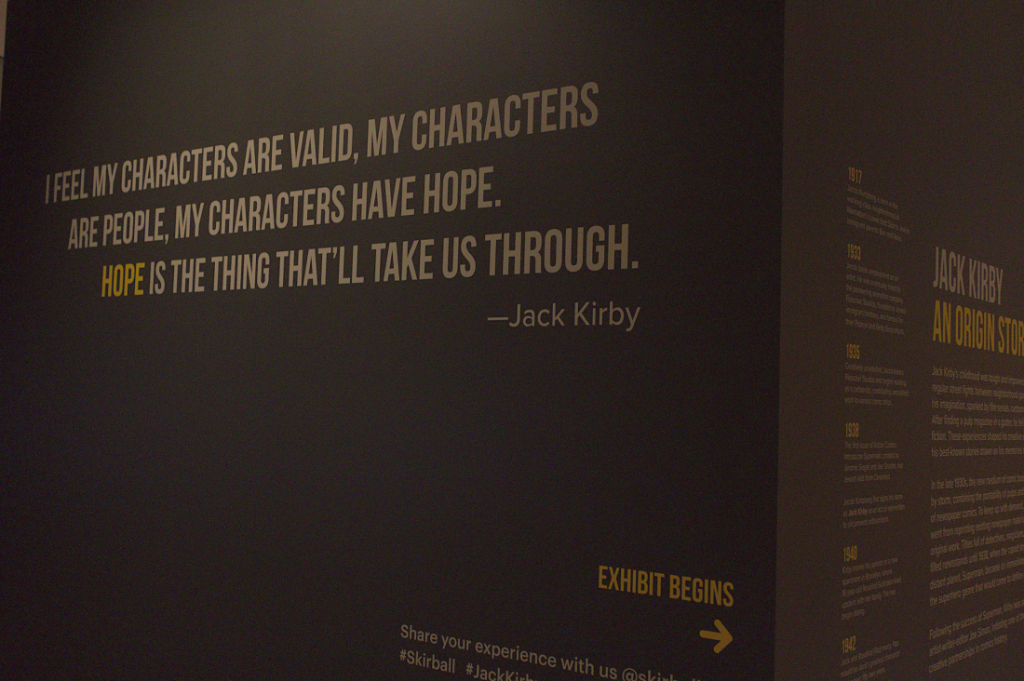

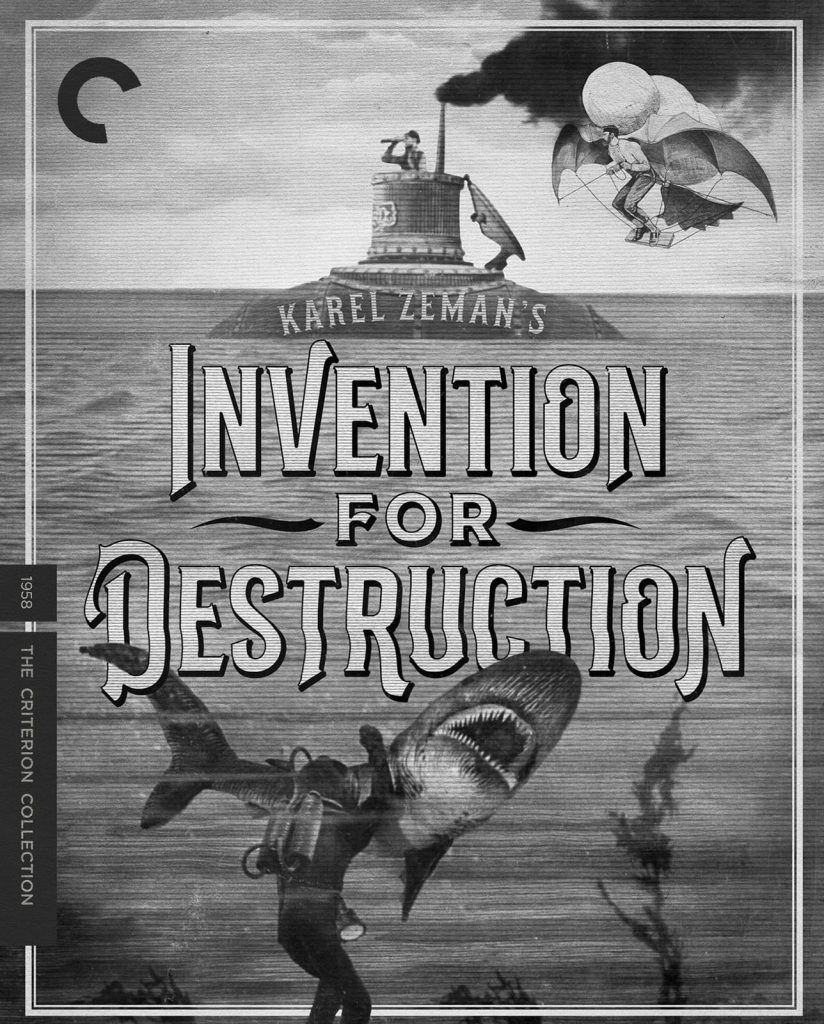
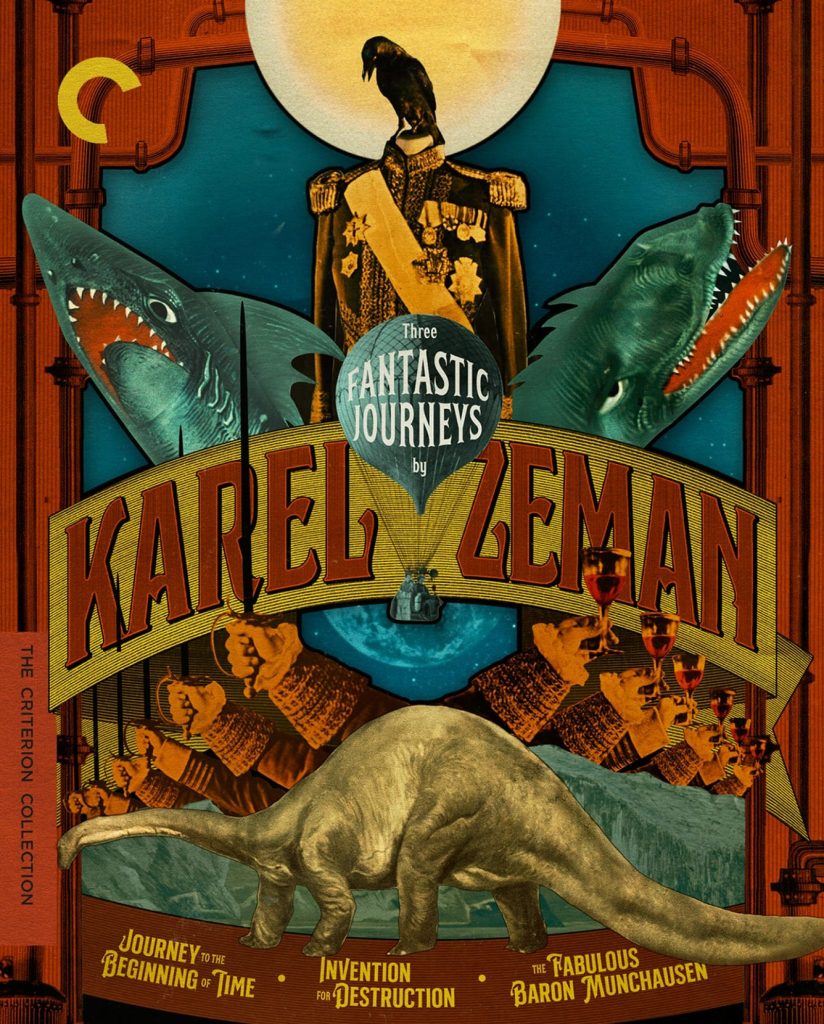
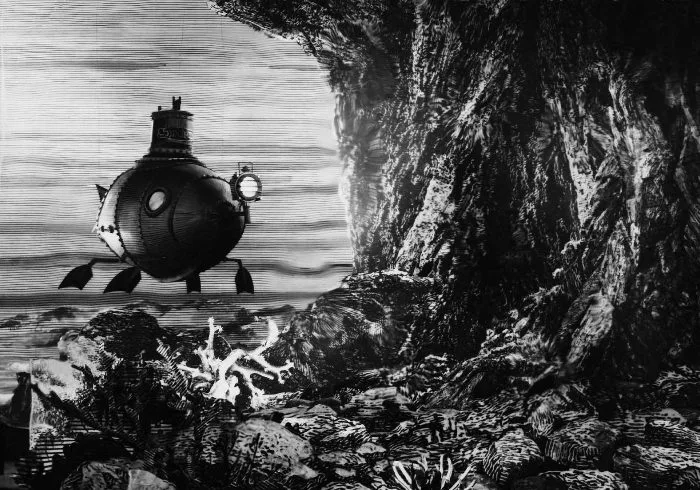
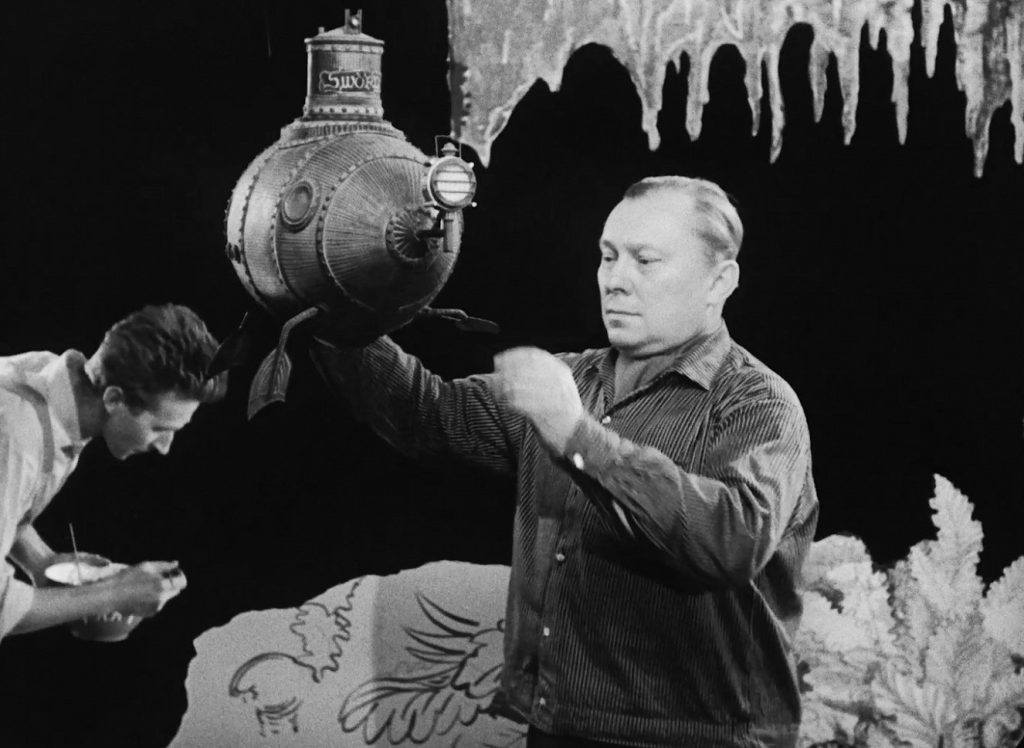
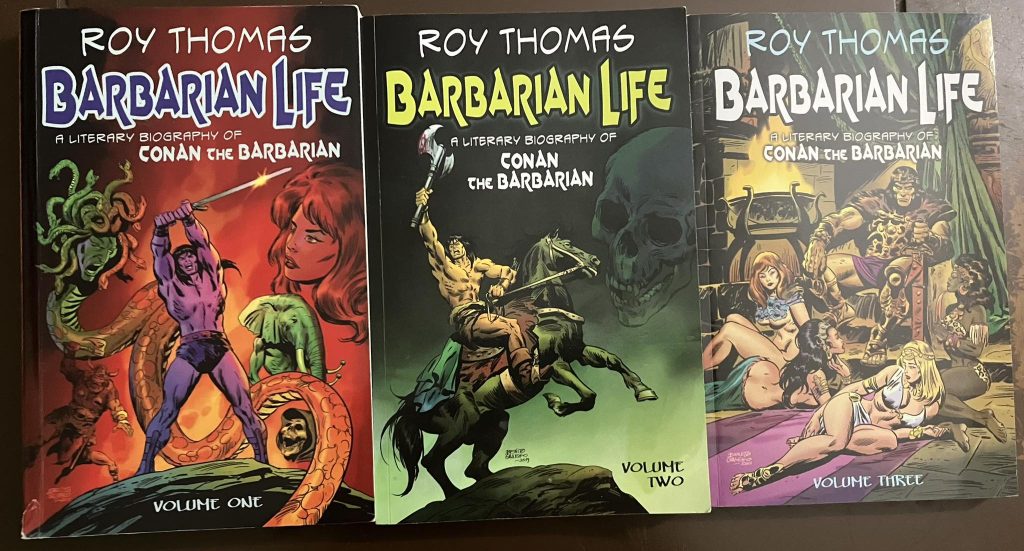
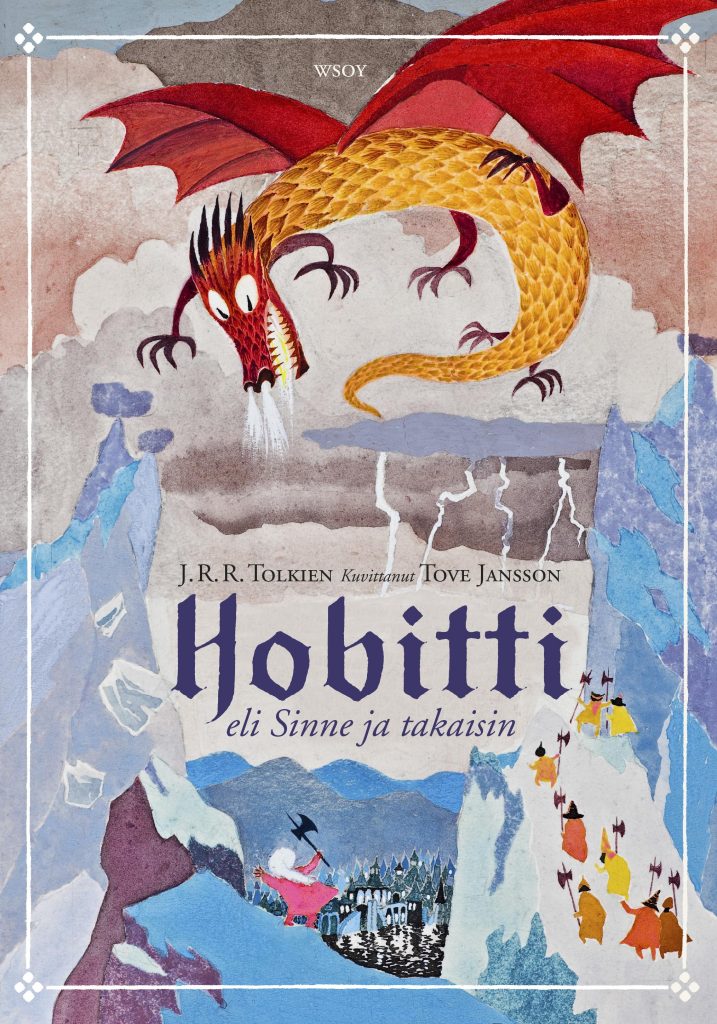
Recent comments